
“What a day it was when I first became a herdsman of ducks!”
The Project Gutenberg EBook of Insect Adventures, by
J. Henri Fabre and Louise Seymour Hasbrouck
This eBook is for the use of anyone anywhere at no cost and with
almost no restrictions whatsoever. You may copy it, give it away or
re-use it under the terms of the Project Gutenberg License included
with this eBook or online at www.gutenberg.org
Title: Insect Adventures
Author: J. Henri Fabre
Louise Seymour Hasbrouck
Illustrator: Elias Goldberg
Release Date: May 29, 2014 [EBook #45812]
Language: English
Character set encoding: UTF-8
*** START OF THIS PROJECT GUTENBERG EBOOK INSECT ADVENTURES ***
Produced by Chris Curnow, Jennifer Linklater and the Online
Distributed Proofreading Team at http://www.pgdp.net (This
file was produced from images generously made available
by The Internet Archive)
INSECT ADVENTURES
Petty truths, I shall be told, those presented by the habits of a spider or a grasshopper. There are no petty truths today; there is but one truth, whose looking-glass to our uncertain eyes seems broken, though its every fragment, whether reflecting the evolution of a planet or the flight of a bee, contains the supreme law. Maurice Maeterlinck

“What a day it was when I first became a herdsman of ducks!”
Selections from Alexander Teixeira de Mattos’ Translation of Fabre’s “Souvenirs Entomologiques”
RETOLD FOR YOUNG PEOPLE
BY
LOUISE SEYMOUR HASBROUCK
ILLUSTRATED BY
ELIAS GOLDBERG

NEW YORK
DODD, MEAD AND COMPANY
1917
COPYRIGHT, 1917,
By DODD, MEAD & COMPANY, Inc.
Jean Henri Fabre, author of the long series of “Souvenirs Entomologiques” from which these studies are taken, was a French school-teacher and scientist whose peculiar gift for the observation and description of insect life won for him the title of the “insects’ Homer.” A distinguished English critic says of him, “Fabre is the wisest man, and the best read in the book of nature, of whom the centuries have left us any record.” The fact that he was mainly self-taught, and that his life was an unending struggle with poverty and disappointment, increases our admiration for his wonderful achievements in natural science.
A very interesting account of his early years, given by himself, will be found in Chapter XVII of this volume. The salaries of rural teachers and professors were extremely small in France during the last century, and Fabre, who married young, could barely support his large family. Nature study was not in the school curriculum, and it was years before he could devote more than scanty spare hours to the work. At the age of thirty-two, however, he published the first volume of his insect studies. It attracted the attention of scientists and brought him a prize from the French Institute. Other volumes were published from time to time, but some of Fabre’s fellow scientists were displeased because the books were too interesting! They feared, said Fabre, “lest a page that is read without fatigue should not always be the expression of the truth.” He defended himself from this extraordinary complaint in a characteristic way.
“Come here, one and all of you,” he addressed his friends, the insects. “You, the sting-bearers, and you, the wing-cased armor-clads—take up my defense and bear witness in my favor. Tell of the intimate terms on which I live with you, of the patience with which I observe you, of the care with which I record your actions. Your evidence is unanimous; yes, my pages, though they bristle not with hollow formulas or learned smatterings, are the exact narrative of facts observed, neither more nor less; and whoso cares to question you in his turn will obtain the same replies.
“And then, my dear insects, if you cannot convince these good people, because you do not carry the weight of tedium, I, in my turn, will say to them:
“‘You rip up the animal and I study it alive; you turn it into an object of horror and pity, whereas I cause it to be loved; you labor in a torture-chamber and dissecting-room, I make my observation under the blue sky to the song of the cicadas; you subject cell and protoplasm to chemical tests, I study instinct in its loftiest manifestations; you pry into death, I pry into life.... I write above all for the young. I want to make them love the natural history which you make them hate; and that is why, while keeping strictly in the domain of truth, I avoid your scientific prose, which too often, alas, seems borrowed from some Iroquois idiom.’”
Fabre, though an inspiring teacher, had no talent for pushing himself, and did not advance beyond an assistant professorship at a tiny salary. The other professors at Avignon, where he taught for twenty years, were jealous of him because his lectures on natural history attracted much attention, and nicknamed him “the Fly.” He was turned out of his house at short notice because the owners, two maiden ladies, had been influenced by his enemies, who considered his teachings in natural history irreligious. Many years later, the invaluable textbooks he had written were discontinued from use in the schools because they contained too much religion! A process which he invented for the extraction of dye from madder flowers, by which he hoped to make himself independent, proved unprofitable on account of the appearance on the market of the cheaper aniline dyes.
Though unknown during most of his lifetime to the world at large, Fabre through his writings gained the friendship of several celebrated men. Charles Darwin called him the “incomparable observer.” The Minister of Education in France invited him to Paris and had him made a Chevalier of the Legion of Honor, and presented him to the Emperor, Napoleon III. He was offered the post of tutor to the Prince Imperial, but preferred his country life and original researches, even though they meant continued poverty.
At last, after forty years of drudgery, Fabre secured from his textbooks a small independent income, which released him from teaching and enabled him to buy at Serignan a house and garden of his own, and a small piece of waste ground, dedicated to thistles and insects—a “cursed ground,” he wrote, “which no one would have as a gift to sow with a pinch of turnip seed,” but “an earthly paradise for bees and wasps”—and, on that account, for him also.
“It is a little late, O my pretty insects,” he adds—he was at this time over sixty; “I greatly fear the peach is offered to me only when I am beginning to have no teeth wherewith to eat it.” He lived, however, to spend many years at his chosen studies.
During the last years of his life his fame spread, and in 1910, in his eighty-eighth year, some of his admirers arranged a jubilee celebration for him at Serignan. Many famous men attended, and letters and telegrams poured in from all parts of the world. He died five years later, at the age of ninety-two.
CHAPTER
INSECT ADVENTURES
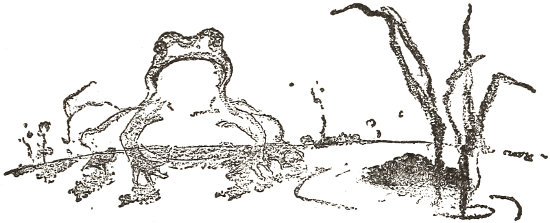
I am never tired of looking in a pond. What busy life there is in that green world! On the warm mud of the edges, the Frog’s little Tadpole basks and frisks in its black legions; down in the water, the orange-bellied Newt steers his way slowly with the broad rudder of his flat tail; among the reeds are stationed the little fleets of the Caddis-worms, half-protruding from their tubes, which are now a tiny bit of stick and again a tower of little shells.
In the deep places, the Water-beetle dives, carrying with him his extra supply of breath, an air-bubble at the tip of the wing-cases and, under the chest, a film of gas that gleams like a silver breast plate; on the surface, the ballet of those shimmering pearls, the Whirligigs, turns and twists about; hard by, there swims the troop of the Pond-skaters, who glide along with side-strokes like those which the cobbler makes when sewing.
Here are the Water-boatmen, who swim on their backs with two oars spread crosswise, and the flat Water-scorpions; here, clad in mud, is the grub of the largest of our Dragon-flies, so curious because of its manner of moving: it fills its hinder parts, a yawning funnel, with water, spirts it out again and advances just so far as the recoil of its water cannon.
There are plenty of peaceful Shellfish. At the bottom, the plump River-snails discreetly raise their lid, opening ever so little the shutters of their dwelling; on the level of the water, in the glades of the water-garden, the Pond-snails take the air. Dark Leeches writhe upon their prey, a chunk of Earthworm; thousands of tiny, reddish grubs, future Mosquitoes, go spinning around and twist and curve like so many graceful Dolphins.
Yes, a stagnant pool, though but a few feet wide, hatched by the sun, is an immense world, a marvel to the child who, tired of his paper boat, amuses himself by noticing what is happening in the water. Let me tell what I remember of my first pond, which I explored when I was seven years old.
We had nothing but the little house inherited by my mother, and its patch of garden. Our money was almost all gone. What was to be done? That was the stern question which father and mother sat talking over one evening.
Do you remember Hop-o’-My-Thumb, who hid under the wood-cutter’s stool and listened to his parents overcome by want? I was like him. I also listened, pretending to sleep, with my elbows on the table. It was not blood-curdling designs that I heard but grand plans that set my heart rejoicing.
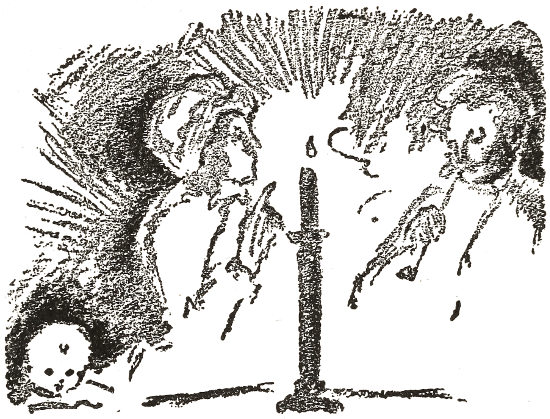
“Suppose we breed some ducks,” says mother. “They sell very well in town. Henri would mind them and take them down to the brook. And we could feed them on the grease from the tallow-factory, which they say is excellent for ducks, and which we could buy for a small price.”
“Very well,” says father, “let’s breed some ducks. There may be difficulties in the way; but we’ll have a try.”
That night I had dreams of paradise: I was with my ducklings, clad in their yellow suits; I took them to the pond, I watched them have their bath, I brought them back again, carrying the more tired ones in a basket.
A month or two after the little birds of my dreams were a reality. There were twenty-four of them. They had been hatched by two hens, of whom one, the big black one, was an inmate of the house, while the other was borrowed from a neighbor.
To bring them up, the big, black hen is enough, so careful is she of her adopted family. At first everything goes perfectly: a tub with two fingers’ depth of water serves as a pond. On sunny days the ducklings bathe in it under the anxious eye of the hen.
Two weeks later, the tub no longer satisfies. It contains neither cresses crammed with tiny Shellfish nor Worms and Tadpoles, dainty morsels both. The time has come for dives and hunts among the tangle of the water-weeds; and for us the day of trouble has also come. How are we, right up at the top of the hill, to get water enough for a pond for our broods? In summer, we have hardly water to drink!
Near the house there is only a scanty spring from which four or five families besides ourselves draw their water with copper pails. By the time that the schoolmasters donkey has quenched her thirst and the neighbors have taken their provision for the day, the spring-basin is dry. We have to wait four-and-twenty hours for it to fill. No, there is no place there for ducklings.
There is a brook at the foot of the hill, but to go down to it with the troop of ducklings is dangerous. On the way through the village we might meet murdering cats, or some surly dog might frighten and scatter the little band; and it would be a puzzling task to collect them all again. But there is still another spot, part way up the hill, where there is a meadow and a pond of some size. It is very quiet there, and the place can be reached by a deserted footpath. The ducklings will be well off.
What a day it was when I first became a herdsman of ducks! Why must there be a drawback to such joys? Walking on the hard stones had given me a large and painful blister on the heel. If I had wanted to put on the shoes stowed away in the cupboard for Sundays and holidays, I could not. I had to go barefoot over the broken stones, dragging my leg and carrying high the injured heel.
The ducks, too, poor little things, had sensitive soles to their feet; they limped, they quacked with fatigue. They would have refused to go any farther towards the pond if I had not, from time to time, called a halt under the shelter of an ash.

We are there at last. The place could not be better for my birdlets: shallow, tepid water, with a few muddy knolls and little green islands. The pleasures of the bath begin at once. The ducklings clap their beaks and rummage here, there, and everywhere; they sift each mouthful, throwing out the clear water and swallowing the good bits. In the deeper parts they point their tails into the air and stick their heads under water. They are happy: and it is a blessed thing to see them at work. I too am enjoying the pond.
What is this? On the mud lie some loose, knotted, soot-covered cords. One might take them for threads of wool like those which you pull out of an old ravelly stocking. Can some shepherdess, knitting a black sock and finding her work turn out badly, have begun all over again and, in her impatience, have thrown down the wool with all the dropped stitches? It really looks like it.
I take up one of those cords in my hand. It is sticky and very loose; the thing slips through my fingers before they can catch hold of it. A few of the knots burst and shed their contents. What comes out is a black ball, the size of a pin’s head, followed by a flat tail. I recognize, on a very small scale, a familiar object: the Tadpole, the Frog’s baby.
Here are some other creatures. They spin around on the surface of the water and their black backs gleam in the sun. If I lift a hand to seize them, that moment they disappear, I do not know where. It’s a pity; I should have liked much to see them closer and to make them wriggle in a little bowl which I should have put ready for them.
Let us look at the bottom of the water, pulling aside those bunches of green string from which beads of air are rising and gathering into foam. There is something of everything underneath. I see pretty shells with compact whorls, flat as beans; I notice little worms carrying tufts and feathers; I make out some with flabby fins constantly flapping on their backs. What are they all doing there? What are their names? I do not know. And I stare at them for ever so long, held by the mystery of the waters.
At the place where the pond dribbles into the near-by field, are some alder-trees; and here I make a glorious find. It is a Beetle—not a very large one, oh, no! He is smaller than a cherry-stone, but of an unutterable blue. The angels in paradise must wear dresses of that color. I put the glorious one inside an empty snail-shell, which I plug up with a leaf. I shall admire that living jewel at my leisure, when I get back. Other things call me away.
The spring that feeds the pond trickles from the rock, cold and clear. The water first collects into a cup, the size of the hollow of one’s two hands, and then runs over in a stream. These falls call for a mill: that goes without saying. I build one with two bits of straw, crossed on an axis, and supported by flat stones set on edge. The mill is a great success. I am sorry I have no playmates but the ducklings to admire it.
Let us contrive a dam to hold back the waters and form a pool. There are plenty of stones for the brickwork. I pick the most suitable; I break the larger ones. And, while collecting these blocks, suddenly I forget all about the dam which I meant to build.
On one of the broken stones, in a hole large enough for me to put my fist into, something gleams like glass. The hollow is lined with facets gathered in sixes which flash and glitter in the sun. I have seen something like this in church, on the great saints’-days, when the light of the candles in the big chandelier kindles the stars in its hanging crystal.
We children, lying, in summer, on the straw of the threshing-floor, have told one another stories of the treasures which a dragon guards underground. Those treasures now return to my mind: the names of precious stones ring out uncertainly but gloriously in my memory. I think of the king’s crown, of the princesses’ necklaces. In breaking stones, can I have found, but on a much richer scale, the thing that shines quite small in my mother’s ring? I want more such.
The dragon of the subterranean treasures treats me generously. He gives me his diamonds in such quantities that soon I possess a heap of broken stones sparkling with magnificent clusters. He does more: he gives me his gold. The trickle of water from the rock falls on a bed of fine sand which it swirls into bubbles. If I bend over towards the light, I see something like gold-filings whirling where the fall touches the bottom. Is it really the famous metal of which twenty-franc pieces, so rare with us at home, are made? One would think so, from the glitter.
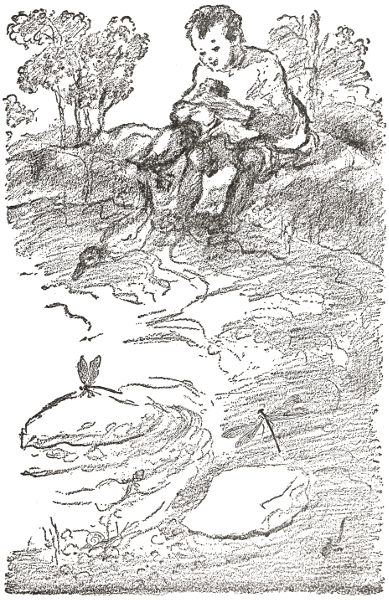
“I think of the king’s crown, of the princesses’ necklace.”
I take a pinch of sand and place it in my palm. The brilliant particles are numerous, but so small that I have to pick them up with a straw moistened in my mouth. Let us drop this: they are too tiny and too bothersome to collect. The big, valuable lumps must be farther on, in the thickness of the rock. We’ll come back later; we’ll blast the mountain.
I break more stones. Oh, what a queer thing has just come loose, all in one piece! It is turned spiral-wise, like certain flat Snails that come out of the cracks of old walls in rainy weather. With its gnarled sides, it looks like a little ram’s-horn. How do things like that find their way into the stone?
Treasures and curiosities make my pockets bulge with pebbles. It is late and the little ducklings have had all they want to eat. “Come along, youngsters,” I say to them, “let’s go home.” My blistered heel is forgotten in my excitement.
The walk back is a delight, as I think of all the wonderful things I have found. But a sad disappointment is waiting for me when I reach home. My parents catch sight of my bulging pockets, with their disgraceful load of stones. The cloth has given way under the rough and heavy burden.
“You rascal!” says father, at sight of the damage. “I send you to mind the ducks and you amuse yourself picking up stones, as though there weren’t enough of them all round the house! Make haste and throw them away!”
Broken-hearted, I obey. Diamonds, gold-dust, petrified ram’s-horn, heavenly Beetle, are all flung on a rubbish-heap outside the door.
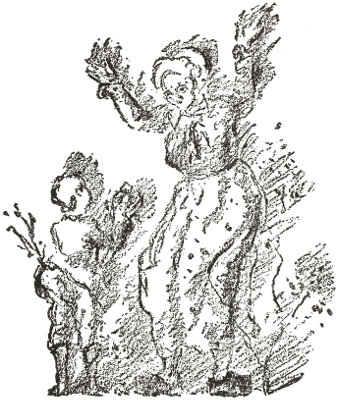
Mother bewails her lot:
“A nice thing, bringing up children to see them turn out so badly! You’ll bring me to my grave. Green stuff I don’t mind: it does for the rabbits. But stones, which ruin your pockets; poisonous animals, which’ll sting your hand: what good are they to you, silly? There’s no doubt about it; some one has thrown a spell over you!”
Poor mother! She was right. A spell had been cast upon me—a spell which Nature herself had woven. In later years I found out that the diamonds of the duck-pool were rock-crystal, the gold-dust, mica; but the fascination of the pond held good for all that. It was full of secrets that were worth more to me than diamonds or gold.
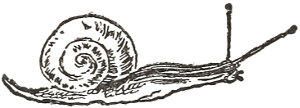
Have you ever had an indoor pond? Such a pond is easy to make and one can watch the life of the water in it even better than outdoors, where the ponds are too large and have too much in them. Besides, when out-of-doors, one is likely to be disturbed by passers-by.
For my indoor pond, the blacksmith made me a framework of iron rods. The carpenter, who is also a glazier, set the framework on a wooden base and supplied it with a movable board as a lid; he then fixed thick panes of glass in the four sides. The bottom of the pond was made of tarred sheet iron, and had a trap to let the water out. The contrivance looked very well, standing on a little table in front of a sunny window. It held about ten or twelve gallons.
I put in it first some limy incrustations with which certain springs in my neighborhood cover the dead clumps of rushes. It is light, full of holes, and looks a little like a coral reef. Moreover, it is covered with a short, green, velvety moss of tiny pond-weed. I count upon this pond-weed to keep the water healthy. How? Let us see.
The living creatures in the pond fill the water, just as living people fill the air, with gases unfit to breathe. Somehow the pond must get rid of these gases, or its inhabitants will die. This is what the pond-weed does; it breathes in and burns up the unwholesome gases, changing them into a life-giving gas.
If you will look at the pond when the sun is shining on it, you will see this change take place. How beautiful the water-weeds are! The green-carpeted reef is lit up with countless sparkling points and looks like a fairy lawn of velvet, studded with thousands of diamond pin-heads. From this exquisite jewelry pearls constantly break loose and are at once replaced by others; slowly they rise, like tiny globes of light. They spread on every side. It is a constant display of fireworks in the depth of the water.
This is what is really happening: The weeds are decomposing—that is, separating into its elements—the unwholesome carbonic acid gas with which the water is filled; they keep the carbon to use in their own cells; they breathe out the oxygen in tiny bubbles, the pearls that you have seen. These partly dissolve in the water, making it healthful for the little water-creatures to breathe, and partly reach the surface, where they vanish in the air, making it good for us to breathe.
No matter how often I see it, I cannot help being interested in this everyday marvel of a bundle of weeds purifying a stagnant pool; I look with a delighted eye upon the ceaseless spray of spreading bubbles; I see in imagination the prehistoric times when seaweed, the first-born of plants, produced the first atmosphere for living things to breathe at the time when the land of the continents was beginning to rise out of the oceans. What I see before my eyes, between the glass panes of my pond, tells me the story of the planet surrounding itself with pure air.
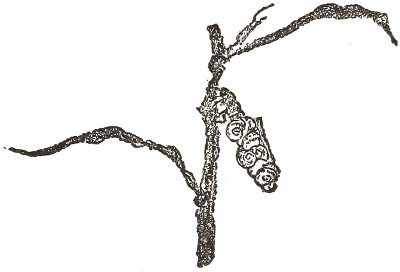
[The caddis-worm is the grub of the caddis-fly, which is like a small moth and is often seen flitting over our streams and ponds. There are about one hundred and fifty species of this fly in America.]
Whom shall I lodge in my glass trough, kept always wholesome by the action of the water-weeds? I shall keep Caddis-worms, those insects which clothe themselves with little sticks and other materials. They are among the most ingenious of the self-clothing insects.
The particular species of Caddis-worm I have chosen is found in muddy-bottomed, stagnant pools crammed with small reeds. It is the little grub that carries through the still waters a bundle of tiny fragments fallen from the reeds. Its sheath, a traveling house, is an elaborate piece of work, made of many different materials.
The young worms, the beginners, start with a sort of deep basket in wicker-work, made of small, stiff roots, long steeped and peeled under water. The grub that has made a find of these fibers saws them with its jaws and cuts them into little straight sticks, which it fixes one by one to the edge of its basket, always crosswise. This pile of spikes is a fine protection, but hard to steer through the tangle of water-plants. Sooner or later the worm forsakes it, and builds with round bits of wood, browned by the water, often as wide as a thick straw and a finger’s breadth long, more or less—taking them as chance supplies them.
It does not always use wood, however. If there are plenty of small, dead Pond-snails in the pond, all of the same size, the Caddis-worm makes a splendid patchwork scabbard; with a cluster of slender roots, reduced by rotting to their stiff, straight, woody axis, it manufactures pretty specimens of wicker-work like baskets. With grains of rice, which I gave the grubs in my glass pond as an experiment, they built themselves magnificent towers of ivory. Next to the sheaths of snail-shells, this was the prettiest thing I ever saw the Caddis-worms make.
What is the use of these houses which the Caddis-worms carry about with them? I catch a glimpse of the reason for making them. My glass pond was at first occupied by a dozen Water-beetles, whose diving performances are so curious to watch. One day, meaning no harm and for want of a better place to put them, I fling among them a couple of handfuls of Caddis-worms. Blunderer that I am, what have I done! The pirate Water-beetles, hiding in the rugged corners of the rockwork, at once perceive the windfall. They rise to the surface with great strokes of their oars; they hasten and fling themselves upon the crowd of carpenter Caddis-worms. Each Beetle grabs a sheath by the middle and tries to rip it open by tearing off shells and sticks. While this is going on, the Caddis-worm, close-pressed, appears at the mouth of the sheath, slips out, and quickly escapes under the eyes of the Water-beetle, who appears to notice nothing.
The brutal ripper of sheaths does not see the little worm, like a white sausage, that slips between his legs, passes under his fangs, and madly flees. He continues to tear away the outer case and to tug at the silken lining. When the breach is made, he is quite crestfallen at not finding what he expected.

Poor fool! Your victim went out under your nose and you never saw it. The worm has sunk to the bottom and taken refuge in the mysteries of the rockwork. If things were happening in a larger, outdoor pond, it is clear that, with their clever way of removing themselves, most of the worms would escape scot-free. Fleeing to a distance and recovering from the sharp alarm, they would build themselves a new scabbard, and all would be over until the next attack, which would be foiled all over again by the very same trick!
Caddis-worms are able to remain on the level of the water indefinitely with no other support than their house; they can rest in unsinkable flotillas and can even shift their place by working the rudder.
How do they do it? Do their sticks make a sort of raft? Can the shells contain a few bubbles of air and serve as floats? Let us see.
I remove a number of Caddis-worms from their sheaths and put the sheaths in the water. Not one of them floats, neither those made of shells nor those of woody materials. The Worm also, when removed from its tube, is unable to float.
This is how the Worm manages. When at rest, at the bottom of the pond, it fills the whole of the tube of its sheath. When it wishes to reach the top of the pond, it climbs up the reeds, dragging its house of sticks with it; then it sticks the front of its body out of the sheath, leaving a vacant space in the rear, like the vacuum in a pump when one draws out the piston. This promptly fills with air, enabling the Worm to float, sheath and all, just as the air in a life-preserver holds a person up in the water. The Caddis-worm does not need to cling to the grasses any longer. It can move about on the surface of the pond, in the glad sunlight.
To be sure, it is not very talented as a boatman. But it can turn round, tack about and shift its place slightly by using the front part of its body, which is out of the tube, as a rudder and paddle; and that is all it wishes to do. When it has had enough of the sun, and thinks it time to return to the quiet of the mud-bed at the bottom, it draws itself back into its sheath, expelling the air, and at once begins to sink.
We have our submarines—the Caddis-worms have theirs. They can come out of the water, they can dip down and even stop at mid-depth by releasing gradually the surplus air. And this apparatus, so perfectly balanced, so skillful, requires no knowledge on the part of its maker. It comes into being of itself, in accordance with the plans of the universal harmony of things.
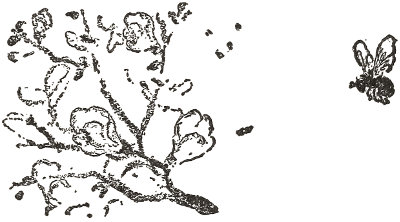
At a school where I once taught, one subject in particular appealed to both master and pupils. This was open-air geometry, practical surveying. When May came, once every week we left the gloomy schoolroom for the fields. It was a regular holiday. We did our surveying on an untilled plain, covered with flowering thyme and rounded pebbles. There was room there for making every sort of triangle or polygon.
Well, from the very first day, my attention was attracted by something suspicious. If I sent one of the boys to plant a stake, I would see him stop frequently on his way, bend down, stand up again, look about and stoop once more, neglecting his straight line and his signals. Another, who was told to pick up the arrows, would forget and take up a pebble instead; and a third, instead of measuring angles, would crumble a clod of earth between his fingers.

Most of them were caught licking a bit of straw. The surveying suffered. What could the mystery be?
I inquired; and everything was explained. The scholars had known for a long time what the master had not yet heard of, namely, that there was a big black Bee who made clay nests on the pebbles in the fields. These nests contained honey; and my surveyors used to open them and empty the cells with a straw. The honey, although rather strong-flavored, was most acceptable. I grew fond of it myself, and joined the nest-hunters, putting off the lesson until later. It was thus that I first made the acquaintance of the Mason-bee.
The Bee herself is a magnificent insect, with dark-violet wings and a black-velvet dress. We have two kinds of Mason-bees in our district: this one, who builds by herself on walls or pebbles, and the Sicilian Mason-bee, who builds in colonies under sheds and roofs. Both use the same kind of material: hard clay, mixed with a little sand and kneaded into a paste with the Bee’s own saliva, forming, when dry, a sort of hard cement.
Man’s masonry is formed of stones laid one above the other and cemented together with lime. The Mason-bee’s work can bear comparison with ours. Instead of stones, she uses big pieces of gravel. She chooses them carefully one by one, picks out the hardest bits, generally with corners, which, fitting one into the other, make a solid whole. She holds them together with layers of her mortar, sparingly applied. Thus the outside of her cell looks like a rough stone house; but the inside, which must be smooth in order not to hurt the Bee-baby’s tender skin, is covered with a coat of pure mortar. This inner whitewash, however, is not put on artistically, but in great splashes; and the grub takes care, after it has finished eating its honey, to make itself a cocoon and hang the walls of its room with silk.
When the cell is finished, the Bee at once sets to work to provide food for it. The flowers round about, especially those of the yellow broom, which in May deck the pebbly borders of the mountain streams with gold, supply her with sugary liquid and pollen. She comes with her crop swollen with honey and her body yellowed underneath with pollen-dust. She dives headfirst into the cell; and for a few moments you see her jerk violently as she empties her crop of the honey-sirup. Afterwards, she comes out of the cell, only to go in again at once, but this time backwards. The Bee now brushes the lower side of her abdomen with her two hind-legs and rids herself of her load of pollen. Once more she comes out and once more goes in headfirst. It is a question of stirring the materials, with her jaws for a spoon, and making the whole into a smooth mixture. She does not do this after every journey; only once in a while, when she has gathered a good deal of food.
When the cell is half full of food, she thinks there is enough. An egg must now be laid on top of the paste and the house must be closed. All this is done quickly. The cover is a lid of pure mortar, which the Bee builds by degrees, working from the outside to the center. Two days at most appeared to me to be enough for everything, provided that no bad weather—rain or merely clouds—came to interrupt the work. Then a second cell is built, with its back to the first and provisioned in the same manner. A third, a fourth, and so on follow, each supplied with honey and an egg and closed before the foundations of the next are laid.

“The flowers which deck the mountain streams with gold supply her with sugary liquid and pollen.”
When all the cells are finished, the Bee builds a thick cover over the group, to protect her grub-babies from damp, heat and cold. This cover is made of the usual mortar, but on this occasion with no small stones in it. The Bee applies it pellet by pellet, trowelful by trowelful, to the depth of about a third of an inch over the cluster of cells, which disappear entirely under the clay covering. When this is done, the nest has the shape of a rough dome, equal in size to half an orange. One would take it for a round lump of mud which had been thrown and half crushed against a stone and had then dried where it was. This outer covering dries as quickly as the cement we use in our houses; and the nest is soon almost as hard as a stone.
Instead of building a brand-new nest on a hitherto unoccupied bowlder, the Mason-bee of the Walls is always glad to make use of old nests built the year before. These need only a little repair to put them in good condition. The Bee who has chosen one of these nests looks about to see what parts need repairing, tears off the strips of cocoon hanging from the walls, removes the fragments of clay that fell from the ceiling when the young Bee of the preceding year bored her way through it, gives a coat of mortar to parts that need it, mends the opening a little, and that is all. She then goes about storing honey and laying her egg, as she would in a new cell. When all the cells, one after the other, are thus furnished, the Bee puts a few touches on the outer dome of cement, if it needs them; and she is through.
From one and the same nest there come out several inhabitants, brothers and sisters, the males with a bright brick-red fleece, and the female of a splendid velvety black, with dark-violet wings. They are all the children of the Bee who built or repaired and furnished the cells. The male Bees lead a careless existence, never work, and do not return to the clay houses except for a brief moment to woo the ladies; they have nothing to do with the housekeeping or the new nests. What they want is the nectar in the flower-cups, not mortar to build with. There are left the sisters, who will be the mothers of the next family. As sisters, they all have equal rights to the nest. They do not go by this rule, however. The nest belongs to the one who first takes possession of it. If any of the others or any neighbors dispute her ownership, she fights them until they have the worst of it and fly away, leaving her in peace.
All is not smooth sailing after the Mason-bee has finished building her dome of cells. It is then that a certain Stelis-wasp, much smaller than the Mason-bee, appears, looks carefully at the outside of the Mason-bee’s home, and makes up her mind, weak and small as she is, to introduce her eggs into this cement fortress. Everything is most carefully closed: a layer of rough plaster, at least two fifths of an inch thick, entirely covers the cells, which are each of them sealed with a thick mortar plug. The plaster is almost as hard as a rock. Never mind! The little insect is going to reach the honey in those cells.
She pluckily sets to. Atom by atom, she drives a hole in the plaster and scoops out a shaft just large enough to let her through; she reaches the lid of the cell and gnaws it till she catches sight of the honey. It is a slow and painful process, in which the feeble Wasp wears herself out. I find it hard to break the plaster with the point of my knife. How much harder, then, for the insect, with her tiny pincers!
When she reaches the honey, the Stelis-wasp slips through and, on the surface of the provisions, side by side with the Mason-bee’s, she lays a number of her own eggs. The honey-food will be the common property of all the new arrivals, the Stelis-wasp’s grubs as well as the Mason-bee’s.
The next thing for the parasite Wasp to do is to wall up the opening she has made, so that other robbers cannot get in. At the foot of the nest, the Wasp collects a little red earth; she makes it into mortar by wetting it with saliva; and with the pellets thus prepared she fills up the entrance shaft as neatly as if she were a master-mason. The mortar, being red, shows up against the Bee’s house, which is white; so when we see the red speck on the pale background of the Bee’s nest we know a Stelis-wasp has been that way.
As a result of the Stelis’ action, the poor Bee-baby will starve to death. The Wasp’s grubs mature first and eat up all the food.
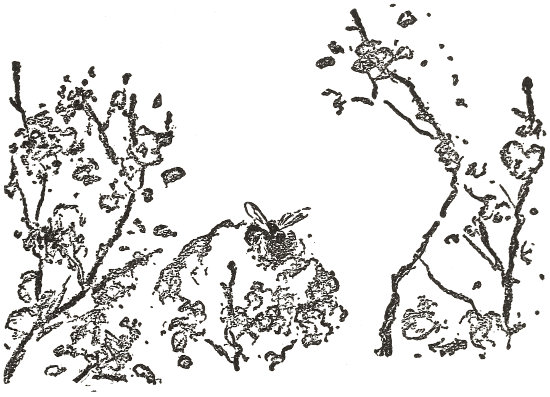
Sometimes, when a Mason-bee has stayed too long among the flowers, getting honey for her cell, she finds the cell closed when she returns home. A neighbor Bee has taken the opportunity to lay her eggs there, after finishing the building and stocking it with provisions. The real Bee-owner is shut out.
She does not hesitate long about what to do. After she has examined her former home very carefully, to make sure it is closed against her, she seems to say to herself, “An egg for an egg, a cell for a cell. You’ve stolen my house; I’ll steal yours.” She goes to another Bee’s dwelling and patiently gnaws the mortar lid or door. When she has made an opening, she stands bending over the cell, her head half-buried in it, as if thinking. She goes away, she returns undecidedly; at last she makes up her mind. The other Bees, meanwhile, pay no attention to her, not even the one who laid the egg in the cell.
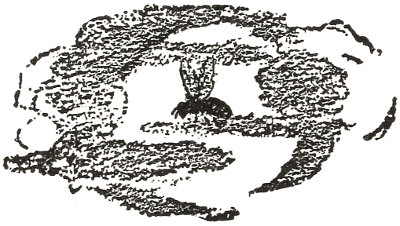
The Bee who has turned burglar snaps up the strange egg from the surface of the honey and flings it on the rubbish-heap as carelessly as if she were ridding the house of a bit of dirt. Then, although there is already plenty of honey in the cell, she adds more from her own stock, lays her own egg, and closes up the house again. The lid is repaired to look like new and everything restored to order. The Bee has had her revenge; her anger is appeased. Next time she lays an egg it will be in her own cell, unless that has again been seized by another.
I have told you about the robber Stelis-wasp who enters the Bee’s cement house and steals the provisions laid up for the Bee-baby; she is not the only one who despoils the poor Mason-bee. There is another Bee, the Dioxys, who acts in about the same way as the Stelis-wasp, except that she sometimes does even worse, and eats up the grub itself, as well as its honey. Then there are the Osmia-bees and the Leaf-cutting Bees, who make themselves very much at home in the Bees’ houses, when they get a chance, keeping out the real owners; and there are also three flies, whose grubs eat the Bee-grub alive! It sometimes seems wonderful that the Mason-bee should ever live to grow up; and you will be glad to hear of three other visitors the Bee-grub has, which actually help instead of making it impossible for it to live. These are three Beetles.
The old nests which the Mason-bees build in, to save themselves the trouble of making new ones, are often in a very insanitary condition. The cells are full of dead larvæ (larva is another word for grub, and both words mean the first stage of the insect after leaving the egg, when it looks like a little worm), which, for some reason or other, could not break through their hard prisons; of honey which has not been eaten and has turned sour; of tattered cocoons, and shreds of skin, left behind when the grubs turned into Bees. All these dead and useless things are, of course, not pleasant to have in any house, especially in a tidy Bee’s.
Here is where the Beetles come to the rescue. They enter the Bee’s house and lay their eggs there. The larvæ, when they come out of the eggs, begin to make themselves useful. Two species of larvæ gnaw the remains of the dead Bees; the third, which is quite a good-looking worm, with a black head and the rest of its body a pretty pink, takes care of the spoiled honey. This worm turns into a Beetle in a red dress with blue ornaments, whom you may often see strolling about the Bee’s house in the working season, tasting here and there drops of honey oozing from some cracked cell. The Bees leave him in peace, as if they knew that it was his duty to keep their house wholesome.
Still later, when the Bee’s house, exposed as it is to wind and weather, cracks and falls to pieces almost entirely, the Bees leave it for good and all, and still other insects take possession of it. These are gypsies, who are not particular where they camp out. Spiders make their homes in the blind alleys which used to be cells, and weave white-satin screens, behind which they lie in wait for passing game. The Hunting-wasps arrange nooks with earthen embankments or clay partitions, and there store up small members of the Spider tribe as food for their families. So we see that the house that the Mason-bee built for herself is useful to many others, good, bad, or indifferent friends of hers as the case may be.
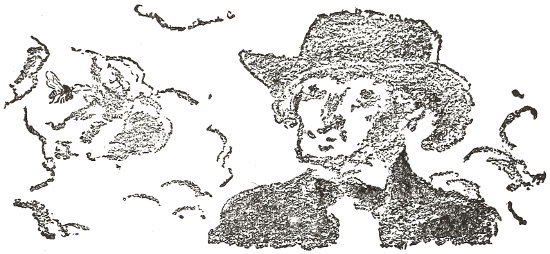
I wished to know something more about my Mason-bees. I had heard that they knew how to find their nests even if carried away from them. One day I managed to capture forty Bees from a nest under the eaves of my shed, and to put them one by one in screws of paper. I asked my daughter Aglaé to stay near the nest and watch for the return of the Bees. Things being thus arranged, I carried off my forty captives to a spot two and a half miles from home.
I had to mark each captive with a mixture of chalk and gum arabic before I set her free. It was no easy business. I was stung many times, and sometimes I forgot myself and squeezed the Bee harder than I should have. As a result, about twenty out of my forty Bees were injured. The rest started off, in different directions at first; but most of them seemed to me to be making for their home.
Meanwhile a stiff breeze sprang up, making things still harder for the Bees. They must have had to fly close to the ground; they could not possibly go up high and get a view of the country.
Under the circumstances, I hardly thought, when I reached home, that the Bees would be there. But Aglaé greeted me at once, her cheeks flushed with excitement:
“Two!” she cried. “Two arrived at twenty minutes to three, with a load of pollen under their bellies!” I had released my insects at about two o’clock; these first arrivals had therefore flown two miles and a half in less than three quarters of an hour, and lingered to forage on the way.
As it was growing late, we had to stop our observations. Next day, however, I took another count of my Mason-bees and found fifteen with a white spot as I had marked them. At least fifteen out of the twenty then had returned, in spite of having the wind against them, and in spite of having been taken to a place where they had almost certainly never been before. These Bees do not go far afield, for they have all the food and building material they want near home. Then how did my exiles return? What guided them? It was certainly not memory, but some special faculty which we cannot explain, it is so different from anything we ourselves possess.
The Cat is supposed to have the same power as the Bee to find its way home. I never believed this till I saw what some Cats of my own could do. Let me tell you the story.
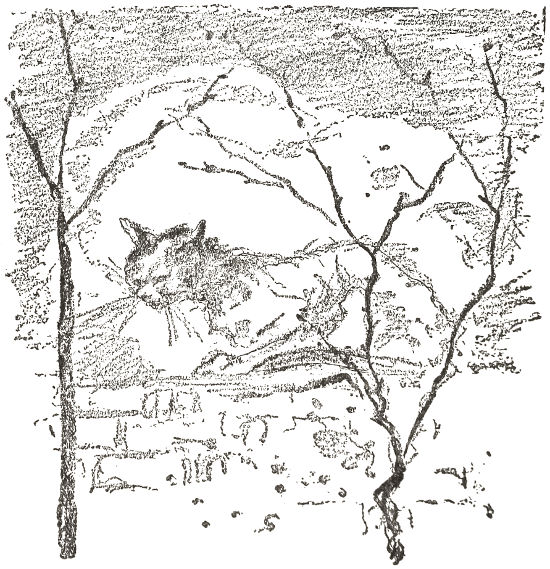
One day there appeared upon my garden wall a wretched-looking Cat, with matted coat and protruding ribs; so thin that his back was a jagged ridge. My children, at that time very young, took pity on his misery. Bread soaked in milk was offered him at the end of a reed. He took it. And the mouthfuls succeeded one another to such good purpose that at last he had had enough and went, paying no attention to the “Puss! Puss!” of his compassionate friends. But after a while he grew hungry again, and reappeared on top of the wall. He received the same fare of bread soaked in milk, the same soft words. He allowed himself to be tempted. He came down from the wall. The children were able to stroke his back. Goodness, how thin he was!
It was the great topic of conversation. We discussed it at table: we would tame the tramp, we would keep him, we would make him a bed of hay. It was a most important matter: I can see to this day, I shall always see, the council of rattleheads deliberating on the Cat’s fate. They were not satisfied until the savage animal remained. Soon he grew into a magnificent Tom. His large, round head, his muscular legs, his reddish fur, flecked with darker patches, reminded one of a little jaguar. He was christened Ginger because of his tawny hue. A mate joined him later, picked up in almost similar circumstances. Such was the beginning of my series of Gingers, which I have kept for almost twenty years, in spite of various movings.
The first time we moved we were anxious about our Cats. We were all of us attached to them and should have thought it nothing short of criminal to abandon the poor creatures, whom we had so often petted, to distress and probably to thoughtless persecution. The shes and the kittens would travel without any trouble: all you have to do is to put them in a basket; they will keep quiet on the journey. But the old Tom-cats were a serious problem. I had two, the head of the family and one of his descendants, quite as strong as himself. We decided to take the grandfather, if he consented to come, and to leave the grandson behind, after finding him a home.
My friend Dr. Loriol offered to take the younger cat. The animal was carried to him at nightfall in a closed hamper. Hardly were we seated at the evening meal, talking of the good fortune of our Tom-cat, when we saw a dripping mass jump through the window. The shapeless bundle came and rubbed itself against our legs, purring with happiness. It was the Cat.
I heard his story next day. On arriving at Dr. Loriol’s, he was locked up in a bedroom. The moment he saw himself a prisoner in the unfamiliar room, he began to jump about wildly on the furniture, against the window panes, among the ornaments on the mantelpiece, threatening to make short work of everything. Mrs. Loriol was frightened by the little lunatic; she hastened to open the window; and the Cat leapt out among the passers-by. A few minutes later, he was back at home. And it was no easy matter: he had to cross the town almost from end to end; he had to make his way through a long labyrinth of crowded streets, among a thousand dangers, including boys and dogs; lastly—and this perhaps was even harder—he had to pass over a river which ran through the town. There were bridges at hand, many, in fact; but the animal, taking the shortest cut, had used none of them, bravely jumping into the water, as the streaming fur showed.
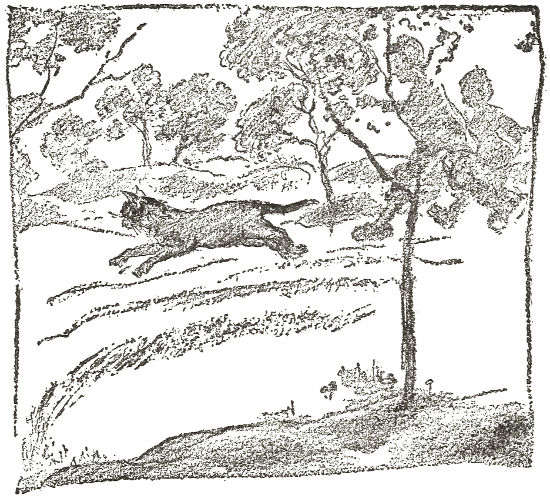
I had pity on the poor Cat, so faithful to his home. We agreed to take him with us. We were spared the worry: a few days later, he was found lying stiff and stark under a shrub in the garden. Some one had poisoned him for me. Who? It was not likely that it was a friend!
There was still the old Cat. He could not be found when we left our home, so the carter was promised an extra two dollars if he would bring the Cat to us at our new home with one of his loads. On his last journey with our goods he brought him, stowed away under the driver’s seat. I scarcely knew my old Tom when we opened the moving prison in which he had been kept since the day before. He came out looking a most alarming beast, scratching and spitting, with bristling hair, bloodshot eyes, lips white with foam. I thought him mad and watched him closely for a time. I was wrong: he was merely bewildered and frightened. Had there been trouble with the carter when he was caught? Did he have a bad time on the journey? I do not know. What I do know is that the very nature of the Cat seemed changed: there was no more friendly purring, no more rubbing against our legs; nothing but a wild expression and the deepest gloom. Kind treatment could not soothe him. One day I found him lying dead in the ashes on the hearth. Grief, with the help of old age, had killed him. Would he have gone back to our old home, if he had had the strength? I would not venture to say so. But, at least, I think it very remarkable that an animal should let itself die of homesickness because the weakness of old age prevented it from returning to its former haunts.
The next time we move, the family of Gingers have been renewed: the old ones have passed away, new ones have come, including a full-grown Tom, worthy in every way of his ancestors. He alone will give us some trouble in moving; the others, the babies and the mothers, can be removed easily. We put them into baskets. The Tom has one to himself, so that the peace may be kept. The journey is made by carriage. Nothing striking happens before our arrival. When we let the mother Cats out of their hampers, they inspect the new home, explore the rooms one by one; with their pink noses they recognize the furniture: they find their own seats, their own tables, their own armchairs; but the surroundings are different. They give little surprised miaows and questioning glances. We pet them and give them saucers of milk, and by the next day they feel quite at home.
It is a different matter with the Tom. We put him in the attic, where he will find plenty of room for his capers; we take turns keeping him company; we give him a double portion of plates to lick; from time to time we bring some of the other Cats to him, to show him that he is not alone in the house; we do everything we can to make him forget the old home. He seems, in fact, to forget it: he is gentle under the hand that pets him, he comes when called, purrs, arches his back. We have kept him shut up for a week, and now we think it is time to give him back his liberty. He goes down to the kitchen, stands by the table like the others, goes out into the garden, under the watchful eye of my daughter Aglaé, who does not lose sight of him; he prowls all around with the most innocent air. He comes back. Victory! The Tom-cat will not run away.
Next morning:
“Puss! Puss!”
Not a sign of him! We hunt, we call. Nothing. Oh, the hypocrite, the hypocrite! How he has tricked us! He has gone, he is at our old home. So I declare, but the family will not believe it.
My two daughters went back to the old home. They found the Cat, as I said they would, and brought him back in a hamper. His paws and belly were covered with red clay; and yet the weather was dry, there was no mud. The Cat, therefore, must have swum the river, and the moist fur had kept the red earth of the fields through which he had passed. The distance between our two homes was four and a half miles.
We kept the deserter in our attic for two weeks, and then we let him out again. Before twenty-four hours had passed he was back at his old home. We had to leave him to his fate. A neighbor out that way told me that he saw him one day hiding behind a hedge with a rabbit in his mouth. He was no longer provided with food; he had to hunt for it as best he could. I heard no more of him. He came to a bad end, no doubt; he had become a robber and must have met with a robber’s fate.
These true stories prove that Cats have in their fashion the instinct of my Mason-bees. So, too, have Pigeons, who, transported for hundreds of miles, are able to find their way back to their own dove-cot; so have the Swallows and many other birds. But to go back to the insects. I wished to find out if Ants, who are insects closely related to the Bees, have the same sense of direction that they have.
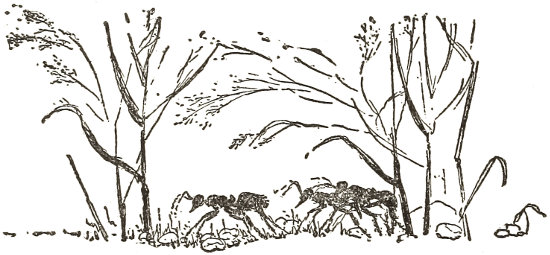
Among the treasures of my piece of waste ground is an ant-hill belonging to the celebrated Red Ants, the slave-hunting Amazons. If you have never heard about these Ants, their practices seem almost too wonderful to believe. They are unable to bring up their own families, to look for their food, to take it even when it is within their reach. Therefore they need servants to feed them and keep house for them. They make a practice of stealing children to wait on the community. They raid the neighboring ant-hills, the home of a different species; they carry away the Ant-babies, who are in the nymph or swaddling-clothes stage, that is, wrapped in the cocoons. These grow up in the Red Ants’ house and become willing and industrious servants.
When the hot weather of June and July sets in, I often see the Amazons leave their barracks of an afternoon and start on an expedition. The column is five or six yards long. At the first suspicion of an ant-hill, the front ones halt and spread out in a swarming throng, which is increased by the others as they come up hurriedly. Scouts are sent out; the Amazons recognize that they are on a wrong track; and the column forms again. It resumes its march, crosses the garden paths, disappears from sight in the grass, reappears farther on, threads its way through the heap of dead leaves, comes out again and continues its search.
At last, a nest of Black Ants is discovered. The Red Ants hasten down to the dormitories, enter the burrows where the Ant-grubs lie and soon come out with their booty. Then we have, at the gates of the underground city, a bewildering scrimmage between the defending Blacks and the attacking Reds. The struggle is too unequal to remain in doubt. Victory falls to the Reds, who race back home, each with her prize, a swaddled baby, dangling from her jaws.
I should like to go on with the story of the Amazons, but I have no time at present. Their return to the nest is what I am interested in. Do they know their way as the Bees do?
Apparently not; for I find that the Ants always take exactly the same path home that they did coming, no matter how difficult it was or how many short cuts might be taken. I came upon them one day when they were advancing on a raid by the side of a garden pond. The wind was blowing hard and blew whole rows of the Ants into the water, where the Fish gobbled them up. I thought that on the way back they would avoid this dangerous bit. Not at all: they came back the same way, and the Fish received a double windfall, the Ants and their prizes.
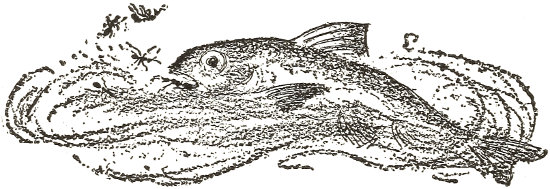
As I had not time to watch the Ants for whole afternoons, I asked my granddaughter Lucie, a little rogue who likes to hear my stories of the Ants, to help me. She had been present at the great battle between the Reds and the Blacks and was much impressed by the stealing of the long-clothes babies, and she was willing to wander about the garden when the weather was fine, keeping an eye on the Red Ants for me.
One day, while I was working in my study, there came a banging at my door.
“It’s I, Lucie! Come quick: the Reds have gone into the Blacks’ house. Come quick!”
“And do you know the road they took?”
“Yes, I marked it.”
“What! Marked it? And how?”
“I did what Hop-o’-My-Thumb did: I scattered little white stones along the road.”
I hurried out. Things had happened as my six-year-old helper had said. The Ants had made their raid and were returning along the track of telltale pebbles. When I took some of them up on a leaf and set them a few feet away from the path, they were lost. The Ant relies on her sight and her memory for places to guide her home. Even when her raids to the same ant-hill are two or three days apart, she follows exactly the same path each time. The memory of an Ant! What can that be? Is it like ours? I do not know; but I do know that, though closely related to the Bee, she has not the same sense of direction that the Bee possesses.
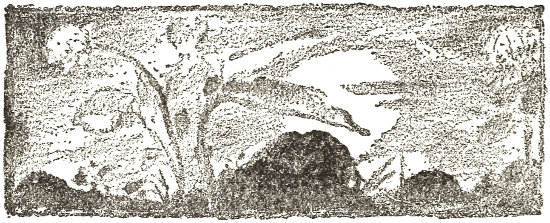
These Bees are generally longer and slighter than the Bee of our hives. They are of different sizes, some larger than the Common Wasp, others even smaller than the House-fly, but all have a mark that shows the family. This is a smooth and shiny line, at the back of the tip-end of the abdomen, a groove along which the sting slides up and down when the insect is on the defensive. The particular species I am going to tell you about is called the Zebra Bee, because the female is beautifully belted around her long abdomen with alternate black and pale-russet scarfs; a simple and pretty dress. She is about the size of the Common Wasp.
She builds her galleries in firm soil, where there is no danger of landslides. The well-leveled paths in my garden suit her to perfection. Every spring she takes possession of them, never alone, but in gangs whose number varies greatly, amounting sometimes to as many as a hundred. In this way she founds what may be described as small townships.
Each Bee has her home, a house which no one but the owner has the right to enter. A good beating would soon call to order any adventuress Bee who dared to make her way into another’s dwelling. Let each keep to her own place and perfect peace will reign in this new-formed society.
Operations begin in April, very quietly, the only sign of the underground works being the little mounds of fresh earth. The laborers show themselves very seldom, so busy are they at the bottom of their pits. At moments, here and there, the summit of a tiny mole-hill begins to totter and tumbles down the slopes of the cone: it is a worker coming up with her armful of rubbish and shooting it outside, without showing herself in the open.
May arrives, gay with flowers and sunshine. The diggers of April have turned themselves into harvesters. At every moment I see them settling, all befloured with yellow, on top of the mole-hills now turned into craters.
The Bee’s home underneath consists first of a nearly vertical shaft, which goes down into the ground from eight to twelve inches. This is the entrance hall. It is about as thick around as a thick lead-pencil.
At the foot of this shaft, in what we might call the basement of the house, are the cells. They are oval hollows, three quarters of an inch long, dug out of the clay. They end in a short bottle-neck that widens into a graceful mouth. All of them open into the passage.
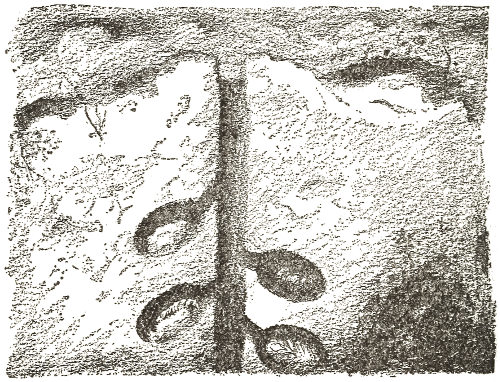
The inside of these little cells is beautifully polished. It is marked with faint, diamond-shaped marks, the traces of the polishing tool that has given the last finish to the work. What can this polisher be? None other than the tongue. The Bee has made a trowel of her tongue and licked the wall daintily and carefully in order to polish it.
I fill a cell with water. The liquid remains in it quite well, without a trace of soaking through. The Bee has varnished the clay of her cell with the saliva applied by her tongue. No wet or damp can reach the Bee-baby, even when the ground is soaked with rain.
The Bee-grub’s rooms are made ready long beforehand, during the bad weather at the end of March and in April, when there are few flowers. The mother works alone at the bottom of her shaft, using her jaws to spade the earth, and her feet, armed with tiny claws, for rakes. She collects the dirt and then, moving backwards with her fore-legs closed over the load, she lifts it up through the shaft and flings it outside, upon the mole-hill, as we have seen. Then she puts the finishing touches with her tongue, and when May comes, with its radiant sunshine and wealth of flowers, everything is ready.
The fields are gay now with dandelions, rock-roses, tansies, daisies, and other flowers, among which the harvesting Bee rolls gleefully, covering herself with pollen. With her crop full of honey and the brushes of her legs all floury with pollen, the Bee returns to her village. Flying very low, almost level with the ground, she hesitates, with sudden turns and bewildered movements. It appears as if she were having trouble to find her own burrow among so many which look exactly alike. But no, there are certain signs known to the insect alone. After carefully examining the neighborhood, the Bee finds her home, alights on the threshold, and dives into it quickly.
What happens at the bottom of the pit must be the same thing that happens in the case of the other Wild Bees. The harvester enters a cell backwards; she first brushes herself and drops her load of pollen; then, turning round, she empties the honey in her crop upon the floury mass. This done, the unwearied one leaves the burrow and flies away, back to the flowers. After many journeys, she has collected enough provisions in the cell. Now is the time to make them up into food, or bake the cake, as we might say.
The mother Bee kneads her flour, mixing with it a little honey. She makes the dough into a round loaf, the size of a pea. Unlike our own loaves, this one has the crust inside and the soft part outside. The middle of the loaf, the food which will be eaten last, when the grub has gained strength, consists of almost nothing but dry pollen. The Bee keeps the softest, nicest part for the outside, from which the feeble grub is to take its first mouthfuls. Here it is all soft crumb, a delicious sandwich with plenty of honey.
She now lays an egg, bent like a bow, upon the round mass of food. If she were like most Honeybees, she would close the house now. But the Zebra Wild Bee is different. She leaves the cells opening into the burrow, so that she can look into them daily and see how her family is getting on. I imagine that from time to time she gives more food to the grub, for the original loaf appears to me a very small amount compared with that served by the other Bees.
At last the grubs, close-watched and well-fed, have grown fat; they are ready for the second stage of Bee life. They are about to weave their wrappers, or cocoons, and change into chrysales. Then, and not till then, the cells are closed; a big clay stopper is built by the mother into the spreading mouth of the cells. Henceforth her cares are over. The rest will come of itself.
If all goes well, the Zebra Bee’s spring family grows up in a couple of months or so; they leave the cells about the end of June, flying off to seek refreshment on the flowers as their mother has done before them.
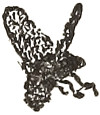
Sometimes all does not go well with the Bee’s family. There are brigands about. One of them is an insignificant Gnat, who is, nevertheless, a bold robber of the Bee.
What does the Gnat look like? She is a Fly, less than one fifth of an inch long. Eyes, dark-red; face, white. Corselet, pearl-gray, with five rows of fine black dots, which are the roots of stiff bristles pointing backwards. Grayish abdomen. Black legs. That is her picture.
There are many of these Gnats in the colony of Bees I am watching. Crouching in the sun, near a burrow, the Gnat waits. As soon as the Bee arrives from her harvesting, her legs yellow with pollen, the Gnat darts forth and pursues her, keeping behind in all the turns of her wavering flight. At last, the Bee suddenly dives indoors. No less suddenly the Gnat settles on the mole-hill, quite close to the entrance. Motionless, with her head turned towards the door of the house, she waits for the Bee to finish her business. The latter reappears at last and, for a few seconds, stands on the threshold, with her head and neck outside the hole. The Gnat, on her side, does not stir.
Often they are face to face, separated by a space no wider than a finger’s breadth. Neither of them shows the least excitement. The Bee, this amiable giantess, could, if she liked, rip up with her claw the tiny bandit who ruins her home; she could crunch her with her jaws, run her through with her sting. She does nothing of the sort, but leaves the robber in peace. The latter does not seem in the least afraid. She remains quite motionless in the presence of the Bee who could crush her with one blow.
The Bee flies off. At once the Gnat walks in, with no more ceremony than if she were entering her own place. She now chooses among the victualed cells, for they are all open, as I have said; she leisurely places her eggs in one of them. No one will disturb her until the Bee’s return, and by that time she has made off. In some favorable spot, not far from the burrow, she waits for a chance to do the same thing over again.
Some weeks after, let us dig up the pollen loaves of the Bee. We shall find them crumbled up, frittered away. We shall see two or three little worms, with pointed mouths, moving in the yellow flour scattered over the floor of the cell. These are the Gnat’s children. With them we sometimes find the lawful owner, the grub-worm of the Bee, but stunted and thin with fasting. His greedy companions, without otherwise hurting him, deprive him of the best of everything. The poor creature dwindles, shrivels up and soon disappears from view. The Gnat-worms make of his corpse one mouthful the more.
The Bee mother, though she is free to visit her grubs at any moment, does not appear to notice what is going on. She never kills the strange grubs, or even turns them out of doors. She seals up the cells in which the Gnat children have feasted just as carefully as if her own grubs were in it. By this time the Gnat grubs have left. The cells are quite empty.
The Zebra Bee’s spring family, when no accident such as we have been describing has happened, consists of about ten young Bees, all sisters. They save time by using the mother’s house, all of them together, without dispute. They come and go peacefully through the same door, attend to their business, pass and let the others pass. Down at the bottom of the pit, each Bee has her little home, a group of cells which she has dug for herself. Here she works alone; but the passage way is free to all the sisters.
Let us watch them as they go to and fro. A harvester comes back from the fields, the feather-brushes of her legs powdered with pollen. If the door be open, the Bee at once dives underground. She is very busy, and she does not waste time on the threshold. Sometimes several appear upon the scene at almost the same moment. The passage is too narrow for two, especially when they have to avoid jostling each other and so making the floury burden fall to the floor. The one nearest to the opening enters quickly. The others, drawn up on the threshold in the order of their arrival, respectful of one another’s rights, await their turn. As soon as the first disappears, the second follows after her, and is herself swiftly followed by the third and then the others, one by one.
Sometimes a Bee about to come out meets a Bee about to go in. Then the latter draws back a little and makes way for the other. Each Bee tries to outdo the other in politeness. I see some who, when on the point of coming out from the pit, go down again and leave the passage free for the one who has just arrived. Thanks to this accommodating spirit on the part of all, the business of the house goes on without delay.
Let us keep our eyes open. There is something even better than this to see. When a Bee appears, returning from her round of the flowers, we see a sort of trap door, which closes the house, suddenly fall and give a free passage. As soon as the new arrival has entered, the trap rises back into its place, almost level with the ground, and closes the entrance again. The same thing happens when the insects go out. At a request from within, the trap descends, the door opens and the Bee flies away. The opening is closed at once.
What can this thing be, which works like the piston of a pump, and opens and closes the door at each departure and each arrival? It is a Bee, who has become the doorkeeper of the establishment. With her large head she stops up the top of the entrance hall. If any one belonging to the house wants to go in or out, she “pulls the cord,” that is to say, she withdraws to a spot where the gallery becomes wider and leaves room for two. When the other has passed she returns to the opening and blocks it with the top of her head. Motionless, ever on the lookout, she does not leave her post except to drive away persistent visitors.
When she does come outside, let us take a look at her. We recognize in her a Bee similar to the others except that the top of her head is bald and her dress is dingy and threadbare. All the nap is gone; and one can hardly make out the handsome stripes of red and brown which she used to have. These tattered, work-worn garments make things clear to us.
This Bee who mounts guard and does the work of a doorkeeper is older than the others. She is in fact the foundress of the establishment, the mother of the actual workers, the grandmother of the present grubs. When she was young, three months ago, she wore herself out making her nest all by herself. Now she is taking a well-earned rest, but hardly a rest, for she is helping the household to the best of her power.
You remember the suspicious Kid, in La Fontaine’s fable, who, looking through the chink of the door, said to the Wolf:
“Show me a white foot, or I shan’t open the door.”
The grandmother Bee is no less suspicious. She says to each comer:
“Show me the yellow foot of a Wild Honey-bee, or you won’t be let in.”
None is admitted to the dwelling unless she be recognized as a member of the family.
See for yourselves. Near the burrow passes an Ant, an unscrupulous adventuress, who would not be sorry to know the meaning of the honeyed fragrance that rises from the bottom of the cellar.
“Be off, or you’ll catch it!” says the doorkeeping Bee, with a movement of her neck.
Usually the threat is enough. The Ant leaves at once. Should she insist, the grandmother leaves her sentry-box, flings herself upon the saucy Ant, beats her, and drives her away. The moment she has given her punishment, she returns to her post.

“‘Be off, or you’ll catch it!’ says the doorkeeping bee.”
Next comes the turn of the Leaf-cutting Bee, who, unskilled in the art of burrowing, uses the old galleries dug by others. Those of the Zebra Bee suit her very well, when the terrible Gnat has left them vacant for lack of heirs. Seeking for a home wherein to stack her Robinia-leaf honey-pots, she often makes a flying visit to my colonies of Wild Bees. A burrow seems to take her fancy; but, before she sets foot on earth, her buzzing is noticed by the sentry, who suddenly darts out and makes a few gestures on the threshold of her door. That is all. The Leaf-cutter has understood. She moves on.
Sometimes the Leaf-cutting Bee has time to alight and stick her head into the mouth of the pit. In a moment the grandmother is there, comes a little higher, and bars the way. Follows a not very serious contest. The stranger quickly recognizes the rights of the first occupant and, without insisting, goes to seek a home elsewhere.
A clever burglar, the parasite of the Leaf-cutting Bee, receives a sound whipping under my eyes. She thought, the featherbrain, that she was entering the Leaf-cutter’s house! She soon finds out her mistake; she meets the grandmother Bee, who punishes her severely. She makes off at full speed. And so with the others who, through carelessness or ambition, try to enter the burrow.
Sometimes the doorkeeping Bee has an encounter with another grandmother. About the middle of July, when the Bee colony is at its busiest, there appear to be two distinct sets of Bees: the young mothers and the old. The young ones, much more numerous, brisk in movement and smartly arrayed, come and go unceasingly from the burrows to the fields and from the fields to the burrows. The older ones, faded and dispirited, wander idly from hole to hole. They look as though they had lost their way and could not find their homes. Who are these vagabonds? I see in them afflicted ones who have lost a family through the act of the hateful Gnat. At the awakening of summer, the poor mother Bee found herself alone. She left her empty house and went off in search of a dwelling where there were cradles to defend, a guard to keep. But those fortunate nests already have their overseer, the grandmother, who is jealous and gives her unemployed neighbor a cold reception. One sentry is enough; two would merely block the narrow passage.
Sometimes the grandmothers actually fight. When the tramp looking for employment appears outside the door, the one on guard does not move from her post, does not withdraw into the passage, as she would before a young Bee returning from the fields. Instead of that, she threatens the intruder with her feet and jaws. The other retaliates and tries to force her way in notwithstanding. They come to blows. The fight ends by the defeat of the stranger, who goes off to pick a quarrel elsewhere.
What becomes of the poor grandmothers who have no homes? They grow rarer and more languid from day to day; then they disappear for good. The little Gray Lizard had his eye on them, they are easily snapped up.
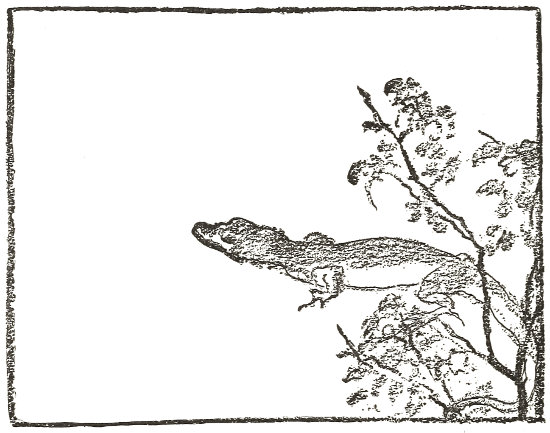
As for the one on guard, she seems never to rest. In the cool hours of the early morning, she is at her post. She is there also towards noon, when the harvesting is in full swing and there are many Bees going in and out. In the afternoon, when the heat is great and the working Bees do not go to the fields, but stay indoors instead, preparing the new cells, the grandmother is still upstairs, stopping the door with her bald head. She takes no nap during the stifling hours: the safety of the household requires her to forego it. At nightfall, or even later, she is just as busy as in the day. The others are resting, but not she, for fear, apparently, of night dangers known to herself alone.
Guarded in this manner, the burrow is safe from such a misfortune as overtook it in May. Let the Gnat come now, if she dare, to steal the Bee’s loaves! She will be put to flight at once. She will not come, because, until spring returns, she is underground in the pupa state, that is, wrapped up in her cocoon. But in her absence there is no lack, among the Fly rabble, of other parasites. And yet, for all my daily visits, I never catch one of these in the neighborhood of the summer burrows. How well the rascals know their trade! How well aware are they of the guard who keeps watch at the Bees’ door!

If you know how to use your eyes in your garden you may observe, some day or other, a number of curious holes in the leaves of the lilac- and rose-trees, some of them round, some of them oval, as if idle but skillful hands had been at work with the pinking-iron. In some places there is scarcely anything but the veins of the leaves left. The author of the mischief is a gray-clad Bee. For scissors, she has her jaws; for compasses, she has her eye and the pivot of her body. The pieces cut out are made into thimble-shaped bags, meant to contain the honey and the egg: the larger, oval pieces make the floor and sides; the smaller, round pieces are kept for the lid. The Leaf-cutter’s nest consists of a row of a dozen, more or less, of these thimbles, placed one on top of the other.
One species of the Leaf-cutting Bee whom we will notice is called the White-girdled Leaf-cutter. She usually takes for her dwelling the tunnel of some Earthworm opening off a claybank. The tunnel is too deep for her purpose. At the bottom of it the climate is too damp, and besides, when the Bee-grub is hatched, it would be dangerous for it to have to climb so far through all sorts of rubbish to reach the surface. The Leaf-cutter, therefore, uses only the front part of the Worm’s gallery, seven or eight inches at the most. What is to be done with the rest of the tunnel? It would never do to leave it open, because some underground burglar, a worm or other insect, might come that way and attack the cells at the rear.
The little Bee foresees this danger. She sets to work to block the passage with a strong barricade of fragments of leaves, some dozens of pieces rolled into screws and fitting into each other. You can see that the insect has cut out these pieces carelessly and hurriedly, and on a different pattern from that of the pieces which are to make the nest.
Next after the barricade of leaves comes the row of cells, usually about five or six in number. These are made of round and oval pieces, as we have seen; oval for the sides, round for the lid. There are two sizes of ovals, the larger ones for the outside and bottom of the bag; the smaller ones for the inside, to make the walls thicker and fill up the gaps.
The Leaf-cutter therefore is able to use her scissors according to the task before her; she makes large or small pieces as they are needed. She is especially careful about the bottom of the bag. As the natural curve of the larger pieces is not enough to make a cup without cracks in it, the Bee improves the work with two or three small ovals applied to the holes.
The cover of the pot consists solely of round pieces, and these are cut so exactly by the careful Bee that the edges of the cover rest upon the brim of the honey-bag. No one could do better with the help of compasses.
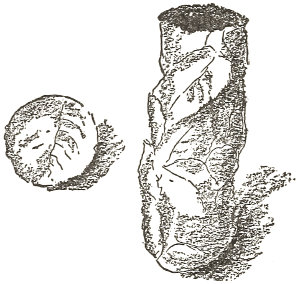
When the row of cells is finished, the entrance to the gallery must be blocked up with a safety stopper. The Bee then returns to the free and easy use of her scissor-jaws which we noticed at the beginning when she was fencing off the back part of the Earthworm’s too-deep burrow; she cuts out of the foliage irregular pieces of different shapes and sizes; and with all these pieces, very few of which fit at all closely the opening to be blocked, she succeeds in making a door which cannot be forced open, thanks to the huge number of layers.
Let us leave the Leaf-cutter to finish laying her eggs, and consider for a moment her skill as a cutter. What model does she use, when cutting her neat ovals out of the delicate Robinia-leaves, which she uses for her cells? What pattern that she carries in her mind guides her scissors? What system of measurement tells her the correct size? One would like to picture the insect as a living pair of compasses, able to trace curves by swaying her body, even as our arm traces a circle by swinging from the shoulder. This explanation might do if she made only one size of oval; but she makes two, large and small. A pair of compasses which changes its radius of its own accord and alters the curve according to the plan before it appears to me an instrument somewhat difficult to believe in. Besides, the Bee cuts out round pieces also. These rounds, for the most part, fit the mouth of her jar almost exactly. When the cell is finished, the Bee flies hundreds of yards away to make the lid. She arrives at the leaf from which the round pieces are to be cut. What picture, what recollection has she of the pot to be covered? Why, none at all; she has never seen it; she does her work underground, in utter darkness! At the utmost, she can only remember how it felt.
And yet the circular piece to be cut out must be of a certain size: if it were too large, it would not go in; if too small, it would close badly, it would slip down on the honey and suffocate the egg. The Bee does not hesitate a moment. She cuts out her circle as quickly as she would cut out any shapeless piece; and that circle, without further measurement, is of the right size to fit the pot. Who can explain this geometry?
One winter evening, as we were sitting round the fire, whose cheerful blaze unloosed our tongues, I put the problem of the Leaf-cutter to my family:
“Among your kitchen utensils,” I said, “you have a pot in daily use; but it has lost its lid, which was knocked over and broken by the cat playing on the shelves. To-morrow is market-day and one of you will be going to Orange to buy the week’s provisions. Would she undertake, without a measure of any kind, with the sole aid of memory, which we would allow her to refresh by a careful examination of the object before starting, to bring back exactly what the pot wants, a lid neither too large nor too small, in short, the same size as the top?”
It was admitted with one accord that nobody would accept such a commission without taking a measure with her, or at least a bit of string giving the width. Our memory for sizes is not accurate enough. She would come back from the town with something that “might do”; and it would be the merest chance if this turned out to be the right size.
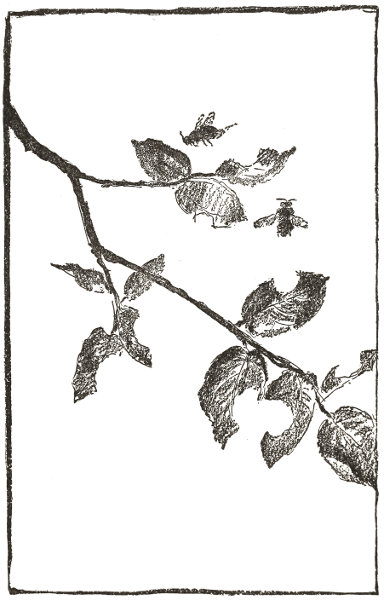
“What pattern that she carries in her mind guides her scissors?”
Well, the Leaf-cutting Bee is even less well off than ourselves. She has no mental picture of her pot, because she has never seen it; she is not able to pick and choose in the crockery dealer’s heap, which acts as something of a guide to our memory by comparison; she must, without hesitation, far away from her home, cut out a disk that fits the top of her jar. What is impossible to us is child’s play to her. Where we could not do without a measure of some kind, a bit of string, a pattern or a scrap of paper with figures upon it, the little Bee needs nothing at all. In housekeeping matters she is cleverer than we are.
The insect excels us in practical geometry. I look upon the Leaf-cutter’s pot and lid as an addition to the many other marvels of instinct that cannot be explained by mechanics; I submit it to the consideration of science; and I pass on.
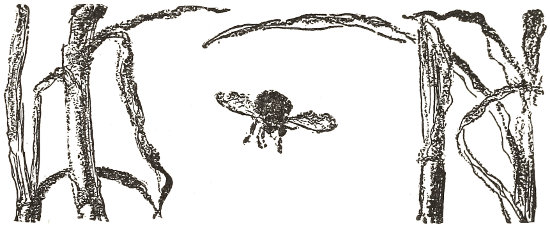
There are many Bees who, like the Leaf-cutters, do not make their own dwellings, but use shelters made by the work of others. Many of the Osmia-bees seize the old homes of the Masons; other honey-gatherers use earthworm galleries, snail-shells, dry brambles which have been made into hollow tubes by the mining Bees, and even the homes of the Digger Wasps burrowed in the sand. Among these borrowers are the Cotton-bees, who fill the reeds with cottony satchels, and the Resin-bees, who plug up snail-shells with gum and resin.
There is a reason for such arrangement. The Bees who work hard to make their homes, such as the Mason-bee, who scrapes hard clay and makes a large cement mansion, the Carpenter-bee, who bores dead wood to a depth of nine inches, and the Anthophora, who digs corridors and cells in the banks hardened by the sun, have no time left to spend in furnishing their cells elaborately. On the other hand, the Bees who take possession of ready-made homes, are artists in interior decorations. There is the Leaf-cutting Bee, who makes her leafy baskets with such skill; the Upholsterer-bee, who hangs her cells with poppy-petals, and the Cotton-bee, who makes the most beautiful purses of cotton.
We have only to look at the Cotton-bee’s nests, to realize that the insect who makes these could not be a digger, too. When newly-felted, and not yet sticky with honey, the wadded purse is very elegant, of a dazzling white. No bird’s-nest can compare with it in fineness of material or in gracefulness of form. How, with the little bales of cotton brought up one by one in her mouth, can the Bee manage to mat all together into one material and then to work this into a thimble-shaped wallet? She has no other tools to work with than those owned by the Mason-bees and the Leaf-cutting Bees; namely, her jaws and her feet. Yet what very different results are obtained!
It is hard to see the Cotton-bees in action, since they work inside the reeds when making the nests. However, I will describe the little that I saw. The Bee procures her cotton from many different kinds of plants, such as thistles, mulleins, the woolly sage and everlastings. She uses only the plants that are dead and dry, however, never fresh ones. In this way she avoids mildew, which would make its appearance in her nests in the mass of hairs still filled with sap.
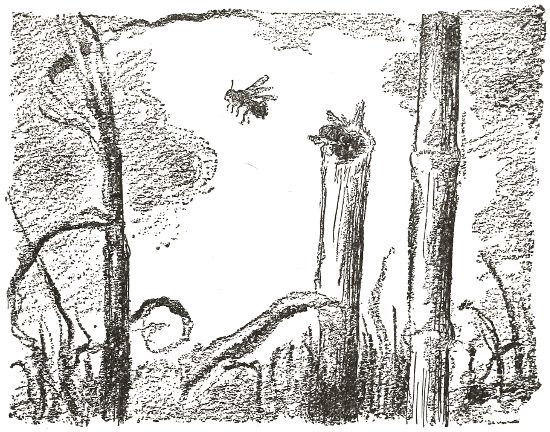
She alights on the plant she wishes to use, scrapes it with her mouth, and then passes the tiny flake to her hind-legs, which hold it pressed against the chest, mixes with it still more down, and makes the whole into a little ball. When this is the size of a pea, it goes back to the mouth, and the insect flies off, with her bale of cotton in her mouth. If we have the patience to wait, we shall see her coming back again and again to the same plant, until her bags are all made.
The Cotton-bee uses different grades of cotton for the different parts of her work. She is like the bird, who furnishes the inside of her nest with wool to make it soft for the little birds, and strengthens the outside with sticks. The Bee makes her cells, the grubs’ nurseries, of the very finest down, the cotton gathered from a thistle; she makes the barrier plug at the entrance of stiff, prickly hairs, such as the coarse bristles scraped from a mullein-leaf.
I do not see her making the cells inside the bramble, but I catch her preparing the plug for the top. With her fore-legs she tears the cotton apart and spreads it out; with her jaws she loosens the hard lumps; with her forehead she presses each new layer of the plug upon the one below. This is a rough task; but probably her general way of working is the same for the finer cells.
Some Cotton-bees after making the plug go even further and fill up the empty space at the end of the bramble with any kind of rubbish that they can find: little pieces of gravel, bits of earth, grains of sawdust, mortar, cypress-catkins, or broken leaves. The pile is a real barricade, and will keep any foe from breaking in.
The honey with which the Cotton-bee whose nest I examined filled the cells was pale-yellow, all of the same kind and only partly liquefied, so that it would not trickle through the cotton bag. On this honey the egg is laid. After a while the grub is hatched and finds its food all ready. It plunges its head in the honey, drinks long draughts, and grows fat. We will leave it there, knowing that after a while it will build a cocoon and turn into a Cotton-bee.
Another interesting Bee who uses a ready-made home is the Resin-bee. In the stone-heaps which have been left from the quarries, we often find the Field-mouse sitting on a grass mattress, nibbling acorns, almonds, olive-stones, apricot-stones, and snail-shells. When he is gone, he has left behind him, under the overhanging stones, a heap of empty shells. Among these, there is always a hope of finding a few plugged up with resin, the nests of this sort of Bee. The Osmia-bees also use snail-shells, but they plug them up with clay.
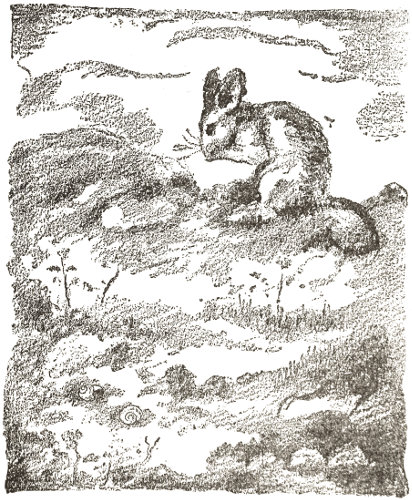
It is hard to tell the Resin-bees’ nests, because the insect often makes its home at the very inside of the spiral, a long way from the mouth. I hold up a shell to the light. If it is quite transparent, I know that it is empty and I put it back to be used for future nests. If the second whorl is opaque, does not let the light through, the spiral contains something. What? Earth washed in by the rain? Remnants of the dead Snail? That remains to be seen. With a little pocket-trowel I make a wide window in the middle of the final whorl. If I see a gleaming resin floor, with incrustations of gravel, the thing is settled: I have a Resin-bee’s nest.

The Bee picks out the particular whorl of the shell which is the right size for her nest. In large shells, the nest is near the back; in smaller shells, at the very front, where the passage is widest. She always makes a partition of a mosaic formed of bits of gravel set in gum. I did not know at first what this gum was. It is amber-colored, semi-transparent, brittle, soluble in spirits of wine, and burns with a sooty flame and a strong smell of resin. These characteristics told me that the Bee uses the resinous drops that ooze from the trunks of various cone-bearing trees. There are plenty of junipers in the neighborhood, and I think that these form the main part of this Bee’s materials. If there were pines, cypresses, and other cone-bearing trees near, she would probably use those.
After the lid of resin and gravel, the Bee stops up the shell still further with bits of gravel, catkins and needles of the juniper, and other odds and ends, including a few rare little land-shells. This is the secondary barrier, to make the shell still safer for her nest. The Cotton-bee uses the same sort of barrier in the bramble. The Resin-bee uses it only in the larger shells, where there is much vacant space; in the smaller ones, where her nest reaches nearly to the entrance, she does without it.
The cells come next, farther back in the spiral. There are usually only two. The front room, which is the larger, contains a male, which in this kind of Bee is larger than the female; the smaller back room houses a female. It is extraordinary how the mother Bee knows the sex of the egg she is laying. This matter has never been explained to the satisfaction of scientists.
The Resin-bee makes a mistake in choosing large shells and not filling them up to the very entrance. The Osmia-bee also makes her nest in snail-shells; she often seizes upon the empty rooms in the Resin-bee’s house and fills them with her mass of cells. She then stops up the entrance with a thick clay stopper. When July comes, this house with the two families of tenants becomes the scene of a tragic conflict. The Resin-bees, in the back rooms, on attaining the adult state, burst their swaddling bands, bore their way through the resin partitions, pass through the gravel barricade and try to release themselves. Alas, the strange family ahead blocks the way! The Osmia inmates are still in the grub stage; they mean to stay in their cells till the next spring. The Resin-bees cannot get out through this second row of clay-stoppered cells; they give up all hope and perish behind the wall of earth. If their mother had only foreseen this danger, the disaster would never have happened; but instinct has failed her for once. Misfortune has not taught the Resin-bees anything through all the generations; and this contradicts the theory of those scientists who say that animals learn through experience.

A slender waist, a slim shape; an abdomen tapering very much at the upper part and fastened to the body as though by a thread; black raiment with a red sash across the belly: there you have a short description of the burrowing Sand-Wasps, who hunt Caterpillars.
The Sand-Wasps choose for their burrows a light soil, easily tunneled, in which the sand is held together with a little clay and lime. Edges of paths, sunny banks where the grass is rather bare—these are the favorite spots. In spring, quite early in April, we see the Hairy Sand-Wasp there.
Its burrow is a straight up-and-down hole, like a well, about as thick as a goose-quill and about two inches deep. At the bottom is a solitary cell, to hold the egg. The Sand-Wasp digs by herself, quietly, without hurrying, without any joyous enthusiasm. As usual, the front feet serve as rakes and the jaws do duty as mining-tools. When some grain of sand is very hard to remove, you hear rising from the well a sort of shrill grating sound made by the quivering of the insect’s wings and of her whole body. Every little while the Wasp appears in the open with a load of dirt in her teeth, some bit of gravel which she usually flies away with and drops at a distance of a few inches, so as not to litter the place.
Some of these grains the Sand-Wasp does not treat as she does the rest. Instead of flying off and dropping them far from the work yard, she removes them on foot and lays them near her burrow. She has a special use for them. When her home is dug, she looks at this little heap of stones to see if there is any there to suit her. If there is not, she explores the neighborhood until she finds what she wants, a small flat stone a little larger in diameter than the mouth of her hole. She carries off this slab in her jaws and lays it, as a temporary door, over the opening of the burrow. To-morrow, when she comes back from hunting, the Wasp will know how to find her home, made safe by this heavy door; she will bring back a paralyzed caterpillar, grasped by the skin of its neck and dragged between her legs; she will lift the slab, which looks exactly like the other little stones around, and which she alone is able to identify; she will let down the game to the bottom of her well, lay her egg and close the house for good by sweeping into the hole all the rubbish, which she has kept near by.
The Hairy Sand-Wasp hunts a particular sort of prey, a kind of large Caterpillar called the Gray Worm, which spends most of its time underground. How does she then get hold of it? We shall see. One day I was returning from a walk when I saw a Hairy Sand-Wasp very busy at the foot of a tuft of thyme. I at once lay down on the ground, close to where she was working. My presence did not frighten the Wasp; in fact, she came and settled on my sleeve for a moment, decided that her visitor was harmless, since he did not move, and returned to her tuft of thyme. As an old stager, I knew what this tameness meant: the Wasp was too busy to bother about me.
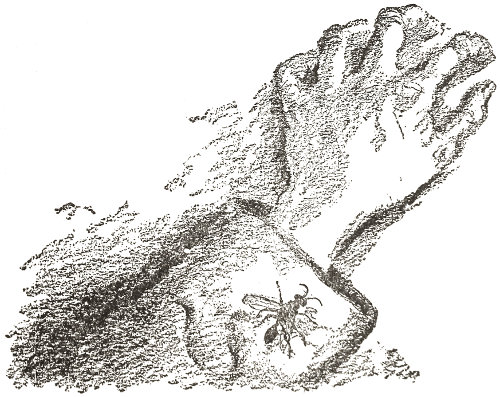
The insect scratched the ground at the foot of the plant, where the root joined the stem, pulled up slender grass rootlets and poked her head under the little clods which she had lifted. She ran hurriedly this way and that around the thyme, looking at every crevice. She was not digging herself a burrow but hunting the game hidden underground; she was like a Dog trying to dig a Rabbit out of his hole.
Presently, excited by what was happening overhead, a big Gray Worm made up his mind to leave his lair and come up to the light of day. That settled him: the Wasp was on the spot at once, gripping him by the skin of his neck and holding tight in spite of his contortions. Perched on the monster’s back, the Wasp bent her abdomen and deliberately, without hurrying, like a clever surgeon, drove her lancet-sting into the back surface of each of the victim’s rings or segments, from the first to the last. Not a ring was left without receiving a stab; all, whether with legs or without, were dealt with in order, from front to back.
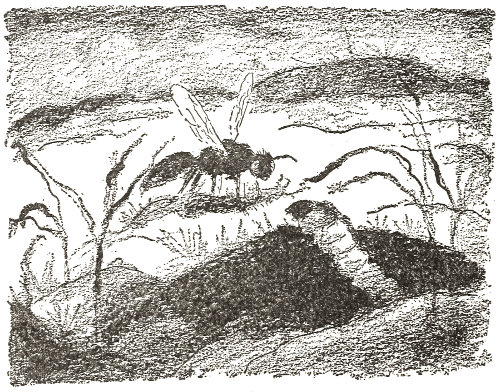
The Wasp’s skill would make science turn green with envy! She knows by instinct what man hardly ever knows; she knows her victim’s nervous system and exactly what nerve centers to strike to make it motionless without killing it. Where does she receive this knowledge? From the power that rules the world, and guides the ignorant by the laws of its inspiration.
I will tell you about another encounter of a Sand-Wasp with a Gray Worm which I witnessed. It was in May, when I detected a Sand-Wasp giving a last sweep of the rake to her burrow, on the smooth, hard path. She had paralyzed her Caterpillar, probably, and left it a few yards away from the home while she made ready the entrance. At last the cave is pronounced spick and span, and the doorway thought wide enough to admit the bulky prey. The Sand-Wasp sets off in search of her captive.
She finds it easily. It is a Gray Worm, lying on the ground: but, alas, the Ants have found it, too; they have already invaded it. The Wasp now scorns it. She will not have anything to do with a Worm which she must share with Ants. To drive them away is impossible; for each one sent to the right-about, ten would return to the attack. So the Wasp seems to think; for she goes on with her hunting, without indulging in useless strife.
She explores the soil within a radius of ten feet from the nest, on foot, little by little, without hurrying; she lashes the ground continually with her antennæ curved like a bow. For nearly three hours, in the heat of the sun, I watch her search. What a difficult thing a Gray Worm is to find, for a Wasp who needs it just at that moment!
It is no less difficult for man. I have a plan. I wish to give the Wasp a Worm in order to see how she paralyzes it.
Favier, my old soldier friend, is there, gardening. I call out to him:
“Come here, quick; I want some Gray Worms!”
I explain the thing to him. He understands at once and goes in search. He digs at the foot of the lettuces, he scrapes among the strawberry-beds, he inspects the iris-borders. I know his sharp eyes and his intelligence; I have every confidence in him. Meanwhile, time passes.
“Well, Favier? Where’s that Gray Worm?”
“I can’t find one, sir.”
“Bother! Then come to the rescue, you others! Claire, Aglaé, all of you! Hurry up, hunt and find!”
The whole family is put at work. All its members become very active. But nothing turns up: three hours pass and not one of us has found the Caterpillar.
The Sand-Wasp does not find it either. I see her hunting persistently in spots where the earth is slightly cracked. She wears herself out in clearing-operations; with a great effort she removes lumps of earth the size of an apricot-stone. These spots are soon given up, however. Then a suspicion comes to me: perhaps the Gray Worm, foreseeing a gathering storm, has dug its way lower down. The huntress Wasp very well knows where it lies, but cannot get it out from its deep hiding-place. Wherever the Sand-Wasp scratches, there must a Gray Worm be; she leaves the place only because she cannot dig deep enough. It was very stupid of me not to have thought of this earlier. Would such an experienced huntress pay any attention to a place where there is really nothing? What nonsense!
I make up my mind to help her. The insect, at this moment, is digging a tilled and absolutely bare spot. It leaves the place, as it has already done with so many others. I myself continue the work, with the blade of a knife. I do not find anything, either; and I leave it. The insect comes back and again begins to scratch at a certain part of my excavations. I understand:
“Get out of that, you clumsy fellow!” the Wasp seems to say. “I’ll show you where the thing lives!”
I dig at the spot she indicates and unearth a Gray Worm. Well done, my clever Sand-Wasp! Did I not say that you would never have raked at an empty burrow?
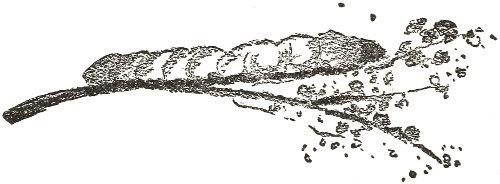
Following the same system, I obtain a second Gray Worm, followed by a third and a fourth. The digging is always done at bare spots that have been turned by the pitchfork a few months earlier. There is absolutely nothing to show the presence of the Caterpillar from without. Well, Favier, Claire, Aglaé, and the rest of you, what have you to say? In three hours you have not been able to dig me up a single Gray Worm, whereas this clever huntress supplies me with as many as I want, once that I have thought of coming to her assistance!
I leave the Wasp her fifth Worm, which she unearths with my help. I will tell in numbered paragraphs the various acts of the gorgeous drama that passes before my eyes. I am lying on the ground, close to the slaughterer, and not one detail escapes me.
1. The Sand-Wasp seizes the Caterpillar by the back of the neck with the curved pincers of her jaws. The Gray Worm struggles violently, rolling and unrolling its body. The Wasp is quite unconcerned: she stands aside and thus avoids the shocks. Her sting strikes the Caterpillar at the joint between the first ring and the head, in the middle of the under side, at a spot where the skin is more delicate. This is the most important blow, the one which will master the Gray Worm and make it more easy to handle.

“The gorgeous drama.”
2. The Sand-Wasp now leaves her prey. She flattens herself on the ground, with wild movements, rolling on her side, twitching and dangling her limbs, fluttering her wings, as though in danger of death. I am afraid that the huntress has received a nasty wound in the contest. I am overcome with emotion at seeing the plucky Wasp finish so piteously. But suddenly the Wasp recovers, smooths her wings, curls her antennæ, and returns briskly to the attack. What I had taken for the convulsions of approaching death was the wild enthusiasm of victory. The Wasp was congratulating herself on the way she had floored the enemy.
3. The Wasp grips the Caterpillar by the skin of the back, a little lower than before, and pricks the second ring, still on the under side. I then see her gradually going back along the Gray Worm, each time seizing the back a little lower down, clasping it with the jaws, those wide pincers, and each time driving the sting into the next ring. In this way are wounded the first three rings, with the true legs; the next two rings, which are legless; and the four rings, with the pro-legs, which are not real legs, but simply little protuberances. In all, nine stings. After the first prick of the needle, the Gray Worm offers but a feeble resistance.
4. Lastly, the Sand-Wasp, opening the forceps of her jaws to their full width, seizes the Caterpillar’s head and crunches it, squeezing it with a series of leisurely movements, without creating a wound. She pauses after each squeezing as if to learn the effect produced; she stops, waits, and begins again. This handling of the brain cannot be carried too far, or the insect would die; and strange to say, the Wasp does not wish to kill the Caterpillar.
The surgeon has finished. The poor patient, the Worm, lies on the ground on its side, half doubled up. It is motionless, lifeless, unable to resist when the Wasp drags it to the burrow, unable to harm the grub that is to feed upon it. This is the purpose of the Wasp’s proceedings. She is procuring food for her babies, which are as yet non-existent. She will drag the Caterpillar to her burrow and lay an egg upon it. When the grub comes out of the egg, it will have the Caterpillar to feed upon. But suppose this Caterpillar were active? One movement of his body would crush the egg against the wall of the cell. No, the Caterpillar must be motionless; but it must not be dead, for if it were, it would speedily decay and be unfit eating for the fastidious little grub. The Wasp, therefore, drives her poisoned sting into the nerve-centers of every segment whose movement could hurt the grub-baby. She does better than that. The victim’s head is still unhurt, the jaws are at work; they might easily, as the Caterpillar is dragged to the burrow, grip some bit of straw in the ground and stop progress. The Caterpillar, therefore, must be rendered torpid, and the Wasp does this by munching his head. She does not use her sting on the brain, because that would kill the Caterpillar; she merely squeezes it enough to make the Caterpillar unconscious.
Though we admire the wonderful skill of the Wasp, we cannot help feeling sorry for the victim, the poor Gray Worm. If we were farmers, however, we should not waste any pity on the Worm. These Caterpillars are a dreadful scourge to agricultural crops, as well as to garden produce. Curled in their burrows by day, they climb to the surface at night and gnaw the base or collar of plants. Everything suits them: ornamental plants and edible plants alike, flower-beds, market-gardens, and plants in fields. When a seedling withers without apparent cause, draw it to you gently; and the dying plant will come up, but maimed, cut from its root. The Gray Worm has passed that way in the night; its greedy jaws have cut the plant. It is as bad as the White Worm, the grub of the Cockchafer. When it swarms in a beet-country, the damage amounts to millions. This is the terrible enemy against which the Sand-Wasp comes to our aid. Let us not feel too sorry for it!
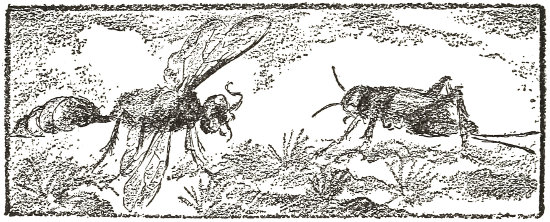
At the end of July the Yellow-winged Wasp tears the cocoon that has protected her till then and flies out of her underground cradle. During the whole of August she is often seen flitting about the fields in search of honey. But this careless life does not last long, for by the beginning of September the Wasp must begin to dig her burrows and search for game for her family. For her burrows she usually chooses some sandy soil on the high banks by the side of the road. One thing is necessary: the site must receive plenty of sunshine.
Ten or twelve Yellow-winged Wasps usually work together. They scrape the earth with their fore-feet like mischievous puppies. At the same time, each worker sings her glad song, which is a shrill noise, constantly broken off and rising higher or sinking lower in a regular rhythm. One would think they were a troop of merry companions singing to encourage each other in their work. Meanwhile, the sand flies, falling in a fine dust on their quivering wings; and the too-large gravel, removed bit by bit, rolls far away from the work yard. If a piece seems too heavy to be moved, the insect gets up steam with a shrill note which reminds one of the workman’s “Hoo!”
Soon the cave takes shape; the insect dives into it bodily. We still hear underground her untiring song, while every little while we catch a glimpse of her hind-legs, pushing a torrent of sand backwards to the mouth of the burrow. From time to time the Wasp comes outside the entrance to dust herself in the sun, and to rid herself of grains of sand. In spite of these interruptions, she manages to dig the gallery in two or three hours. Then she comes to her threshold to chant her triumph and give the finishing polish to her work by smoothing out some unevenness and carrying away a speck or two of earth.
There are two, three, or four cells in the Yellow-winged Wasp’s burrow, in each of which lies an egg. But the Wasp does not content herself with one burrow: she digs about ten, all in the month of September, and she has to get food for all of them. She has not a moment to lose, when, in so short a time, she has to dig her burrows, procure a dozen Crickets or more for food for her families, and stop the burrows up again. Besides, there are gray days and rainy days during the month, when she cannot work.
The Yellow-winged Wasp is not content with comparatively defenseless Beetles and Caterpillars; she hunts the powerful Cricket. Watch her chasing one. The terrified Cricket takes to flight, hopping as fast as he can; the Wasp pursues him hot-foot, reaches him, rushes upon him. There follows, in the dust, a confused struggle, wherein each fighter is in turn victor and vanquished, on top and underneath. The issue seems doubtful. But at last the Wasp triumphs. In spite of his vigorous kicks, in spite of the snaps of his pincer-like jaws, the Cricket is laid low and stretched upon his back.
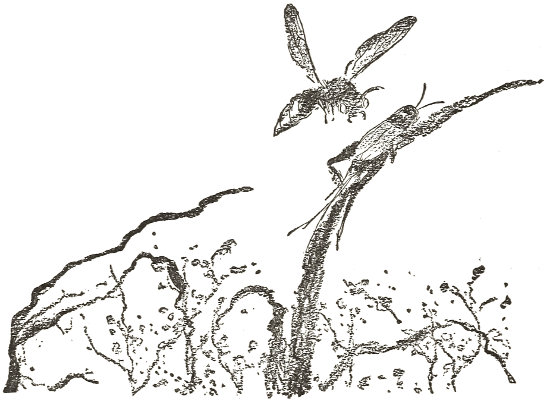
The Wasp places herself upon him, belly to belly, but in the opposite direction. She grasps one of the threads at the tip of the Cricket’s abdomen with her mouth and masters with her fore-legs the convulsive efforts of his thick hinder-thighs. At the same time her middle-legs hug the heaving sides of the beaten insect, and her hind-legs force the joint of the neck to open wide. The Wasp then curves herself outward so as to offer the Cricket no chance to bite her, and drives her poisoned sting once into the victim’s neck, next into the joint of the front two rings of the thorax, or part next the neck, and lastly towards the abdomen. In less time than it takes to tell, the murder is done; and the Wasp, after making herself tidy again, gets ready to haul home the victim.
You must acknowledge she knows how to fight, better even than the Wasps who attack Beetles, or those who capture Caterpillars. Those insects cannot fly, they have no defensive weapons. What a difference between them and the Cricket! The Cricket is armed with dreadful jaws, capable of eating the vitals out of the Wasp if they succeed in seizing her; he has a pair of powerful legs, regular clubs bristling with a double row of sharp spikes, which can be used by the Cricket either to hop out of his enemy’s reach, or to send her sprawling with brutal kicks.
Notice, therefore, the precautions the Wasp takes before setting her sting in motion. She turns the Cricket upon his back so that he cannot use his hind-legs to escape. She controls his spurred legs with her fore-feet, so that he cannot kick her; and she keeps his jaws at a distance with her own hind-legs. She makes him motionless by grasping one of the threads at the end of the abdomen. An athlete, an expert wrestler, could not do better.
Consider, also, her science. She wishes to paralyze the prey without killing it, so that it will remain in a fit condition for food for her babies for many weeks. If she should leave the Cricket any power of motion, it would knock the eggs off; if she killed it entirely, it would decay. How does she produce this paralysis? She does just what a surgeon would advise her to do; she strikes the nerve-centers of the different parts of the Cricket’s body which are likely to do harm, the three nervous centers that set the legs in motion.
If we look at the Cricket a week, two weeks, or even longer after the murder, we shall see the abdomen moving slightly, a sign that he is still alive.
After the Wasp has paralyzed her Cricket, she grips him with her feet, holding also one of his antennæ in her mouth, and in this manner flies off with him. She has to stop sometimes to take a minute’s rest. Then she once more takes up her burden and, with a great effort, carries him in one flight almost to her home. The Wasp I am watching alights in the middle of a Wasp village. She makes the rest of her way on foot. She bestrides her victim and advances, bearing her head proudly aloft and hauling the Cricket, who trails between her legs, by the antennæ held between her jaws. If the ground is bare, she has an easy time; but sometimes she meets with some spreading grass shoots, and then it is curious to see her marches and countermarches, her repeated attempts to get past, which she finally does by some means or other, either by flight or by taking another path.
At last she reaches home and places the Cricket so that his antennæ exactly touch the mouth of the burrow. The Wasp then leaves him and goes down hastily to the bottom of the cave, perhaps to see that everything is as it should be and no other Wasp has made her nest there. A few seconds later she reappears, showing her head out of doors and giving a little cry of delight. The Cricket’s antennæ are within her reach; she seizes them, and the game is brought quickly down to the lair.
When the Yellow-winged Wasp has stacked up three or four Crickets for each cell, she lays an egg on one of them and closes the burrow. She does this by sweeping the heaped-up sand outside the door down the burrow. She mixes fair-sized bits of gravel with the sand to make it stronger. If she cannot find gravel of the right size within reach, she goes and searches in the neighborhood, and seems to choose the pieces as carefully as a mason would choose the chief stones for his building. In a few moments she has closed up the underground dwelling so carefully that nothing remains to show where it has been. Then she goes on, digs another burrow, catches game for it, and walls it up. And so on. When she is through laying all her eggs, she goes back to the flowers, leading a careless, wandering life until the first cold snap puts an end to her existence, which has been so full of duties and excitements.
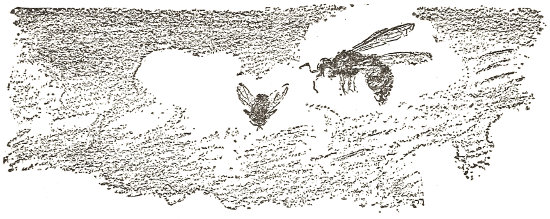
You have read about the Wasps who store up paralyzed Caterpillars and Crickets for their babies’ food, then close up the cells and fly away; now you shall hear about a Wasp who feeds her children with fresh food from day to day. This is the Bembex, or the Fly-hunting Wasp, as I shall call her.
This Wasp digs her burrows in very soft, light sand, under a blazing sun and a blue sky. I go out and watch her sometimes on an unshaded plain where it is so hot that the only way to avoid sunstroke is to lie down at full length behind some sandy knoll, put one’s head down a rabbit-burrow, or provide one’s self with a large umbrella. The latter is what I did. If the reader will sit with me under the umbrella at the end of July, he will see the following sight.
A Fly-hunting Wasp arrives suddenly and alights, without any hesitation, at a spot which to my eyes looks exactly like the rest of the sandy surface. With her front feet, which are armed with rows of stiff hairs and remind one at the same time of a broom, a brush, and a rake, she works at clearing her underground dwelling. The insect stands on her four hind-legs, while the front ones first scratch and then sweep the shifting sand. She shoots the sand backwards so fast that it gushes in a curve like a stream of water, falling to the ground seven or eight inches away. This spray of dust is kept up evenly for five or ten minutes at a time by the swift, graceful Wasp.
Mingled with this dust are tiny bits of wood, decayed leaf stalks, particles of grit and other rubbish. The Wasp picks them up in her mouth and carries them away. This is really the purpose of her digging. She is sifting out the sand at the entrance to her home, which is all ready underground, having been dug some time before. The Wasp wishes to make the sand at the entrance to her burrow fine, light, and free from any obstacle, so that when she alights suddenly with a Fly for her children, she can dig an entrance to her home quickly. She does this work in her spare time, when her larva has enough food to last it for a while, so that she does not need to go hunting. She seems happy as she works so fast and eagerly, and who knows that she is not expressing in this way her mother’s satisfaction in watching over the roof of her house where her baby lives?
If we should take a knife and dig down into the sand where the Wasp-mother is scratching, we should find, first, an entrance corridor, as wide as one’s finger, and perhaps eight to twelve inches long, and then a room, hollowed out down below where the sand is damper and firmer. It is large enough to contain two or three walnuts; but all it does hold at present is a Fly, a golden-green Greenbottle, with a tiny white egg laid on the side. This is the Wasp’s egg. It will hatch out in about twenty-four hours, into a little worm, which will feed on the dead Fly. For the Fly is dead, and not paralyzed, as the food of other Wasp-babies often is.
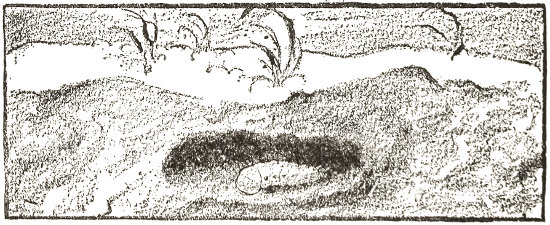
At the end of two or three days the Wasp-grub will have eaten up the little Fly. Meanwhile the mother Wasp remains in the neighborhood and you see her sometimes feeding herself by sipping the honey of the field flowers, sometimes settling happily on the burning sand, no doubt watching the outside of the house. Every now and then she sifts the sand at the entrance; then she flies away for a while. But, however long she may stay away, she never forgets the young larva who has food enough to last only a short time; her mother’s instinct tells her the hour when the grub has finished its food and wants more. She therefore returns to the nest, which, you must remember, does not show in the least from the surface of the ground, as the shifting sand has filled in the entrance; she knows, however, exactly where to look for it; she goes down into the earth, this time carrying a larger piece of game. After leaving this in the underground room she again leaves the house and waits outside until the time comes to serve a third course. This is not long, for the little worm is getting a larger appetite all the time. Again the mother appears with another Fly.
For nearly two weeks, while the larva is growing up, the meals thus follow in succession, one by one, as needed, and coming closer together as the infant grows larger. Towards the end of the two weeks, the mother is kept as busy as she can be satisfying her hungry child, now a large, fat grub. You see her at every moment coming back with a fresh capture, at every moment setting out again upon the chase. She does not cease her efforts until the grub is stuffed full and refuses its food. I have counted and found that sometimes the grub will eat as many as eighty-two Flies.
I have wondered sometimes why this Wasp does not lay up a store of food, as the other Wasps do, close the door of her burrow and fly away, instead of waiting about, as she does so patiently. I realize that she does not do so because her Flies would not keep; they would spoil and be unfit for eating. But why does she kill the Fly instead of paralyzing it? Possibly because the Fly would not make a satisfactory preserved food; it is so slight and frail, it would shrivel up and there would be nothing of it; it must be eaten fresh to be worth anything. Another reason almost certainly is that the Fly has to be captured very quickly, on the wing. There is not time for the Wasp to aim her sting, as the Wasps do who are killing clumsy Worms or fat Crickets on the ground. She must attack with claws, mouth or sting wherever she can, and this method of attack kills at once.
It is not easy to surprise a Wasp hunting, as she flies far away from where her burrow lies; but one day I had a quite unexpected experience as I was sitting in the hot sun under my umbrella. I was not the only one to enjoy the shade of the umbrella. Gad-flies of various kinds would take refuge under the silken dome and sit peacefully on every part of the tightly stretched cover. To while away the hours when I had nothing to do, it amused me to watch their great gold eyes, which shone like carbuncles under my umbrella; I loved to follow their solemn progress when some part of the ceiling became too hot and obliged them to move a little way on.
One day, bang! The tight cover resounded like the skin of a drum. Perhaps an oak had dropped an acorn on the umbrella. Presently, one after the other, bang, bang, bang! Can some practical joker be flinging acorns or little pebbles at my umbrella? I leave my tent and look around: nothing! I hear the same sharp sounds again. I look up at the ceiling and the mystery is explained. The Fly-hunting Wasps of the neighborhood, who all eat Gad-flies, had discovered the rich game that was keeping me company and were impudently coming into my shelter to seize the Flies on the ceiling. Things were going to perfection: I had only to sit still and look.
Every moment a Wasp would enter, swift as lightning, and dart up to the silken ceiling, which resounded with a sharp thud. Some rumpus was going on aloft, where so lively was the fray that one could not tell which was attacker, which attacked. The struggle did not last long: the Wasp would soon retire with a victim between her legs. The dull herd of Gad-flies would not leave the dangerous shelter. It was so hot outside! Why get excited?

“One day, bang!”
Let us watch the Wasp as she returns to the burrow with her capture held under her body between her legs. As she draws near her home, she makes a shrill humming, which has something plaintive about it and which lasts until the insect sets foot to earth. The Wasp hovers above the sand and then dips down, very slowly and cautiously, all the time humming. If her keen eyes see anything unusual, she slows up in her descent, hovers for a second or two, goes up again, comes down again and flies away, swift as an arrow. We shall see in a few moments what it is that makes her hesitate. Soon she is back again, looks at things once more from a height, then comes down slowly and alights at a spot which looks exactly like the rest of the sandy surface.
I think she has landed more or less on chance, and will now look about for the entrance to her home. But no; she is exactly over her burrow. Without once letting go her prey, she scratches a little in front of her, gives a push with her head, and at once enters, carrying the Fly. The sand falls in, the door closes, and the Wasp is at home. It makes no difference that I have seen this Wasp return to her nest hundreds of times; I am always astonished to behold the keen-sighted insect find without hesitation a door which does not show at all.
The Wasp does not always hesitate in the air before alighting at her house, and when she does, it is because she sees her nest is threatened by a very grave danger. Her plaintive hum shows anxiety; she never gives it when there is no peril. But who is the enemy? It is a miserable little Fly, feeble and harmless in appearance, whom we have mentioned in another chapter. The Wasp, the scourge of the Fly-tribe, the fierce slayer of large Gad-flies, does not enter her home because she sees herself watched by another Fly, a tiny dwarf, who would make scarcely a mouthful for her larvæ.
I feel just as I should if I saw my Cat fleeing in terror from a Mouse. Why does the Wasp not pounce upon the little wretch of a Fly and get rid of her? I do not know. It must be because this wretched little Fly has her tiny part to play in the universe, as well as the Wasp. These things are ordered somehow, in a way we do not understand.

As I shall mention elsewhere, this is the Fly that lays her eggs on the game the Wasp puts in the nest for her own baby; and the Fly’s offspring eat the food of the Wasp-grub, and sometimes eat the grub itself, if provisions are scarce. The way the Fly manages her business is interesting. She never enters the Wasp’s burrow, but she waits with the greatest patience for the moment when the Wasp dives into her home, with her game clasped between her legs. Just as she has half her body well within the entrance and is about to disappear underground, the Fly dashes up and settles on the piece of game that projects a little way beyond the hinder end of the Wasp; and while the latter is delayed by the difficulty of entering, the former, with wonderful swiftness, lays an egg on the prey, or even two or three in quick succession. The hesitation of the Wasp, hampered by her load, lasts but the twinkling of an eye. No matter: the Gnat has accomplished what she wished to, and now she goes and squats in the sun, close to the burrow, and plans fresh deeds of darkness.
A number of these Flies, usually three or four, are apt to station themselves on the sand at one time near a burrow, of which they well know the entrance, carefully hidden though it be. Their dull-brown color, their great blood-red eyes, their astonishing patience, have often reminded me of a picture of brigands, clad in dark clothes, with red handkerchiefs around their heads, waiting in ambush for an opportunity to hold up some travelers.
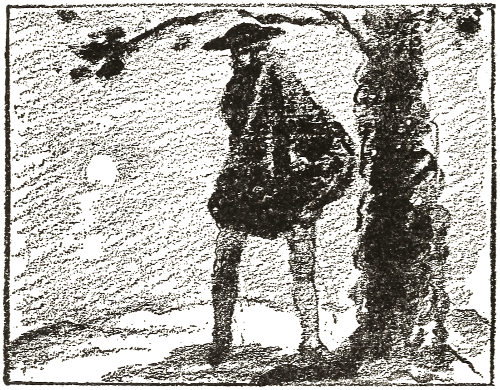
It is when the poor Wasp sees these brigands that she hesitates. At last she comes nearer, however. The Midges then take flight and follow behind the Wasp. If she turns, they turn also, so as to keep exactly behind her; if she advances, they advance; if she retreats, they retreat. She cannot keep them off. At last she grows weary and alights; they also alight, still behind her. The Wasp darts off again, with an indignant whimpering; the Midges dart after her. The Wasp tries one more way to get rid of them. She flies far away at full speed, hoping that they will follow and lose their way. But they know too much for that. They settle down on the sand again near the burrow and wait for her to come back. Come she does; the pursuit begins all over again; the mother’s patience is worn out, and at last they have a chance to lay their eggs as she goes into the burrow.
We shall end our chapter with the story of the Wasp-grub to whom no accidents happen, into whose burrow no nasty Fly-eggs enter. For two weeks it eats and grows; then it begins to weave its cocoon. It has not very much silk in its body to use for this, so it uses grains of sand to strengthen it. First it pushes away the remains of its food and forces them into a corner of the cell. Then, having swept its floor, it fixes to the different walls of its room threads of a beautiful white silk, forming a web which makes a kind of scaffold for the next work.
It then weaves a hammock of silk in the center of the threads. This hammock is like a sack open wide at one end and closed at the other in a point. The grub, leaning half out of its hammock, picks up the sand almost grain by grain with its mouth. If any grain found is too large, it is thrown away. When the sand is sorted in this way, the grub brings some into the hammock in its mouth, and begins to spread it in an even layer on the lower side of the hammock-sack; it adds grains also to the upper side, fixing them in the silk as one would place stones in putty.
The cocoon is still open at one end. It is time to close it. The grub weaves a cap of silk which fits the mouth of the sack exactly, and lays grains of sand one by one upon this foundation. The cocoon is all finished now, except that the grub gives some finishing touches to the inside by glazing the walls with varnish to protect its delicate skin from the rough sand. It then goes peacefully to sleep, to wait for its transformation into a Wasp like its mother.
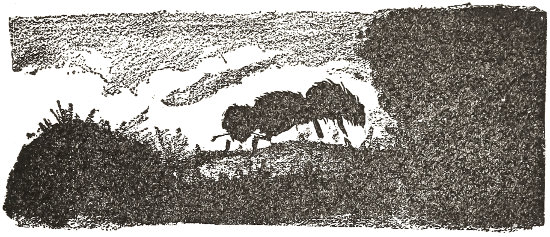
In August or September, let us go into some gorge with bare and sun-scorched sides. When we find a slope well-baked by the summer heat, a quiet corner with the temperature of an oven, we shall call a halt; there is a fine harvest to be gathered here. This tropical land is the native soil of a host of Wasps and Bees, some of them busily piling the household provisions in underground warehouses—here a stack of Weevils, Locusts or Spiders, there a whole assortment of Flies, Bees, or Caterpillars,—while others are storing up honey in wallets or clay pots, cottony bags or urns made with pieces of leaves.
With the Bees and Wasps who go quietly about their business, mingle others whom we call parasites, prowlers hurrying from one home to the next, lying in wait at the doors, watching for a chance to settle their family at the expense of others.
It is something like the struggle that goes on in our world. No sooner has a worker by means of hard labor gotten together a fortune for his children than those who have not worked come hurrying up to fight for its possession. To one who saves there are sometimes five, six or more bent upon his ruin; and often it ends not merely in robbery but in black murder! The worker’s family, the object of so much care, for whom that home was built and those provisions stored, is devoured by the intruders. Grubs or insect-babies are shut up in cells closed on every side, protected by silken coverings, in order that they may sleep quietly while the changes needed to make them into full-grown insects take place. In vain are all these precautions taken. An enemy will succeed in getting into the impregnable fortress. Each foe has his special tactics to accomplish this—tactics contrived with the most surprising skill. See, some strange insect inserts her egg by means of a probe beside the torpid grub, the rightful owner; or else a tiny worm, an atom, comes creeping and crawling, slips in and reaches the sleeper, who will never wake again, because the ferocious visitor will eat him up. The interloper makes the victim’s cell and cocoon his own cell and cocoon; and next year, instead of the mistress of the house, there will come from below ground the bandit who stole the dwelling and ate the occupant.
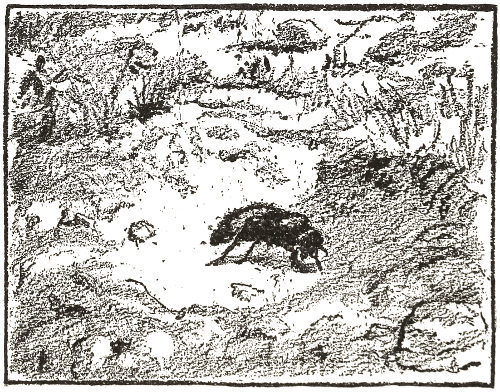
Look at this one, striped black, white, and red, with the figure of a clumsy, hairy Ant. She explores the slope on foot, looks at every nook and corner, sounds the soil with her antennæ. She is a kind of Wasp without wings, named Mutilla, the terrible enemy of the other Wasp-grubs sleeping in their cradles. Though the female Mutilla has no wings, she carries a sharp dagger, or sting. If you saw her, you might think she was a sort of sturdy Ant, gayer in dress than other Ants. If you watched her for some time, you would see her, after trotting about for a bit, stop somewhere and begin to scratch and dig, finally laying bare a burrow underground, of which there was no trace outside; but she can see what we cannot. She goes into the burrow, stays there for a while, and at last reappears to replace the rubbish and close the door as it was at the start. The abominable deed is done: the Mutilla’s egg has been laid in another’s cocoon, beside the slumbering grub or larva on which it will feed.
Here are other insects, all aglitter with gleams of gold, emerald, blue, and purple. They are the humming-birds of the insect-world, and are called the Golden Wasps. You would never think of them as thieves or murderers; but they, too, feed on the children of other Wasps. One of them, half emerald and half pale-pink, boldly enters the burrow of a Fly-hunting Wasp at the very moment when the mother is at home, bringing a fresh piece of game to her babies, whom she feeds from day to day. The elegant criminal, the Golden Wasp who does not know how to dig, takes this moment when the door is open to enter. If the mother were away, the house would be shut up, and the Golden Wasp, that sneak-thief in royal robes, could not get in. She enters, therefore, dwarf as she is, the house of the giantess whose ruin she is planning; she makes her way right to the back, never bothering about the Wasp, with her sting and her powerful jaws. The Wasp-mother either does not know the danger or is paralyzed with terror. She lets the strange Wasp have her way.
Next year, if we open the cells of the poor Fly-hunting Wasp, we shall find some which contain a russet-silk cocoon, the shape of a thimble, with its opening closed with a flat lid. In this silky covering, which is protected by the hard outer shell, is a grub of the Golden Wasp. As for the grub of the Fly-hunter, that grub which wove the silk and encrusted the outer casing with sand, it has disappeared entirely, all but a few tattered shreds of skin. Disappeared how? The Golden Wasp’s grub has eaten it.

One of these splendid-appearing, criminal Golden Wasps is dressed in lapis-lazuli on the front part of the body and in bronze and gold on the abdomen, with a scarf of blue at the end. When one of the Mason-wasps has built on the rock her heap of dome-shaped cells, with a covering of little pebbles set in the plaster, when the grubs have eaten up their store of Caterpillars and hung their rooms with silk, we see the Golden Wasp settle on the outside of the nest. Probably some tiny crack, some defect in the cement, allows her to insert her probe and lay her egg. At any rate, about the end of the following May, the Mason-wasp’s chamber holds a cocoon which again is shaped like a thimble. From this cocoon comes a Golden Wasp. There is nothing left of the Mason-wasp’s grub; the Golden Wasp has gorged herself upon it.
Flies, as we have seen, often act the part of robbers. They are not the least to be dreaded, though they are weak, sometimes so feeble that one cannot take them in his fingers without crushing them. One species called Bombylii are clad in velvet so delicate that the least touch rubs it off. They are fluffs of down almost as frail as a snowflake, but they can fly with wonderful quickness. See this one, hovering motionless two feet above the ground. Her wings vibrate so rapidly one cannot see the motion at all, and they seem to be in repose. The insect looks as though it were hung at one point in space by some invisible thread. You make a movement, and your Fly has disappeared. You look about for her. There is nothing here, nothing there. Then where is she? Close by you. She is back where she started, before you could see where she went to. What is she doing, there in the air? She is up to some mischief; she is watching for a chance to leave her egg where it will feed on some other insect’s provisions. I do not know yet what sort of insect she preys upon, nor what she wishes for her children, whether honey, game, or the grubs themselves.
I know more about the actions of certain tiny, pale-gray Flies, called Tachinæ, who, cowering on the sand in the sun, near a burrow, patiently wait for the hour at which to strike the fell blow. When the different Wasps return from hunting, one kind with her Gad-fly, another with a Bee, another with a Beetle, another with a Locust, at once the Gray Flies are there, coming and going, turning and twisting with the Wasp, always behind her and never losing her. At the moment when the Wasp huntress goes indoors, with her captured game between her legs, they fling themselves on her prey, which is on the point of disappearing underground, and quickly lay their eggs upon it. The thing is done in the twinkling of an eye; before the Wasp has crossed the threshold of her home, the food for her babies holds the germs of a new set of guests, who will feed on it and starve the children of the house to death.
Perhaps, after all, we should not blame too much these insects which feed on others, or on the food of others. An idle human being who feeds at other people’s tables is contemptible; we call him a parasite because he lives at his neighbor’s expense. The insect never does this; that is to say, it does not live on the food of another of the same species. You remember the Mason-bees: not one of the Bees touches another’s honey, unless the owner is dead or has stayed away a long time. The other Bees and Wasps behave in the same way.
What we call parasitism in insects is really a kind of hunting. The Mutilla, for instance, is a huntress, and her prey is the grub of another kind of Wasp, just as the game of this other kind of Wasp may be a Caterpillar or a Beetle. When it comes to this, we are all hunters, or thieves, whichever way you look at it, and Man the greatest of all. He steals the milk from the Calf, he steals the honey from the children of the Bee, just as the Gray Fly takes the food of the Wasps’ babies. She does it to feed her children; and Man helps himself to everything he can find to feed his.
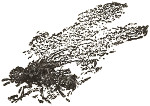
There are various kinds of insects that perform a very useful work in the world, for which they do not always receive credit. When you pass a dead Mole in the fields, and see Ants, Beetles and Flies on it, you shudder and get away from the spot as quickly as possible. You think they are horrid, dirty insects; but they are not; they are busy making the world a cleaner place for you to live in. Let us watch some of these Flies at work, and we shall get an idea of the wonderful things they do in this connection.
You have seen the Greenbottle Flies. They are a beautiful golden-green which shines like metal, and they have red eyes, set in a silver border. They scent dead animals from far away, and rush to lay their eggs in them. A few days afterward, the flesh of the corpse has turned into liquid, in which are thousands of tiny grubs with pointed heads. This is very unpleasant, perhaps you think; but, after all, it is the best and easiest way for dead things to disappear, to be absorbed in the soil and pass on to another form of life. And it is the little Greenbottle worms that produce this liquid.
If the corpse were left undisturbed, it would dry up and take a long while to disappear. The Greenbottle grubs, and the grubs of other Flies as well, have a wonderful power of turning solid things into liquid. When I give the Greenbottle grubs a piece of hard-boiled white of egg to feed upon, they turn it at once into a colorless liquid which looks like water. They have some sort of pepsin which comes out of their mouths and does this work. It is like the gastric juice in our stomach, which dissolves and renders digestible the food we eat. The grubs or worms live on the broth they make in this way until it has all disappeared.
Other Flies whose worms do this work are the Gray Flesh-flies and the big Bluebottles, whom you often see buzzing about the window-panes. Do not let them come near the meat for your dinner, for if they do they will surely make it uneatable. Out in the fields, however, they are in their right element. They give back to life, with all speed, the remains of that which has lived; they change corpses into an essence which enriches our foster-mother earth.
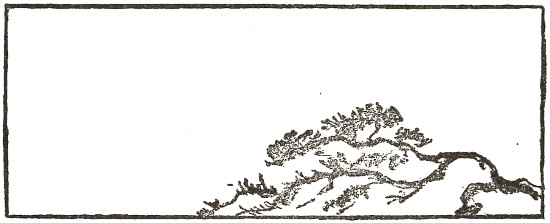
In my piece of waste ground stand some pine-trees. Every year the Caterpillar takes possession of them and spins his great purses in their branches. To protect the pine-needles, which are horribly eaten, I have to destroy the nests each winter with a long forked stick.
You hungry little Caterpillars, if I let you have your way, I should soon be robbed of the murmur of my once so leafy pines. But I am going to make a compact with you. You have a story to tell. Tell it to me; and for a year, for two years or longer, until I know more or less about it, I will leave you undisturbed.
The result of my compact with the Caterpillars is that I soon have some thirty nests within a few steps of my door. With such treasures daily before my eyes, I cannot help seeing the Pine Caterpillar’s story unfolded at full length. These Caterpillars are also called the Processionaries, because they always go abroad in a procession, one following closely after the other.
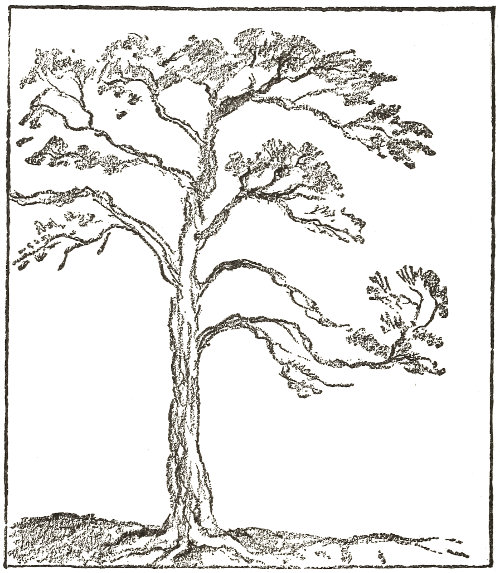
First of all, the egg. During the first half of August, if we look at the lower branches of the pines, we shall discover, here and there on the foliage, certain little whitish cylinders spotting the dark green. These are the Pine Moth’s eggs; each cylinder is the cluster laid by one mother. The cylinder is like a tiny muff about an inch long and a fifth or sixth of an inch wide, wrapped around the base of the pine-needles, which are grouped in twos. This muff has a silky appearance and is white slightly tinted with russet. It is covered with scales that overlap like the tiles on a roof. The whole thing resembles somewhat a walnut-catkin that is not yet full-grown.
The scales, soft as velvet to the touch and carefully laid one upon the other, form a roof that protects the eggs. Not a drop of rain or dew can penetrate. Where did this soft covering come from? From the mother Moth; she has stripped a part of her body for her children. Like the Eider-duck, she has made a warm overcoat for her eggs out of her own down.
If one removes the scaly fleece with pincers the eggs appear, looking like little white-enamel beads. There are about three hundred of them in one cylinder. Quite a family for one mother! They are beautifully placed, and remind one of a tiny cob of Indian corn. Nobody, young or old, learned or ignorant, could help exclaiming, on seeing the Pine Moth’s pretty little spike,
“How handsome!”
And what will strike us most will be not the beautiful enamel pearls, but the way in which they are put together with such geometrical regularity. Is it not strange that a tiny Moth should follow the laws of order? But the more we study nature, the more we realize that there is order everywhere. It is the beauty of the universe, the same under every sun, whether the suns be single or many, white or red, blue or yellow. Why all this regularity in the curve of the petals of a flower, why all this elegance in the chasings on a Beetle’s wing-cases? Is that infinite grace, even in the tiniest details, the result of brutal, uncontrolled forces? It seems hardly likely. Is there not Some One back of it all, Some One who is a supreme lover of beauty? That would explain everything.
These are very deep thoughts about a group of Moth-eggs that will bear a crop of Caterpillars. It cannot be helped. The minute we begin to investigate the tiniest things in nature, we have to begin asking “Why?” And science cannot answer us. That is the strange part of it.
The Pine Moth’s eggs hatch in September. If one lifts the scales of the little muff, one can see black heads appear, which nibble and push back their coverings. The tiny creatures come out slowly all over the surface. They are pale yellow, with a black head twice as large as their body. The first thing they do is to eat the pine-needles on which their nest was placed; then they fall to on the near-by needles.
From time to time, three or four who have eaten as much as they want fall into line and walk in step in a little procession. This is practice for the coming processions. If I disturb them, they sway the front half of their bodies and wag their heads.

“When winter is near they will build a stronger tent.”
The next thing they do is to spin a little tent at the place where their nest was. The tent is a small ball made of gauze, supported on some leaves. Inside it the Caterpillars take a rest during the hottest part of the day. In the afternoon they leave this shelter and start feeding again.
In less than an hour, you see, after coming from the egg, the young Caterpillar shows what he can do. He eats leaves, he forms processions, and he spins tents.
In twenty-four hours the little tent has become as large as a hazel-nut, and in two weeks it is the size of an apple. But it is still only a temporary summer tent. When winter is near, they will build a stronger one. In the meantime, the Caterpillars eat the leaves around which their tent is stretched. Their house gives them at the same time board and lodging. This is a good arrangement, because it saves them from going out, and they are so young and so tiny that it is dangerous for them to go out yet awhile.
When this tent gives way, owing to the Caterpillars having nibbled the leaves supporting it, the family moves on, like the Arabs, and erects a new tent higher up on the pine-tree. Sometimes they reach the very top of the tree.
In the meantime the Caterpillars have changed their dress. They now wear six little bright red patches on their backs, surrounded with scarlet bristles. In the midst of these red patches are specks of gold. The hairs on their sides and underneath are whitish.
In November they begin to build their winter tent high up in the pine at the tip of a bough. They surround the leaves at the end of the bough with a network of silk. Leaves and silk together are stronger than silk alone. By the time it is finished it is as large as a half-gallon measure and about the shape of an egg, with a sheath over the supporting branch. In the center of the nest is a milk-white mass of thickly-woven threads mingled with green leaves. At the top are round openings, the doors of the house, through which the Caterpillars go in and out. There is a sort of veranda on top made of threads stretched from the tips of the leaves projecting from the dome, where the Caterpillars come and doze in the sun, heaped one upon the other, with rounded backs. The threads above are an awning, to keep the sun from being too warm for them.
The inside of the Caterpillars’ nest is not at all a tidy place; it is full of rags, shreds of the Caterpillars’ skins, and dirt.
The Caterpillars stay in their nest all night, and come out about ten o’clock in the morning to take the sun on their terrace or veranda. They spend the whole day there, dozing. Motionless, heaped together, they steep themselves deliciously in warmth and from time to time show their bliss by nodding and wagging their heads. At six or seven o’clock, when it grows dark, the sleepers awake, bestir themselves, and go their several ways over the surface of the nest.
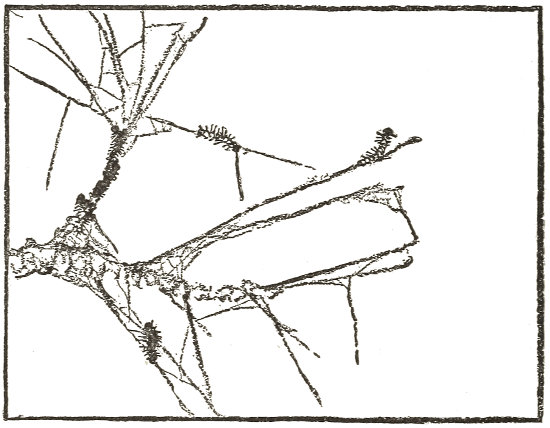
Wherever they go, they strengthen the nest or enlarge it by the threads of silk that come out of their mouths and trail behind them. More green leaves are taken in, and the tent becomes bigger and bigger. They are busy doing this for an hour or two every evening. So far, they have known nothing but summer; but they seem to realize that winter is coming. They work away at their house with an ardor that seems to say:
“Oh, how nice and warm we shall be in our beds here, nestling one against the other, when the pine-tree swings aloft its frosted candelabra! Let us work with a will!”
Yes, Caterpillars, my friends, let us work with a will, great and small, men and grubs alike, so that we may fall asleep peacefully; you with the torpor that makes way for your transformation into Moths, we with that last sleep which breaks off life only to renew it. Let us work!
After the day’s work comes their dinner. The Caterpillars come down from the nest and begin on the pine-needles below. It is a magnificent sight to see the red-coated band lined up in twos and threes on each needle and in ranks so closely formed that the green sprigs of the branch bend under the load. The diners, all motionless, all poking their heads forward, nibble in silence, placidly. Their broad black foreheads gleam in the rays of my lantern. They eat far into the night. Then they go back to the nest, where, for a little longer, they continue spinning on the surface. It is one or two o’clock in the morning when the last of the band goes indoors.
The Pine Caterpillars eat only three kinds of pine: the Scotch pine, the maritime pine, and the Aleppo pine; never the leaves of the other cone-bearing trees, with one exception. In vain I offer them other foliage from the evergreens in my yard: the spruce, the yew, the juniper, the cypress. What! Am I asking them, the Pine Caterpillars, to bite into that? They will take good care not to, in spite of the tempting resinous smell! They would die of hunger rather than touch it! One cone-bearing tree and one only is excepted: the cedar. They will eat the leaves of that. Why the cedar and not the others? I do not know. The Caterpillar’s stomach is as particular as ours, and has its secrets.
To guide them as they wander about their tree, the Caterpillars have their silk ribbon, formed by threads from their mouths. They follow this on their return. Sometimes they miss it and strike the ribbon made by another band of Caterpillars. They follow it and reach a strange dwelling. No matter! There is not the least quarreling between the owners and the new arrivals. Both go on browsing peacefully, as though nothing had happened. And all without hesitation, when bedtime comes, make for the nest, like brothers who have always lived together; all do some spinning before going to rest, thicken the blanket a little, and are then swallowed up in the same dormitory. By accidents like these some nests grow to be very large. Each for all and all for each. So says the Processionary, who every evening spends his little capital of silk on enlarging a shelter that is often new to him. What would he do with his puny skein, if alone? Hardly anything. But there are hundreds and hundreds of them in the spinning-mill; and the result of their tiny contributions is a stuff belonging to all, a thick blanket splendidly warm in winter. In working for himself, each works for the others; and the others work for him. Lucky Caterpillars that know nothing of property, the cause of strife!
There is an old story about a Ram which was thrown into the water from on board ship, whereupon all the sheep leaped into the sea one after the other; “for,” says the teller of the story, “it is the nature of the sheep always to follow the first, wheresoever it goes; which makes Aristotle mark them for the most silly and foolish animals in the world.”
The Pine Caterpillars are even more sheeplike than sheep. Where the first goes all the others go, in a regular string, with not an empty space between them.
They proceed in single file, each touching with its head the rear of the one in front of it. No matter how the one in front twists and turns, the whole procession does the same. Another odd thing: they are all, you might say, tight-rope walkers; they all follow a silken rail. The leading Caterpillar dribbles his thread on the path he makes, the second Caterpillar steps on it and doubles it with his thread; and all the others add their rope, so that after the procession has passed, there is left a narrow white ribbon whose dazzling whiteness shimmers in the sun. This is a sumptuous manner of road-making: we sprinkle our roads with broken stones and level them by the pressure of a heavy steam-roller; they lay over their paths a soft satin rail!
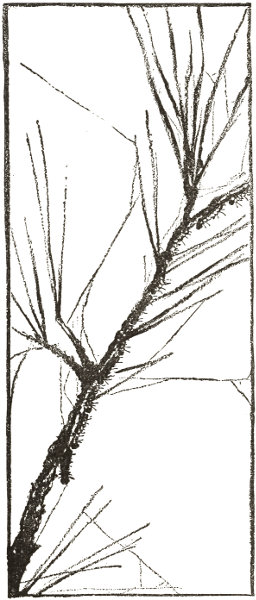
“They Proceed in Single File.”
What is the use of all this luxury? Could they not, like other Caterpillars, walk about without these costly preparations? I see two reasons. It is night when the Processionaries go forth to feed, and they follow a very winding route. They go down one branch, up another, from the needle to the twig, from the twig to the branch, and so on. When it is time to go home, they would have hard work to find their way if it were not for the silken thread they leave behind them. It reminds one of the story of Theseus (in the “Tanglewood Tales,” or the old mythologies), who would have been lost in the Cretan labyrinth if it had not been for the clue of thread which Ariadne gave him.
Sometimes, too, they take longer expeditions by day, marching in procession for thirty yards or so. They are not looking for food; they are off on a trip, seeing the world, perhaps looking for a place to bury themselves later on, in the second stage before they become Moths. In a walk of this distance, the guiding-thread is very necessary.
The guiding-thread, too, brings them all back home to the nest when they are separated, hunting for food in the pine-tree. They pick up their threads, and come hurrying from a host of twigs, from here, from there, from above, from below, back to the group. So the silk is more than a road: it is a social bond that keeps all the members of the community united.
At the head of every procession, long or short, goes the first Caterpillar, the leader. He is leader only by chance; everything depends upon the order in which they happen to line up. If the file should break up, for some reason, and form again, some other Caterpillar might have first rank. But the leader’s temporary duties give him airs of his own. While the others follow passively in a close file, he, the captain, tosses himself about and flings the front of his body hither and thither. As he marches ahead he seems to be seeking his way. Does he really explore the country? Does he choose the best places? Or are his hesitations only the result of the absence of the guiding-thread the rest follow? Why cannot I read what passes under his black, shiny skull, so like a drop of tar? To judge by actions, he has sense enough to recognize very rough places, over-slippery surfaces, dusty places, and, above all, the threads left by other Caterpillars. This is all, or nearly all, that my long acquaintance with the Processionaries has taught me about their brain power.
The processions vary greatly in length. The finest one I ever saw was twelve or thirteen yards long and numbered about three hundred Caterpillars, drawn up with absolute precision in a wavy line. If there were only two in a row, however, the order would still be perfect: the second touches and follows the first.
I make up my mind to play a trick upon the Caterpillars which have hatched out in my greenhouse. I wish to arrange their silken track so that it will join on to itself and form an endless circuit, with no branch tracks leading from it. Will the Processionaries then go round and round upon a road that never comes to an end?
Chance makes it easy for me to arrange something of this sort. On the shelf in my greenhouse in which the nests are planted stand some big palm vases measuring nearly a yard and a half in circumference at the top. The Caterpillars often scale the sides and climb up to the molding which forms a cornice or ledge around the opening. This place suits them for their processions. It provides me with a circular track all ready-made.
One day I discover a numerous troop making their way up and gradually reaching the favorite ledge. Slowly, in single file, the Caterpillars climb the great vase, mount the ledge, and advance in regular procession, while others are constantly arriving and continuing the series. I wait for the string to close up, that is to say, for the leader, who is following the circular track, to return to the point from which he started. This happens in a quarter of an hour. I now have a circle of Caterpillars around the top of the vase.
The next thing is to get rid of the rest of the Caterpillars who are on their way up and who might disturb the experiment; we must also do away with all the silken paths that lead from the top of the vase to the ground. With a thick hair-pencil I sweep away the Caterpillars; with a big brush I carefully rub down the vase and get rid of every thread which the Caterpillars have laid on the march. When these preparations are finished, a curious sight awaits us.
The Caterpillars are going round and round on the ledge at the top of the vase. They no longer have a leader, because the circle is continuous; but they do not know this, and each follows the one in front of him, who he thinks is the leader.
The rail of silk has grown into a narrow ribbon, which the Caterpillars keep adding to. It has no branches anywhere. Will they walk endlessly round and round until their strength gives out entirely?
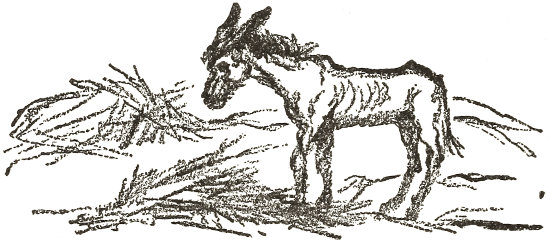
Old-fashioned scholars were fond of quoting the tale of the Donkey who, when placed between two bundles of hay, starved to death because he was unable to decide in favor of either. They slandered the worthy animal. The Donkey, who is no more foolish than any one else, would feast off both bundles. Will my Caterpillars show a little of his common-sense? Will they make up their minds to leave their closed circuit, to swerve to this side or that? I thought that they would, and I was wrong. I said to myself:
“The procession will go on turning for some time, for an hour, two hours perhaps; then the Caterpillars will perceive their mistake. They will abandon the deceptive road and make their descent somewhere or other.”
That they should remain up there, hard pressed by hunger and the lack of shelter, when nothing prevented them from going away, seemed to me unthinkable foolishness. Facts, however, forced me to accept the incredible.
The Caterpillars keep on marching round the vase for hours and hours. As evening comes on, there are more or less lengthy halts; they go more slowly at times, especially as it grows colder. At ten o’clock in the evening the walk is little more than a lazy swaying of the body. Grazing-time comes, when the other Caterpillars come crowding out from their nests to feast on the pine-needles. The ones on the vase would gladly take part in the feast; they must have an appetite after a ten hours’ walk. A branch of pine is not a hand’s breadth away from them. To reach it they have only to go down the vase; and the poor wretches, foolish slaves of their ribbon that they are, cannot make up their minds to do so. At half-past ten I leave them to go to bed; I am sure that during the night they will come to their senses. At dawn I visit them again. They are lined up as on the day before, but motionless. When the air grows a little warmer, they shake off their torpor, revive, and start walking again in their circle.
Things go on as before during the next day. The following night is very cold. The poor Caterpillars spend a bad night. I find them clustered in two heaps on the top of the vase, without any attempt at order. They have huddled together to keep warm. Perhaps, now that they are divided into two parts, one of the leaders, not being obliged to follow a Caterpillar in front of him, will have the sense to break away. I am delighted to see them lining up by degrees into two distinct files, with two leaders, free to go where they please. At the sight of their large black heads swaying anxiously from side to side, I am inclined to think they will leave the enchanted circle. But I am soon undeceived. As the ranks fill out, the two sections of the chain meet and the circle is formed again. Again the Caterpillars march round and round all day.
The next night is again cold, and the Caterpillars gather in a heap which overflows both sides of the fatal ribbon. Next morning, when they awake, some of them who find themselves outside the track actually follow a leader who climbs to the top of the vase and down the inside. There are seven of these daring ones. The rest pay no attention to them and walk round the circle again.
The Caterpillars inside the vase find no food there, and retrace their steps along their thread to the top, strike the procession again, and slip back into the ranks.
Another day passes, and another. The sixth day is warm, and for the first time I see daring leaders, who, drunk with heat, stand on their hind-legs at the extreme edge of the vase and fling themselves forward into space. At last one of them decided to take the plunge. He slips under the ledge and four follow him. They go halfway down the vase, then their courage fails and they climb up again and rejoin the procession. But a start has been made and a new track laid. Two days later, on the eighth day of the experiment, the Caterpillars—now singly, then in small groups, then again in strings of some length—come down from the ledge by starting on this fresh path. At sunset the last of the Caterpillars is back in the nest at the foot.
I figure that they have walked for eighty-four hours, and covered a good deal more than a quarter of a mile while traveling in the circle. It was only the disorder due to the cold nights that ever set them off the track and back to safety. Poor, stupid Caterpillars! People are fond of saying that animals can reason, but there are no beginnings of a reasoning power to be seen in them.
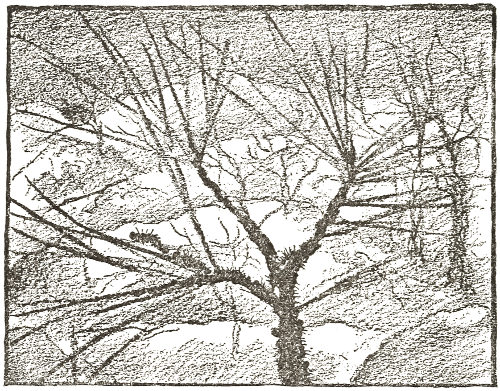
In January the Pine Caterpillar sheds his skin for the second time. He is not nearly so pretty afterwards, but he has gained some new organs which are very useful. The hairs on the middle of his back are now of a dull reddish color, made paler still by many long white hairs mixed in with them. This faded costume has an odd feature. On the back may be seen eight gashes, like mouths, which open and close at the Caterpillar’s will. When the mouths are open there appears in each of them a little swelling, which seems extremely sensitive, for at the slightest irritation it goes in again.
What is the use of these queer mouths and tumors, as we call the little swellings? Certainly not to breathe with, for no one, not even a Caterpillar, breathes from the middle of his back. Let us consider the habits of the Pine Caterpillar, and perhaps we shall find out.
The Pine Caterpillar is most active during the winter, and at night. But if the north wind blow too violently, if the cold be too piercing, if it snow, or rain, or if the mist thicken into an icy drizzle, the Caterpillars prudently stay at home, sheltering under their waterproof tent.
It would be convenient to foresee these disagreeable weather conditions. The Caterpillar dreads them. A drop of rain sets him in a flutter; a snowflake exasperates him. To start for the grazing-grounds at dark of night, in uncertain weather, would be dangerous, for the procession goes some distance and travels slowly. The flock would have a bad time of it before regaining shelter, if they were caught in a sudden storm, such as are frequent in the bad season of the year. Can the Pine Caterpillar possibly be able to foretell the weather? Let me tell how I came to suspect this.
One night some friends came to see my Caterpillars in the greenhouse start on their nightly pilgrimage. We waited till nine o’clock, then went in. But, but ... what is this? Not a Caterpillar outside the nests! Last night and on the nights before they came out in countless numbers; to-night not one is to be seen. We waited till ten o’clock, till eleven, till midnight. Then, very much mortified, I had to send my friends away.
Next day I found that it had rained in the night and again in the morning, and that there was snow on the mountains. Had the Caterpillars, more sensitive than any of us to atmospheric changes, refused to venture out because they had known what was going to happen? After all, why not? I thought I would keep on observing them.
I found that whenever the weather chart in the newspaper announced a coming depression of the atmosphere, such as is made by storms, my greenhouse Caterpillars stayed at home, though neither rain, snow, nor cold could affect them in their indoor shelter. Sometimes they foretold the storm two days ahead. Their gift for scenting bad weather very soon won the confidence of the household. When we had to go into town to buy provisions, we used to consult our Caterpillars the night before; and according to what they did, we went or stayed at home.
The second dress of the Pine Caterpillar, therefore, seems to bring with it the power to foretell the weather. And this power is probably given by the wide mouths, which yawn open to sample the air from time to time and to give a warning of the sudden storm.
When March comes, the Caterpillars leave their nest and their pine-tree and go on their final trip. On the twentieth of March I spent a whole morning watching a file about three yards long, containing about a hundred of the Caterpillars, now much faded as to their coats. The procession toils grimly along, up and down over the uneven ground. Then it breaks into groups, which halt and form independent processions.
They have important business on hand. After two hours or so of marching, the little procession reaches the foot of a wall, where the soil is powdery, very dry, and easy to burrow in. The Caterpillar at the head of the row explores, and digs a little, as if to find out the nature of the ground. The others, trusting their leader, follow him blindly. Whatever he decides will be adopted by all. Finally the leading Caterpillar finds a spot he likes; he stops, and the others break up into a swarming heap. All their backs are joggling pell-mell; all their feet are raking; all their jaws are digging the soil. Little by little, they make a hole in which to bury themselves. For some time to come the tunneled soil cracks and rises and covers itself with little mole-hills; then all is still. The Caterpillars have descended to a depth of three inches, and are weaving, or about to weave, their cocoons.
Two weeks later I dug down and found them there, wrapped in scanty white silk, soiled with dirt. Sometimes, if the soil permits, they bury themselves as deep as nine inches.
How, then, does the Moth, that delicate creature, with her flimsy wings and sweeping antennæ-plumes, make her way above ground? She does not appear till the end of July or in August. By that time the soil is hard, having been beaten down by the rain and baked by the sun. Never could a Moth break her way through unless she had tools for the purpose and were dressed with great simplicity.
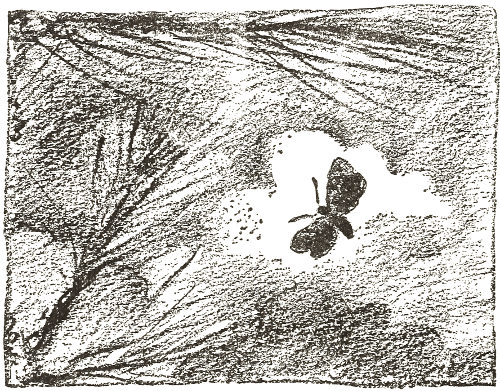
From some cocoons that I kept in test-tubes in my laboratory I found that the Pine Moth, on coming out of the cocoon, has her finery bundled up. She looks like a cylinder with rounded ends. The wings are pressed against her breast like narrow scarfs; the antennæ have not yet unfolded their plumes and are turned back along the Moth’s sides. Her hair fleece is laid flat, pointing backwards. Her legs alone are free, to help her through the soil.
She needs even more preparation, though, to bore her hole. If you pass the tip of your finger over her head you will feel a few very rough wrinkles. The magnifying-glass shows us that these are hard scales, of which the longest and strongest is the top one, in the middle of her forehead. There you have the center-bit of her boring-tool. I see the Moths in the sand in my test-tubes butting with their heads, jerking now in one direction, now in another. They are boring into the sand. By the following day they will have bored a shaft ten inches long and reached the surface.
When at last the Moth reaches the surface, she slowly spreads her bunched wings, extends her antennæ, and puffs out her fleece. She is all dressed now, as nicely as she can be. To be sure, she is not the most brilliant of our Moths, but she looks very well. Her upper wings are gray, striped with a few crinkly brown streaks; her under-wings white; throat covered with thick gray fur; abdomen clad in bright-russet velvet. The tip end of her body shines like pale gold. At first sight it looks bare, but it is not: it is covered with tiny scales, so close together that they look like one piece.
There is something interesting about these scales. However gently we touch them with the point of a needle, they fly off in great numbers. This is the golden fleece of which the mother robs herself to make the nest or muff for her eggs at the base of the pine-needles which we spoke of at the beginning of the story.
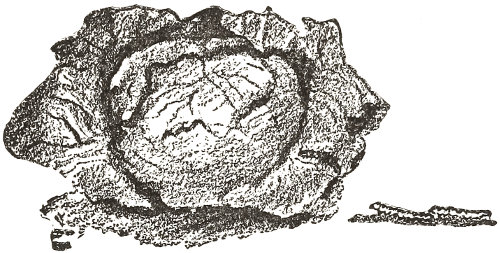
The cabbage is the oldest vegetable we possess. We know that people in classic times ate it, but it goes much further back than that, so that indeed we are ignorant of when or how mankind first began cultivating it. The botanists tell us that originally it was a long-stalked, scanty-leaved, ill-smelling wild plant which grew on ocean cliffs. History pays but little attention to such details: it celebrates the battlefields on which we meet our death, it thinks the plowed fields by which we thrive are not important enough to speak of; it can tell us the names of kings’ favorites, it cannot tell us of the beginning of wheat! Perhaps some day it will be written differently.
It is too bad that we do not know more about the cabbage, for it would have some very interesting things to teach us. It is certainly a treasure in itself. Other creatures think so besides man; and one of these is the Caterpillar of the common Large White Butterfly. This Caterpillar feeds on the leaves of the cabbage and all kinds of cabbagey plants, such as the cauliflower, the Brussels sprout, the kohlrabi, and the rutabaga, all near relatives of the cabbage.
It will feed also on other plants which belong to the cabbage family. They are all of the order of the Cruciferæ, so-called by the botanists because the petals are four in number and arranged in a cross. The White Butterfly lays her eggs only on this order of plants. How she knows them is a mystery. I have studied flowers and plants for fifty years and more, yet, if I wished to find out if a plant new to me was or was not one of the Cruciferæ, and there were no flowers or fruit to guide me, I should believe the White Butterfly’s record on the matter sooner than anything I could find in books.
The White Butterfly has two families a year: one in April and May, the other in September. This is just the time that cabbages are ripe in our part of the world. The Butterfly’s calendar agrees with the gardener’s. When there are provisions to be eaten, the Caterpillars are on hand.

The eggs are a bright orange-yellow and are laid in slabs, sometimes on the upper surface, sometimes on the lower surface of the leaves. The Caterpillars come out of their eggs in about a week, and the first thing they do is to eat the egg-shells, or egg-wrappers, before tackling the green leaves. It is the first time I have ever seen the grub make a meal of the sack in which it was born, and I wonder what reason it has. I suspect as follows: the leaves of the cabbage are waxed and slippery. To walk on them without falling off, the grub needs bits of silk, something for its legs to grip. To make this silk, it needs special food; so it eats the egg-wrapper, which is of a horny substance of the same nature as silk, and probably easily changed to the latter in the stomach of the little grub.

Soon the grubs get hungry for green food, and then the ruin of the cabbages commences. What appetites they have! I served up to a herd of these Caterpillars which I had in my laboratory a bunch of leaves picked from among the biggest cabbages: two hours later nothing was left but the thick middle veins. At this rate the cabbage bed will not last long.
The gluttonous Caterpillars do nothing at all but eat, unless we except a curious motion they sometimes indulge in. When several Caterpillars are grazing side by side, you sometimes see all the heads in the row briskly lifted and as briskly lowered, time after time, all together and as accurately as if they were Prussian soldiers drilling. I do not know whether this is their way of showing that they would fight, if necessary, or a sign of pleasure in the eating and the warm sun. Anyhow, it is the only exercise they take until they are full-grown and fat.
After a whole month of grazing, the Caterpillars at last have enough. They begin to climb in every direction. They walk about anyhow, with the front part of their bodies raised and searching space. It is now the beginning of cold weather, and my Caterpillar guests are in a small greenhouse. I leave the door of the house open. Soon the whole crowd have disappeared.
I find them scattered all over the neighboring walls, some thirty yards off. They are under ledges and eaves, which will serve them as shelters through the winter. The Cabbage-caterpillar is hardy and does not mind the cold.
In these shelters they weave themselves hammock cocoons and turn into chrysales, from which next spring the Moths will come.
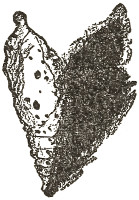
We may be interested in the story of the Cabbage-caterpillar, but we know that there would be not enough cabbages for us if he were allowed full sway. So we are not ill-pleased to hear that there is still another insect who preys upon him and keeps him from being too numerous. If the Cabbage-caterpillar is our enemy, this insect is our friend. Yet she is so small, she works so discreetly, that the gardener does not know her, has not even heard of her. If he were to see her by accident, flitting around the plant which she protects, he would take no notice of her, would not dream of the help she is giving him. I am going to give the tiny midget her deserts.

Scientists call her by a name as long as she is tiny. Part of the name is Microgaster. It is what I shall have to call her, for she has no other that I know of. You must blame the wise scientists who named her that, and not me.
How does she work? Well, we shall see. In the spring, let us look about our kitchen-gardens. We can hardly help noticing against the walls or on the withered grasses at the foot of the hedges some very small yellow cocoons, heaped into masses the size of a hazel-nut. Beside each group lies a Cabbage-caterpillar, sometimes dead and always looking very tattered. These cocoons are the work of the Microgaster’s family, hatched or on the point of hatching; they have been feeding on the poor Caterpillar.
The little Microgaster or Midge is about the size of a Gnat. When the Caterpillar-moth lays her orange eggs on the cabbage leaves, the Midge hastens up and with a slender, horny prickle she possesses, lays her egg inside the film of the Moth’s egg. Often many Midges lay their little eggs in the same Moth’s egg. Judging by the cocoons, there are sometimes as many as sixty-five Midges to one Caterpillar.
As the Caterpillar grows up, it does not seem to suffer; it feeds on the cabbage leaves and, when that is done, makes its pilgrimage as usual to find the place where it will weave its cocoon. It even begins this work; but it is listless, it has no strength; it grows thin and dies. No wonder, with a host of worms of the little Microgaster in its body, drinking its blood! The Caterpillar has obligingly lived till just the time when the Microgaster’s worms are ready to come out. They do so, and begin to weave their cocoons, where they turn into Midges with the long name.

It was an evening long to be remembered, when the Great Peacock Moths came to my house. This Moth is magnificent, the largest in Europe, clad in maroon velvet, with a necktie of white fur. The wings are sprinkled with gray and brown, crossed by a faint zigzag and edged with smoky white, and they have in the center a round patch, a great eye with a black pupil and a many-colored iris containing black, white, chestnut, and purple arcs. The Moth is hatched from a Caterpillar also remarkable in appearance, being yellow with beads of turquoise-blue. It feeds on almond leaves.
Well, on the morning of the sixth of May, a female Great Peacock Moth came out of her cocoon in my presence, on the table of my insect-laboratory. I at once caged her under a wire-gauze bell-jar. I did not think much about the matter. I kept her on general principles, for I am always on the lookout for something to happen.
I was glad afterwards that I had done so. At nine o’clock in the evening, just as the household is going to bed, there is a great stir in the room next to mine. Little Paul, half-undressed, is rushing about, jumping and stamping, knocking the chairs over like a mad thing. I hear him call me:
“Come, quick!” he screams. “Come and see these Moths, big as birds! The room is full of them!”
I hurry in. The child has not exaggerated very much. The room is full of giant Moths. Four are already caught and lodged in a bird-cage. Many others are fluttering on the ceiling.
At this sight, I remember my prisoner of the morning.
“Put on your things, laddie,” I say to my son. “Leave your cage and come with me. We shall see something interesting.”
We run downstairs to go to my study, which is in the right wing of the house. In the kitchen I find the servant, who is also bewildered by what is happening and stands flicking her apron at great Moths whom she took at first for Bats. It seems that the Great Peacock has taken possession of pretty nearly every part of the house.
We enter my study, candle in hand. One of the windows had been left open, and what we see is unforgetable. With a soft flick-flack the great Moths fly around the bell-jar, alight, set off again, come back, fly up to the ceiling and down. They rush at the candle, putting it out with a stroke of their wings; they descend on our shoulders, clinging to our clothes, grazing our faces. The scene suggests a wizard’s cave, with its whirl of Bats. Little Paul holds my hand tighter than usual, to keep up his courage.
How many are there? About twenty in this room. Add to these the number who have strayed into the other parts of the house, and the total cannot be much short of forty. Forty lovers, who have come to pay their respects to the bride born that morning—the princess imprisoned in her tower!
Every night that week the Moths come to court their princess. It is stormy weather, so dark one can hardly see one’s hand before one’s face. Our house is difficult for them to reach. It is hidden by tall plane-trees, pines, and cypresses; clusters of bushy shrubs make a rampart a few steps away from the door. It is through this tangle, in complete darkness, that the Great Peacock has to tack about to reach his lady.
Under such conditions the Brown Owl would not dare leave the hole in his tree. Yet the Moth goes forward without hesitating and passes through without knocking against things. He steers his way so skillfully that he arrives in a state of perfect freshness, with his big wings unharmed, with not a scratch upon him. The darkness is light enough for him.
With a view to his wedding, the one and only object of his life, the Great Peacock is gifted with a wonderful talent. He is able to discover the object of his desire in spite of distance, obstacles, and darkness. For two or three evenings he is allowed a few hours to find his mate. If he cannot find her, all is over. He dies.
The Great Peacock knows nothing of eating. While so many other Moths, jolly companions one and all, flit from flower to flower, dipping into the honeyed cups, he never thinks of refreshment. No wonder he does not live long. Two or three evenings, just time enough to allow the couple to meet, and that is all; the big Moth has lived.
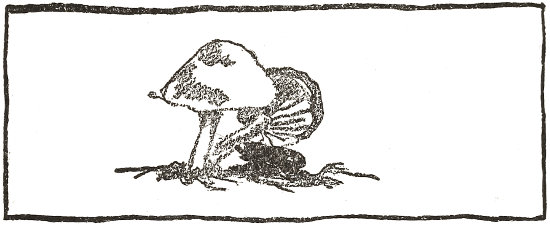
Before we come to the Beetle, I must first tell you about my friend, the Dog, who hunts truffles, which are underground mushrooms. Dogs are quite often used for this purpose, and I have had the good fortune on several occasions to go with a Dog who was a great expert in this line. He was certainly nothing to look at, this artist whom I was so anxious to see at work: just a Dog, placid and deliberate in his ways, ugly, unkempt; the sort of Dog you would never have at your own fireside. Talent and poverty often go hand in hand.
His master, a celebrated truffle-gatherer in the village, was at first afraid that I wanted to steal his secrets and set up a rival business, but when he found that I only made drawings of mushrooms and set down lists of underground vegetable things, he let me join his expeditions.
It was agreed between us that the Dog should act as he pleased and receive a bit of bread as his reward after each discovery, no matter whether the underground mushroom he discovered was a real truffle, the kind people like to eat, or an uneatable one. In no case was the master to drive the dog away from a spot where experience told him there was nothing salable to be found. As far as my studies went, I did not care whether the mushrooms were edible or not.
Conducted in this way, the expedition was very successful. The busy Dog trotted along with his nose to the wind, at a moderate pace. Every little while he stopped, questioned the ground with his nostrils, scratched for a few seconds, without too much excitement, then looked up at his master as if to say:
“Here we are, here we are! On my word of honor as a Dog, there’s a truffle here.”
And he spoke the truth. The master dug at the spot indicated. If the trowel went astray, the Dog showed the man how to put it right by sniffing at the bottom of the hole. The mushroom was always there. A Dog’s nose cannot lie. But he made us gather all sorts of underground mushrooms: the large and the small, the fresh and the decayed, the scented and the unscented, the fragrant and those which were the reverse. I was surprised at my collection, which included most of the underground fungi of the neighborhood.
Is it smell as we understand it that guides the Dog in his search? I do not believe that it is, otherwise he would not point out so many varieties which smell so very different. He must perceive something that we cannot. It is a mistake to compare everything by human standards. There are more sensations in the world than we know of. Such secrets are known to insects better than to other animals, like the Dog or the Pig, who also hunts truffles with its nose. We will hear now about the Truffle-hunting Beetle.
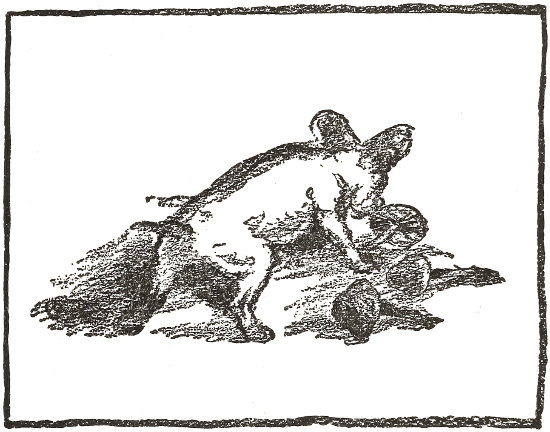
This is a pretty little black Beetle, with a pale and velvety belly, round as a cherry-stone and much the same size. By rubbing the tip of its abdomen against the edge of its wing-cases it makes a soft chirrup like that which little birds make when their mother comes with their food. The male wears a graceful horn on his head.
I found these Beetles in a certain pine-woods where there are plenty of mushrooms. It is a pleasant place, where my whole family like to go in the mild days of autumn. They find everything there: old Magpies’ nests, made of bundles of twigs; Jays squabbling with each other, after filling their crops with acorns on the oaks hard by; Rabbits suddenly starting out of a rosemary bush, showing their little white upturned tails. There is lovely sand for the children to dig tunnels in, sand that is easy to build into rows of huts which we thatch with moss and top with a bit of reed by way of a chimney. And when we are there we lunch off an apple to the sound of the Æolian harps of the breezes softly sighing through the pine-needles!
Yes, for the children it is a real paradise. The grown-ups also enjoy it, and one of my chief enjoyments is watching my Truffle-beetle. His burrows may be seen here and there. The door is left open and surrounded merely by a padding of sand. The burrow is about nine inches deep, going straight down in very loose soil. When I cut into it with a knife, I often find that it is empty. The insect has left during the night, having finished its business there and gone to settle elsewhere. The Truffle-beetle is a tramp, a night-walker, who leaves his home whenever he feels like it and easily gets a new one. Sometimes I do find the insect at the bottom of the pit, always alone, sometimes a male, sometimes a female, never two at the same time. The burrow is not a house for the family; it is a sort of bachelor house, dug for comfort only for the solitary Beetle.
The Beetle in this house is clutching a small mushroom, usually partly eaten. He will not part from it. It is his treasure, his worldly goods. Scattered crumbs tell us that we have caught him feasting.
When we take his prize away from him we find that it is a sort of little underground mushroom, closely related to the truffle.
This throws a light upon the habits of the Beetle and his reason for making new burrows so often. In the calm of the twilight, the little gadabout takes to the fields, chirruping softly as he goes, cheering himself with song. He explores the soil, questions it as to its contents, just as the Dog does when hunting for truffles. His sense of smell tells him when the coveted morsel is underneath, covered by a few inches of sand. Certain of the exact spot where the thing lies, he digs straight down and never fails to reach it. As long as the provisions last, he does not go out again. Blissfully he feeds at the bottom of the well he has dug to reach the mushroom. He does not care whether his door is open or not.
When he has eaten all his food, he moves, looking for more, and to find it he digs a new burrow, which will be given up in its turn. Thus he spends all autumn and the next spring, the seasons for mushrooms, traveling from one of his little hotels to another.
This truffle which the Beetle hunts appears to have no particular odor. How, then, can he detect it from the ground over the place where it is buried? He is a clever Beetle, and we do not know yet just how he manages it.
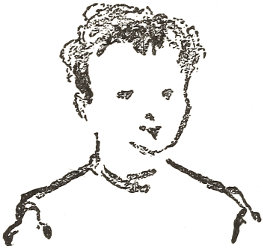
Nowadays, people lay everything to heredity; that is, they say that human beings and animals both receive their special talents from their ancestors, who have perhaps been developing them through many generations. I do not altogether agree with this theory. I am going to tell you my own story to show that I did not inherit my passion for insects from any of my ancestors.
Neither my grandfather nor my grandmother on my mother’s side cared in the least about insects. I did not know my grandfather, but I know that he had a hard time making a living, and I am sure the only attention he paid to an insect, if he met it, was to crush it under his foot. Grandmother, who could not even read, certainly cared nothing about science or insects. If, sometimes, when rinsing her salad at the tap, she found a Caterpillar on the lettuce leaves, with a start of fright she would fling the loathsome thing away.
My other grandparents, my father’s father and mother, I knew well. Indeed, I went to live with them when I was five or six years old, because my father and mother were too poor to take care of me. These grandparents lived on a poverty-stricken farm away out in the country. They did not know how to read; they had never opened a book in their lives. Grandfather knew a great deal about cows and sheep, but nothing about anything else. How dumfounded he would have been to learn that, in the distant future, one of his family would spend his time studying insignificant insects! If he had guessed that that lunatic was myself, seated at the table by his side, what a smack I should have caught in the neck!
“The idea of wasting one’s time with that nonsense!” he would have thundered.
Grandmother, dear soul, was too busy with washing the clothes, minding the children, seeing to the meals of the household, spinning, attending to the chickens, curds and whey, butter, and pickles, to think of anything else. Sometimes, in the evenings, she used to tell us stories, as we sat around the fire, about the Wolf who lived on the moors. I should have very much liked to see this Wolf, the hero of so many tales that made our flesh creep, but I never did. I owe a great deal to you, dear grandmother; it was in your lap that I found consolation for my first sorrows. You have handed down to me, perhaps, a little of your physical vigor, a little of your love for work; but certainly you did not give me my love for insects.
Nor did either of my own parents. My mother was quite illiterate; my father had been to school as a child, he knew how to read and write a little, but he was too busy making a living to have room for any other cares. A good cuff or two when he saw me pinning an insect to a cork was all the encouragement I received from him.
And yet I began to observe, to inquire into things, when I was still almost a baby. My first memories of this tendency will amuse you. One day when I was five or six years old I was standing on the moor in front of our farm, clad in a soiled frieze frock flapping against my bare heels: I remember the handkerchief hanging from my waist by a bit of string,—a handkerchief, I am sorry to say, often lost and replaced by the back of my sleeve.
My face was turned toward the sun. The dazzling splendor fascinated me. No Moth was ever more attracted by the light of the lamp. As I stood there, I was asking myself a question. With what was I enjoying the glorious radiance, with my mouth or my eyes? Reader, do not smile: this was true scientific curiosity. I opened my mouth wide and closed my eyes: the glory disappeared. I opened my eyes and shut my mouth: the glory reappeared. I repeated the performance, with the same result. The question was solved: I had learned by deduction that I see the sun with my eyes. Oh, what a discovery! That evening, I told the whole house about it. Grandmother smiled lovingly at my simplicity: the others laughed at it.
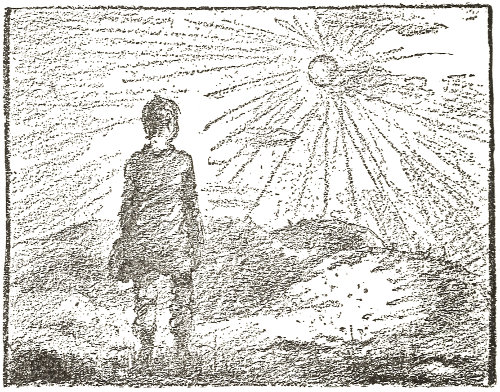
Another find. At nightfall, amidst the neighboring bushes, a sort of jingle attracted my attention, sounding very faintly and softly through the evening silence. Who is making that noise? Is it a little Bird chirping in his nest? We must look into the matter and that quickly. True, there is a Wolf, who comes out of the woods at this time, so they tell me. Let’s go all the same, but not too far: just there, behind that clump of gloom.
I stand on the lookout for long, but all in vain. At the faintest sound of movement in the brushwood, the jingle ceases. I try again next day and the day after. This time, my stubborn watch succeeds. Whoosh! A grab of my hand and I hold the singer. It is not a Bird; it is a kind of Grasshopper whose hind-legs my playfellows have taught me to like; a poor reward for my long hiding. The best part of the business is not the two haunches with the shrimpy flavor, but what I have just learned. I now know, from personal observation, that the Grasshopper sings. I did not tell of my discovery, for fear of the same laughter that had greeted my story about the sun.
Oh, what pretty flowers, in a field close to the house! They seem to smile at me with their great violet eyes. Later on, I see, in their place, bunches of big red cherries. I taste them. They are not nice and they have no stones. What can those cherries be? At the end of the summer, grandfather comes with a spade and turns my field topsy-turvy. From underground there comes, by the basketful and sackful, a sort of round root. I know that root; it abounds in the house; time after time I have cooked it in the peat-stove. It is the potato. Its violet flower and its red fruit are pigeonholed for good and all in my memory.
With an ever-watchful eye for animals and plants, the future observer, the little six-year-old monkey, practiced by himself, all unawares. He went to the flower, he went to the insect, even as the Large White Butterfly goes to the cabbage and the Red Admiral to the thistle. He looked and inquired, drawn by a curiosity whereof heredity did not know the secret.
A little later on I am back in the village, in my father’s house. I am now seven years old; and it is high time that I went to school. Nothing could have turned out better; the master is my godfather. What shall I call the room in which I was to become acquainted with the alphabet? It would be difficult to find the exact word, because the room served for every purpose. It was at once a school, a kitchen, a bedroom, a dining-room and, at times, a chicken-house and a piggery. Palatial schools were not dreamed of in those days; any wretched hovel was thought good enough.
A broad fixed ladder led to the floor above. Under the ladder stood a big bed in a boarded recess. What was there upstairs? I never quite knew. I would see the master sometimes bring down an armful of hay for the Ass, sometimes a basket of potatoes which the housewife emptied into the pot in which the little porkers’ food was cooked. It must have been a sort of loft, a storehouse of provisions for man and beast. Those two rooms were all there were in the whole dwelling.
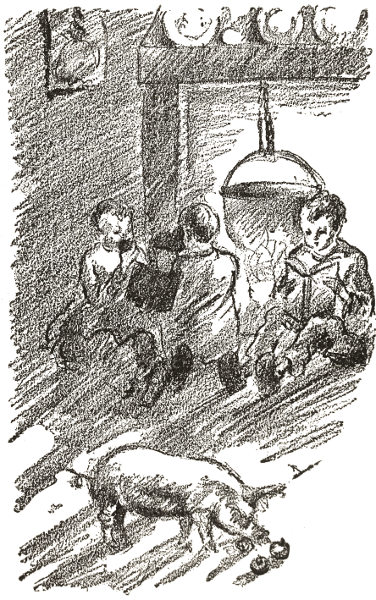
“The fire was not exactly lit for us.”
To return to the lower one, the schoolroom: a window faces south, the only window in the house, a low, narrow window whose frame you can touch at the same time with your head and both your shoulders. This sunny opening is the only lively spot in the dwelling; it overlooks the greater part of the village, which straggles along the slopes of a slanting valley. In the window-recess is the master’s little table.
The opposite wall contains a niche in which stands a gleaming copper pail full of water. Here the parched children can relieve their thirst when they please, with a cup left within their reach. At the top of the niche are a few shelves bright with pewter plates, dishes, and drinking-vessels, which are taken down from their sanctuary on great occasions only.
More or less everywhere, at any spot which the light touches, are crudely colored pictures pasted on the walls. Against the far wall stands the large fireplace. In the middle is the hearth, but, on the right and left, are two breast-high recesses, half wood and half stone. Each of them is a bed, with a mattress stuffed with chaff of winnowed corn. Two sliding planks serve as shutters and close the chest if the sleeper would be alone. These beds are used by the favored ones of the house, the two boarders. They must lie snug in there at night, with their shutters closed, when the north wind howls at the mouth of the dark valley and sends the snow awhirl. The rest is occupied by the hearth and its accessories: the three-legged stools; the salt-box, hanging against the wall to keep its contents dry; the heavy shovel which it takes two hands to wield; lastly, the bellows like those with which I used to blow out my cheeks in grandfather’s house. They are made of a mighty branch of pine, hollowed throughout its length with a red-hot iron. One blows through this channel. With a couple of stones for supports, the master’s bundle of sticks and our own logs blaze and flicker, each of us having to bring a log of wood in the morning, if he would share in the treat.
For that matter, the fire was not exactly lit for us, but, above all, to warm a row of three pots in which simmered the Pigs’ food, a mixture of potatoes and bran. That, in spite of our each giving a log, was the real object of the brushwood-fire. The two boarders, on their stools, in the best places, and we others sitting on our heels, formed a semicircle around those big kettles, full to the brim and giving off little jets of steam, with puff-puff-puffing sounds. The bolder among us, when the master was not looking, would dig a knife into a well-cooked potato and add it to their bit of bread; for I must say that, if we did little work in my school, at least we did a deal of eating. It was the regular custom to crack a few nuts and nibble at a crust while writing our page or setting out our rows of figures.
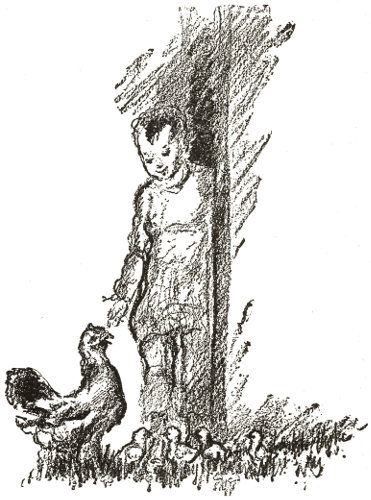
We, the smaller ones, in addition to the comfort of studying with our mouths full, had every now and then two other delights, which were quite as good as cracking nuts. The back-door gave upon the yard where the Hen, surrounded by her brood of Chicks, scratched, while the little Pigs, of whom there were a dozen, wallowed in their stone trough. This door would open sometimes to let one of us out, a privilege which we abused, for the sly ones among us were careful not to close it on returning. Forthwith, the porkers would come running in, one after the other, attracted by the smell of the boiled potatoes. My bench, the one where the youngsters sat, stood against the wall, under the copper pail, and was right in the way of the Pigs. Up they came trotting and grunting, curling their little tails; they rubbed against our legs; they poked their cold pink snouts into our hands in search of a scrap of crust; they questioned us with their sharp little eyes to learn if we happened to have a dry chestnut for them in our pockets. When they had gone the round, some this way and some that, they went back to the farmyard, driven away by a friendly flick of the master’s handkerchief.
Next came the visit of the Hen, bringing her velvet-coated Chicks to see us. All of us eagerly crumbled a little bread for our pretty visitors. We vied with one another in calling them to us and tickling with our fingers their soft and downy backs.
What could we learn in such a school as that! Each of the younger pupils had, or rather was supposed to have, in his hands a little penny book, the alphabet, printed on gray paper. It began, on the cover, with a Pigeon, or something like it. Next came a cross, with the letters in their order. But, if the little book was to be of any use, the master should have shown us something about it. For this, the worthy man, too much taken up with the big ones, had not the time. He gave us the book only to make us look like scholars. We were to study it on our bench, to decipher it with the help of our next neighbor, in case he might know one or two of the letters. Our studying came to nothing, being every moment disturbed by a visit to the potatoes in the stew-pots, a quarrel among playmates about a marble, the grunting invasion of the little Pigs or the arrival of the Chicks.
The big ones used to write. They had the benefit of the small amount of light in the room, by the narrow window, and of the large and only table with its circle of seats. The school supplied nothing, not even a drop of ink; every one had to come with a full set of utensils. The inkhorn of those days was a long cardboard box divided into two parts. The upper compartment held the pens, made of goose- or turkey-quill trimmed with a penknife; the lower contained, in a tiny well, ink made of soot mixed with vinegar.
The master’s great business was to mend the pens—and then to trace at the head of the white page a line of strokes, single letters, or words, according to the scholar’s capabilities. When that is over keep an eye on the work of art which is coming to adorn the copy! With what undulating movements of the wrist does the master’s hand, resting on the little finger, prepare and plan its flight! All at once the hand starts off, flies, whirls; and lo and behold, under the line of writing is unfurled a garland of circles, spirals, and flourishes, framing a bird with outspread wings, the whole, if you please, in red ink, the only kind worthy of such a pen. Large and small, we stood awestruck in the presence of these marvels.
What was read at my school? At most, in French, a few selections from sacred history. Latin came oftener, to teach us to sing vespers properly.
And history, geography? No one ever heard of them. What difference did it make to us whether the earth was round or square! In either case, it was just as hard to make it bring forth anything.
And grammar? The master troubled his head very little about that; and we still less. And arithmetic? Yes, we did a little of this, but not under that learned name. We called it sums. On Saturday evening, to finish up the week, there was a general orgy of sums. The top boys stood up and, in a loud voice, recited the multiplication table up to twelve times. When this recital was over, the whole class, the little ones included, took it up in chorus, creating such an uproar that Chicks and porkers took to flight if they happened to be there.
When all is said, our master was an excellent man who could have kept school very well but for his lack of one thing; and that was time. He managed the property of an absentee landlord. He had under his care an old castle with four towers, which had become so many pigeon-houses; he directed the getting-in of the hay, the walnuts, the apples and the oats. We used to help him during the summer. Lessons at that time were less dull. They were often given on the hay or on the straw; oftener still, lesson-time was spent in cleaning out the dove-cot or stamping on the Snails that had sallied in rainy weather from their fortresses, the tall box borders of the garden belonging to the castle.
Our master was a barber. With his light hand, which was so clever at beautifying our copies with curlicue birds, he shaved the notabilities of the place: the mayor, the parish-priest, the notary. Our master was a bell-ringer. A wedding or a christening interrupted the lessons; he had to ring a peal. A gathering storm gave us a holiday; the great bell must be tolled to ward off the lightning and the hail. Our master was a choir-singer. Our master wound up and regulated the village-clock. This was his proudest duty. Giving a glance at the sun, to tell the time more or less nearly, he would climb to the top of the steeple, open a huge cage of rafters and find himself in a maze of wheels and springs whereof the secret was known to him alone.
With such a school and such a master and such examples, what will become of my natural tastes, as yet so undeveloped? In those surroundings, they seem bound to perish, stifled forever. Yet no, the germ has life; it works in my veins, never to leave them again. It finds food everywhere, down to the cover of my penny alphabet, beautified with a crude picture of a Pigeon which I study much more eagerly than the A B C. Its round eye, with its circlet of dots, seems to smile upon me. Its wing, of which I count the feathers one by one, tells me of flights on high, among the beautiful clouds; it carries me to the beeches raising their smooth trunks above a mossy carpet studded with white mushrooms that look like eggs, dropped by some wandering hen; it takes me to the snow-clad peaks where the birds leave the starry print of their red feet. He is a fine fellow, my Pigeon-friend; he consoles me for the woes hidden behind the cover of my book. Thanks to him, I sit quietly on my bench and wait more or less till school is over.
School out-of-doors has other charms. When the master takes us to kill the Snails in the box borders, I do not always do so. My heel sometimes hesitates before coming down upon the handful which I have gathered. They are so pretty! Just think, there are yellow ones and pink, white ones and brown, all with dark spiral streaks. I fill my pockets with the handsomest, so as to feast my eyes on them at my leisure.
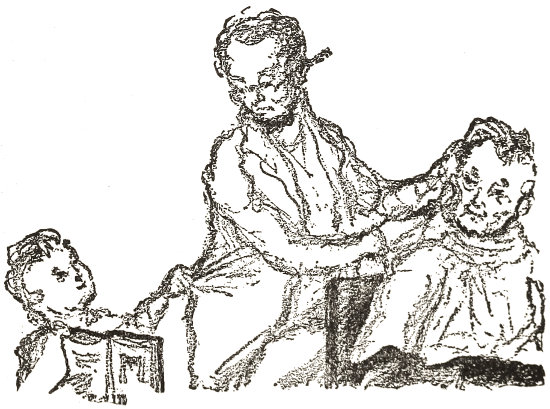
On hay-making days in the master’s field, I strike up an acquaintance with the Frog. Flayed and stuck at the end of a split stick, he serves as bait to tempt the Crayfish to come out of his retreat by the brook-side. On the alder-trees I catch the Hoplia, the splendid Beetle who pales the azure of the heavens. I pick the narcissus and learn to gather, with the tip of my tongue, the tiny drop of honey that lies right at the bottom of the cleft corolla. I also learn that too-long indulgence in this feast brings a headache; but this discomfort in no way impairs my admiration for the glorious white flower, which wears a narrow red collar at the throat of its funnel.
When we go to beat the walnut-trees, the barren grass-plots provide me with Locusts spreading their wings, some into a blue fan, others into a red. And thus the country school, even in the heart of winter, furnished continuous food for my interest in things. My passion for animals and plants made progress of itself.
What did not make progress was my acquaintance with my letters, greatly neglected in favor of the Pigeon. I was still at the same stage, hopelessly behindhand with the alphabet, when my father, by a chance inspiration, brought me home from the town what was to give me a start along the road of reading. It was a large print, price three cents, colored and divided into compartments in which animals of all sorts taught the A B C by means of the first letters of their names. You began with the sacred beast, the Donkey, whose name, Âne, with a big initial, taught me the letter A. The Bœuf, the Ox, stood for B; the Canard, the Duck, told me about C; the Dindon, the Turkey, gave me the letter D. And so on with the rest. A few compartments, it is true, were lacking in clearness. I had no friendly feeling for the Hippopotamus, the Kamichi, or Horned Screamer, and the Zebu, who aimed at making me say H, K, and Z. No matter; father came to my aid in hard cases; and I made such rapid progress that, in a few days, I was able to turn in good earnest the pages of my little Pigeon-book, hitherto so undecipherable. I was initiated; I knew how to spell. My parents marveled. I can explain this unexpected progress to-day. Those speaking pictures, which brought me amongst my friends the beasts, were in harmony with my tastes. I have the animals to thank for teaching me to read. Animals forever!
Luck favored me a second time. As a reward for learning to read, I was given La Fontaine’s Fables, in a popular, cheap edition, crammed with pictures, small, I admit, and very inaccurate, but still delightful. Here were the Crow, the Fox, the Wolf, the Magpie, the Frog, the Rabbit, the Donkey, the Dog, the Cat; all persons of my acquaintance. The glorious book was immensely to my taste, with its skimpy illustrations in which the animals walked and talked. As to understanding what it said, that was another story! Never mind, my lad! Put together syllables that say nothing to you as yet; they will speak to you later and La Fontaine will always remain your friend.
I come to the time when I was ten years old and at Rodez College. I was well thought of in the school, for I cut a good figure in composition and translation. In that classical atmosphere, there was talk of Procas, King of Alba, and of his two sons, Numitor and Amulius. We heard of Cynœgirus, the strong-jawed man, who, having lost his two hands in battle, seized and held a Persian galley with his teeth, and of Cadmus the Phœnician, who sowed a dragon’s teeth as though they were beans and gathered his harvest in the shape of a host of armed men, who killed one another as they rose up from the ground. The only one who survived the slaughter was one as tough as leather, presumably the son of the big back grinder-tooth.
Had they talked to me about the man in the moon, I could not have been more startled. I made up for it with my animals. While admiring Cadmus and Cynœgirus, I hardly ever failed, on Sundays and Thursdays, to go and see if the cowslip or the yellow daffodil was making its appearance in the meadows, if the Linnet was hatching on the juniper-bushes, if the Cockchafers were plopping down from the wind-shaken poplars.
By easy stages I came to Virgil and was very much smitten with Melibœus, Corydon, Menalcas, Damœtas and the rest of them. Within the frame in which the characters moved were exquisite details concerning the Bee, the Cicada, the Turtle-dove, the Crow, the Nanny-goat, and the golden broom. A real delight were these stories of the fields, sung in sonorous verse; and the Latin poet left a lasting impression on my classical recollections.
Then, suddenly, good-by to my studies, good-by to Tityrus and Menalcas. Ill-luck is swooping down on us, relentlessly. Hunger threatens us at home. And now, boy, put your trust in God; run about and earn your penn’orth of potatoes as best you can. Life is about to become a hideous inferno. Let us pass quickly over this phase.
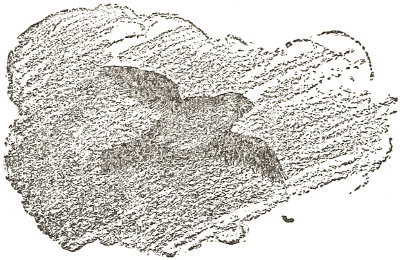
During this sad time, my love for the insects ought to have gone under. Not at all. I still remember a certain Pine Cockchafer met for the first time. The plumes on her antennæ, her pretty pattern of white spots on a dark-brown ground, were as a ray of sunshine in the gloomy wretchedness of the day.
To cut a long story short: good fortune, which never abandons the brave, brought me to the primary normal school at Vaucluse, where I was certain of food: dried chestnuts and chick-peas. The principal, a man of broad views, soon came to trust his new assistant. He left me practically a free hand so long as I satisfied the school curriculum, which was very modest in those days. I was a little ahead of my fellow-pupils. I took advantage of this to get some order into my vague knowledge of plants and animals. While a dictation lesson was being corrected around me, I would examine, in the recesses of my desk, the oleander’s fruit, the snap-dragon’s seed-vessel, the Wasp’s sting and the Ground-beetle’s wing-case.
With this foretaste of natural science, picked up haphazard and secretly, I left school more deeply in love than ever with insects and flowers. And yet I had to give it all up. Natural history could not bring me anywhere. The schoolmasters of the time despised it; Latin, Greek, and mathematics were the subjects to study.
So I flung myself with might and main into higher mathematics: a hard battle, if ever there was one, without teachers, face to face for days on end with abstruse problems. Next I studied the physical sciences in the same manner, with an impossible laboratory, the work of my own hands. I went against my feelings: I buried my natural-history books at the bottom of my trunk.
And so, in the end, I am sent to teach physics and chemistry at Ajaccio College. This time, the temptation is too much for me. The sea, with its wonders, the beach, covered with beautiful shells, the myrtles, arbutus, and other trees; all this paradise of gorgeous nature is more attractive than geometry and trigonometry. I give up. I divide my spare time into two parts. The larger part is devoted to mathematics, by which I expect to make my way in the world; the other is spent, with much misgiving, in botanizing and looking for the treasures of the sea.
We never know what will happen to us. Mathematics, on which I spent so much time in my youth, has been of hardly any good to me; and animals, which I avoided as much as ever I could, are the consolation of my old age.
I met two famous scientists in Ajaccio: Requien, a well-known botanist, and Moquin-Tandom, who gave me my first lesson in natural history. He stayed at my house, as the hotel was full. The day before he left he said to me:
“You interest yourself in shells. That is something, but it is not enough. You must look into the animal itself. I will show you how it’s done.”
He took a sharp pair of scissors from the family work-basket and a couple of needles, and showed me the anatomy of a snail in a soup-plate filled with water. Gradually he explained and sketched the organs which he spread before my eyes. This was the only, the never-to-be-forgotten lesson in natural history that I ever received in my life.
It is time to finish this story about myself. It shows that from early childhood I have felt drawn towards the things of nature. I have the gift of observation. Why and how? I do not know.
We have all of us, men and animals, some special gift. One child takes to music, another is always modeling things out of clay; another is quick at figures. It is the same way with insects. One kind of Bee can cut leaves; another builds clay houses, Spiders know how to make webs. These gifts exist because they exist, and that is all any one can say. In human beings, we call the special gift genius. In an insect, we call it instinct. Instinct is the animal’s genius.

In the disagreeable season of the year, when the insect has nothing to do and retires to winter quarters, an observer who looks in the sunny nooks, grubs in the sand, lifts the stones, or searches the brushwood, will often find something very interesting, a real work of art. Happy are they who can appreciate such treasures! I wish them all the joys they have brought me and will continue to bring me, in spite of the vexations of life, which grow ever more bitter as the years follow their swift downward course.
Should the seekers rummage among the wild grasses in the willow-beds and thickets, I wish them the delight of finding the wonderful object that, at this moment, lies before my eyes. It is the work of a Spider, the nest of the Banded Spider.
In bearing and coloring, this Spider is among the handsomest that I know. On her fat body, nearly as large as a hazel-nut, are alternate yellow, black, and silver sashes, to which she owes her name of Banded. Her eight long legs, with their dark-brown and pale-brown rings, surround her body like the spokes of a wheel.
Any small prey suits her; and, as long as she can find supports for her web, she settles wherever the Locust hops, wherever the Fly hovers, wherever the Dragon-fly dances or the Butterfly flits. Usually, because of the greater abundance of game there, she spreads her web across some brooklet, from bank to bank, among the rushes. She also stretches it sometimes in the thickets of evergreen oak, on the slopes with the scrubby grass, dear to Grasshoppers.
Her hunting-weapon is a large upright web, whose outer boundary is fastened to the neighboring branches by a number of moorings. Her web is like that of the other weaving Spiders. Straight threads run out like spokes of a wheel from a central point. Over these runs a continuous spiral thread, forming chords, or cross-bars, from the center to the circumference. It is magnificently large and magnificently symmetrical.
In the lower part of the web, starting from the center, a thick wide ribbon descends zigzag-wise across the spokes. This is the Spider’s trademark, the way she signs her work of art. Also, the strong silk zigzag gives greater firmness to the web.
The net needs to be firm to hold the heavy insects that light on it. The Spider cannot pick and choose her prizes. Seated motionless in the center of the web, her eight legs widespread to feel the shaking of the network in any direction, she waits for what luck will bring her: sometimes some giddy weak thing unable to control its flight, sometimes some powerful prey rushing headlong with a reckless bound.
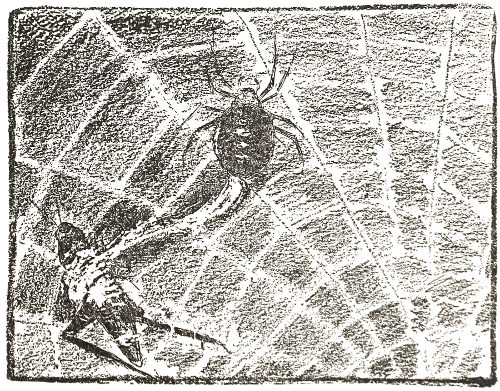
The Locust in particular, the fiery Locust, who releases the spring of his long shanks at random, often falls into the trap. One imagines that his strength ought to frighten the Spider; the kick of his spurred legs should enable him to make a hole then and there in the web and to get away. But not at all. If he does not free himself at the first effort, the Locust is lost.
Turning her back on the game, the Banded Spider works all her spinnerets—the spinneret is the organ with which she makes her silk, and is pierced with tiny holes like the mouth of a watering-pot—at one and the same time. She gathers the silky spray with her hind-legs, which are longer than the others and open wide apart to allow the silk to spread. In this way the Spider obtains not a thread but a rainbow-colored sheet, a sort of clouded fan wherein the threads are kept almost separate. Her two hind-legs fling this sheet, or shroud, by rapid alternate armfuls, while, at the same time, they turn the Locust over and over, swathing it completely.
The gladiator of old times, when forced to fight against powerful wild beasts, appeared in the ring with a rope-net folded over his left shoulder. The animal made its spring. The man, with a sudden movement of his right arm, cast the net as a fisherman does; he covered the beast and tangled it in the meshes. A thrust of the trident, or three-pronged spear, gave the finishing touch to the vanquished foe.
The Spider works in the same way, with this advantage, that she can renew her armful of fetters. If the first is not enough, a second instantly follows, and another and yet another until she has used up all her silk.
When all movement ceases under the snowy winding-sheet, the Spider goes up to her bound prisoner. She has a better weapon than the gladiator’s three-pronged spear: she has her poison-fangs. She gnaws at the Locust. When she has finished, she flings the clean-bled remains out of the net and returns to her waiting-place in the centre of the web.
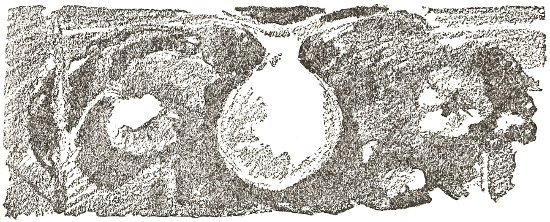
The Spiders show their great talents even better in the business of motherhood than in their hunting. The silk bag, the nest, in which the Banded Spider houses her eggs, is a much greater marvel than the bird’s nest. In shape it is a balloon turned upside down, nearly the size of a pigeon’s egg. The top tapers like a pear and is cut short and crowned with a scalloped rim, the corners of which are lengthened by means of moorings that fasten the nest to the near-by twigs. The whole, a graceful egg-shaped object, hangs straight down among a few threads that steady it.
The top of the Spider’s nest is hollowed into a bowl closed with a silky padding. Covering all the rest of the nest is a wrapper of thick, compact white satin, adorned with ribbons and patterns of brown and even black silk. We know at once the use of this satin wrapper; it is a waterproof cover which neither dew nor rain can penetrate.
The Spider’s nest, down among the dead grasses, close to the ground, must protect its contents from the winter cold. Let us cut the wrapper with our scissors. Underneath, we find a thick layer of reddish-brown silk, not worked into a fabric this time, but puffed into an extra-fine wadding. This is a comforter, a quilt, for the Spider’s babies, softer than any swan’s down and warm as toast.
In the middle of this quilt hangs a cylindrical pocket, round at the bottom, cut square at the top and closed with a padded lid. It is made of extremely fine satin; it holds the Spider’s eggs, pretty little orange-colored beads, which, glued together, form a little globe the size of a pea. These are the treasures which must be guarded against the weather.
When the Spider is making her pouch she moves slowly round and round, paying out a single thread. The hind-legs draw it out and place it in position on that which is already done. Thus is formed the satin bag. Guy-ropes bind it to the nearest threads and keep it stretched, especially at the mouth. The bag is just large enough to hold all the eggs, without any room left over.
When the Spider has laid her eggs, she begins to work her spinneret once more, but in a different manner. Her body sinks and touches a point, goes back, sinks again and touches another point, first here, then there, making confused zigzags. At the same time, the hind-legs tread the material given out. The result is not a woven cloth, but a sort of felt, a blanketing.
To make the eider-down quilt, she turns out reddish-brown silk, finer than the other and coming out in clouds which she beats into a sort of froth with her hind-legs. The egg-pocket disappears, drowned in this exquisite wadding.
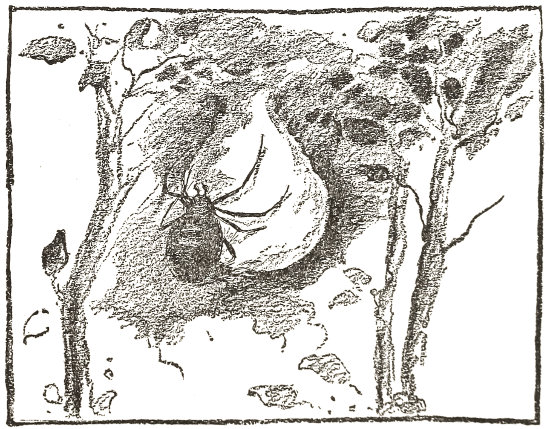
Again she changes her material, making the white silk of the outer wrapper. Already the bag has taken its balloon shape, tapering towards the neck. She now decorates the nest with brown markings, making for this purpose still a different kind of silk, varying in color from russet to black. When this is done, the work is finished.
What a wonderful silk-factory the Spider runs! With a very simple and never-varying plant, consisting of her own hind-legs and spinnerets, she produces, by turns, rope-maker’s, spinner’s, weaver’s, ribbon-maker’s and felt-maker’s work. How does she do it? How can she obtain, as she wishes, skeins of different colors and grades? How does she turn them out, first in this fashion, then in that? I see the results, but I do not understand the machinery and still less the process. It beats me altogether.
When the Spider has finished her nest, she moves away with slow strides, without giving a glance at the bag. The rest does not interest her: time and the sun will hatch the eggs. By weaving the house for her children she has used up all her silk. If she returned to her web now, she would not have any with which to bind her prey. Besides, she no longer has any appetite. Withered and languid, she drags out her existence for a few days and, at last, dies. This is how things happen when I keep the Spiders in my cages; this is how they must happen in the brushwood.
The pretty orange-yellow eggs of the Banded Spider number above five hundred. They are inclosed, you will remember, in a white-satin nest, in which there is no opening of any kind. How will the little Spiders get out, when their time comes and their mother is not there to help them?
The animal and vegetable kingdoms are sometimes very much alike. The Spider’s nest seems to me like an animal fruit, which holds eggs instead of seeds. Now seeds have all sorts of ways of scattering. The fruit of the garden balsam, when ripe, splits, at the least touch, into five fleshy valves, which curl up and shoot their seeds to a distance. You all know the jewel-weeds, or touch-me-nots, along the wayside, whose seed pods explode when you touch them. Then there are light seeds, like the dandelion, which have tufts or plumes to carry them away. The “keys” of the elm are formed of a broad, light fan with the seed cased in the center; those of the maple are joined in pairs and are like the unfurled wings of a bird; those of the ash, carved like the blade of an oar, perform the most distant journeys when driven before the storm. Like the plant, the insect also sometimes has ways of shooting its large families out into the world. You will notice this in the case of many Spiders, and particularly this Banded Spider.
As March comes on the Spiders begin to hatch out inside the nest. If we cut it open with the scissors we shall find some scattered over the eider-down outside the center room, and some still in the orange eggs. The little Spiders have not got their beautiful banded dresses yet; they are pale yellow on top, with black-rimmed eyes, and white and brown underneath. They stay in the outer room of the nest for four months, during which time their bodies harden and they grow mature.
When June and July come, they are anxious to be off, but they cannot make a hole in the tough fabric of the nest. Never mind, the nest will open of itself, like a ripe seed-pod. Some day, when the sun is very hot, the satin bursts. Some of the Spiderlings, all mixed up with their flossy mattress, shoot out of the balloon. They are in frantic commotion. Others stay inside the nest and come out in their own good time. But as they come out, all of them climb up the near-by twigs and send out little threads which float, break, and fly away, carrying the tiny Spiders with them. You shall hear more about these flying machines of the young Spiders in the next chapters.

The Spider has a bad name: most of us think her a horrid animal, and hasten to crush her under our feet. Nevertheless, any one who observes her knows that she is a hard worker, a talented weaver, a wily huntress, and very interesting in other ways. Yes, the Spider is well worth studying, apart from any scientific reasons; but she is said to be poisonous, and that is her crime and the main reason why we hate her. She is poisonous, in a way, if by that we understand that the animal is armed with two fangs which cause the immediate death of the little victims that she catches; but there is a great difference between killing a Midge and harming a Man. However quickly the Spider’s poison kills insects, it is not as a rule serious for us and causes less trouble than a gnat-bite. That, at least, is what we can safely say about the great majority of Spiders.
Nevertheless, a few are to be feared. The Italians say that the Tarantula produces convulsions and frenzied dances in the person stung by her. Music is the only cure for this, and they tell us some tunes are better than others. The tarantella, a lively dance, probably owes its name to this idea of the Italian peasants. The story makes us feel like laughing, but, after all, the bite of the Tarantula may possibly bring on some nervous trouble which music will relieve; and possibly a very energetic dance makes the patient break out into a perspiration and so get rid of the poison.
The most powerful Spider in my neighborhood, the Black-bellied Tarantula, will presently show us what her poison can do. But first I will introduce her to you in her home, and tell you about her hunting.
This Tarantula is dressed in black velvet on the lower surface, with brown stripes on the abdomen and gray and white rings around the legs. Her favorite dwelling-place is the dry, pebbly ground, covered with sun-scorched thyme. In my plot of waste ground, there are quite twenty of these Spiders’ burrows. I hardly ever pass by one of these haunts without giving a glance down the pit where gleam, like diamonds, the four great eyes, the four telescopes of the hermit. The four other eyes, which are much smaller, are not visible at that depth.
The Tarantula’s dwellings are pits about a foot deep, dug by herself with her fangs, going straight down at first and then bent elbow-wise. They are about an inch wide. On the edge of the hole stands a curb, formed of straw, bits and scraps of all sorts, and even small pebbles, the size of a hazel-nut. The whole is kept in place and cemented with the Spider’s silk. Sometimes this curb, or little tower, is an inch high; sometimes it is a mere rim.
I wished to catch some of these Spiders, so I waved a spikelet of grass at the entrance of the burrow to imitate the humming of a Bee. I expected that the Tarantula would rush out, thinking she heard a prey. My scheme did not succeed. The Tarantula, indeed, came a little way up her tube to find out the meaning of the sounds at her door; but she soon scented a trap; she remained motionless at mid-height and would not come any farther.
I found that the best method to secure the wily Tarantula was to procure a supply of live Bumble-bees. I put one into a little bottle with a mouth just wide enough to cover the opening of the burrow; and I turned the apparatus thus baited over the opening. The powerful Bee at first fluttered and hummed about her glass prison; then, seeing a burrow like that made by her own family, she went into it without much hesitation. She was very foolish: while she went down, the Spider came up; and the meeting took place in the perpendicular passage. For a few moments, I heard a sort of death-song: it was the humming of the poor Bumble-bee. This was followed by a long silence. I removed the bottle and explored the pit with a pair of pincers. I brought out the Bumble-bee, motionless, dead. A terrible tragedy must have happened. The Spider followed, refusing to let go so rich a booty. Game and huntress were brought outside the hole, which I stopped up with a pebble. Outside her own house the Tarantula is timid and hardly able to run away. To push her with a straw into a paper bag was the work of a second. Soon I had a colony of Tarantulas in my laboratory.
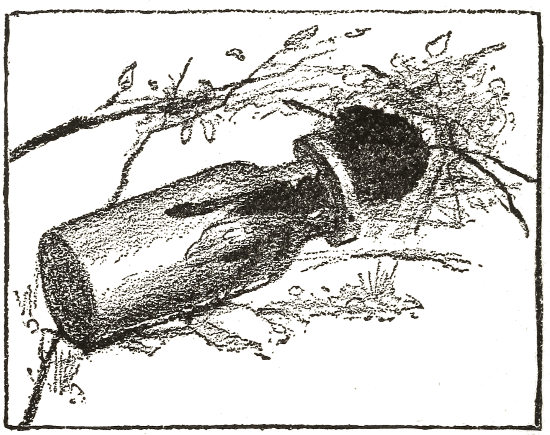
I did not give the Tarantula the Bee merely in order to capture her. I wished to know also her manner of hunting. I knew that she is one of those insects who live from day to day on what they kill. She does not store up preserved food for her children, like the Beetles; she is not a “paralyzer,” like the Wasps you have read about, who cleverly spare their game so as to leave it a glimmer of life and keep it fresh for weeks at a time; she is a killer, who makes a meal off her capture on the spot. I wished to find out how she kills them so quickly.
She does not go in for peaceable game. The big Grasshopper, with the powerful jaws, the Bee and other wearers of poisoned daggers must fall into her hole from time to time, and the duel she fights with them is nearly equal as far as weapons go. For the poisonous fangs of the Spider the Wasp has her poisoned dagger or sting. Which of the two bandits shall have the best of it? The Tarantula has no second means of defense, no cord to bind her victim, as the Garden Spiders have. These cover the captives with their silk, making all resistance impossible. The Tarantula has a riskier job. She has only her courage and her fangs, and she must leap upon her dangerous prey and kill it quickly. She must know exactly where to strike, for, strong though her poison is, I cannot believe it would kill the prey instantly at any point where she happens to bite. She must bite in some spot of vital importance.
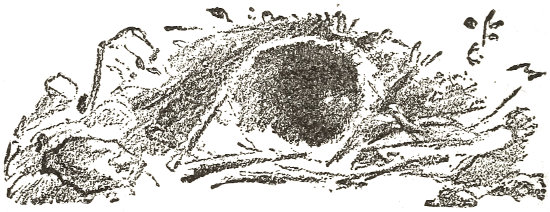
Instead of with the Bumble-bee, who enters the Spider’s burrow, I wish to make the Tarantula fight with some other insect, who will stay above ground. For this purpose I take one of the largest and most powerful Bees that I can find, the Carpenter-bee, clad in black velvet, with wings of purple gauze. She is nearly an inch long; her sting is very painful and produces a swelling that hurts for a long time. I know, because I have been stung. Here indeed is a foe worthy of the Tarantula.
I catch several Carpenter-bees, place them one by one in bottles, and choose a strong, bold Tarantula, one moreover who appears to be very hungry. I put the bottle baited with a Carpenter-bee upside down over her door. The Bee buzzes gravely in her glass bell; the Spider comes up from the recesses of her cave; she is on the threshold, but inside; she looks; she waits. I also wait. The quarters, the half-hours pass; nothing happens. The Spider goes down again: she probably thought the attempt too dangerous. I try in this way three more Tarantulas, but cannot make them leave their lairs.
At last I have better success. A Spider suddenly rushes from her hole: she is unusually warlike, doubtless because she is very hungry. She attacks the Bee in the bottle, and the combat lasts for but the twinkling of an eye. The sturdy Carpenter-bee is dead. Where did the murderess strike her? Right in the nape of the neck; her fangs are still there. She has the knowledge which I suspected: she has bitten the only point she could bite to produce sudden death. She has struck the center of the victim’s nervous system.
I make more experiments and find that it is only once in a while that the Tarantula will come out to fight the Carpenter-bee, but each time that she does so she kills it in the same way. The reason of the Tarantula’s hesitation is plain. An insect of this kind cannot be seized recklessly: the Tarantula who missed her strike by biting at random would do so at the risk of her life. Stung in any other place, the Bee might live for hours and manage to sting her foe with her poisoned dagger. The Spider is well aware of this. In the safe shelter of her threshold she watches for the right moment; she waits for the big Bee to face her, when the neck is easily grabbed.
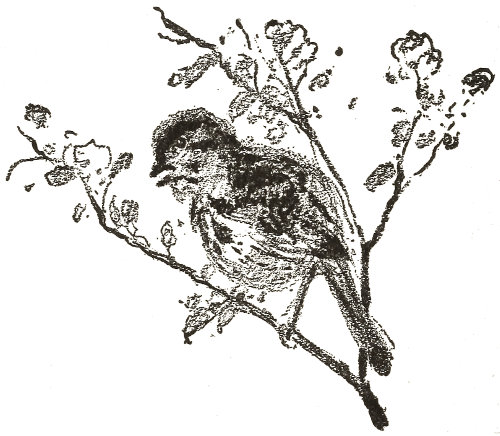
The Tarantula’s poison is a pretty dangerous weapon, as we shall see. I make a Tarantula bite the leg of a young, well-fledged Sparrow, ready to leave the nest. A drop of blood flows; the wounded spot is surrounded by a reddish circle, changing to purple. The bird almost immediately loses the use of its leg, which drags, with the toes doubled in; it hops upon the other leg. Aside from this, the patient does not seem to trouble much about his hurt; his appetite is good. My daughters feed him on Flies, bread-crumb, apricot-pulp. He is sure to get well; he will recover his strength; the poor victim of the curiosity of science will be restored to liberty. This is the wish and intention of us all. Twelve hours later, we are still more hopeful; the invalid takes nourishment readily; he clamors for it, if we keep him waiting. Two days after, he refuses his food. Wrapping himself stoically in his rumpled feathers, the Sparrow hunches into a ball, now motionless, now twitching. My girls take him in the hollow of their hands and warm him with their breath. The spasms become more frequent. A gasp tells us that all is over. The bird is dead.
There is a certain coolness among us at the evening meal. I read silent reproaches, because of my experiment, in the eyes of the home-circle; I know they think me cruel. The death of the unfortunate Sparrow has saddened the whole family. I myself feel remorseful: what I have found out seems to me too dearly bought.
Nevertheless, I had the courage to try again with a Mole who was caught stealing from our lettuce-beds. I put him in a cage and fed him on a varied diet of insects—Beetles and Grasshoppers. He crunched them up with a fine appetite. Twenty-four hours of this life convinced me that the Mole was making the best of the bill of fare and taking kindly to his captivity.
I made the Tarantula bite him at the tip of the snout. When put back in his cage, the Mole kept on scratching his nose with his broad paws. The thing seemed to burn, to itch. From now on, he ate less and less of the store of insects: on the evening of the following day, he refused them altogether. About thirty-six hours after being bitten, the Mole died during the night, and certainly not from starvation, for there were still many live insects in the cage.
The bite of my Tarantula is therefore dangerous to other animals than insects: it is fatal to the Sparrow, it is fatal to the Mole. I did not make any more experiments, but I should say that people had better beware of the bite of this Spider. It is not to be trifled with.
Think, just for a moment, of the skill of the Spider, the insect-killer, as contrasted with the skill of the Wasps, the insect-paralyzers. These insect-killers, who live on their prey, strike the game dead at once by stinging the nerve-centers of the neck; the paralyzers, on the other hand, who wish to keep the food fresh for their larvæ, destroy the power of movement by stinging the game in the other nerve-centers, lower down. They do not acquire this knowledge, they have it as soon as they are born. And they teach those of us who think that there is something behind it all, that there is Some One who has planned things for insects and men alike.
From the Tarantulas whom I have captured and placed in pans filled with earth in my laboratory, I learn still more about their hunting. They are really magnificent, these captives. With their great bodies inside their burrows, their heads outside, their glassy eyes staring, their legs gathered for a spring, for hours and hours they wait, motionless, bathing luxuriously in the sun.
Should a titbit to her liking happen to pass, at once the watcher darts from her tall tower, swift as an arrow from the bow. With a dagger-thrust in the neck, she stabs the Locust, Dragon-fly, or other prey; and she as quickly climbs her tower and retires with her capture. The performance is a wonderful exhibition of skill and speed.
She very seldom misses the game, provided that it pass at a convenient distance, within reach of her bound. But if it be farther away she takes no notice of it. Scorning to go in pursuit, she allows it to roam at will.
This proves that the Tarantula has great patience, for the burrow has nothing that can serve to attract victims. At best, refuge provided by the tower may, once in a long while, tempt some weary wayfaring insect to use it as a resting-place. But, if the game does not come to-day, it is sure to come to-morrow, the next day, or later, for there are many Locusts hopping in the waste land, and they are not always able to regulate their leaps. Some day or other, chance is bound to bring one of them near the burrow. Then the Spider springs upon the victim from the ramparts. Until then, she stoically watches and fasts. She will dine when she can; but she will finally dine.
The Tarantula really does not suffer much from a long fast. She has an accommodating stomach, which is satisfied to be gorged to-day and to remain empty afterwards for goodness knows how long. When I had the Spiders in my laboratory, I sometimes neglected to feed them for weeks at a time, and they were none the worse for it. After they have fasted a long time, they do not pine away, but are smitten with a wolf-like hunger.
In her youth, before she has a burrow, the Tarantula earns her living in another manner. Clad in gray like her elders, but without the black-velvet apron which she receives on reaching the marriageable age, she roams among the stubby grass. This is true hunting. When the right kind of game heaves in sight, the Spider pursues it, drives it from its shelters, follows it hot-foot. The fugitive gains the heights, and makes as though to fly away. He has not the time. With an upward leap, the Tarantula grabs him before he can rise.
I am charmed with the quick way in which my year-old Spider boarders seize the Flies that I provide for them. In vain does the Fly take refuge a couple of inches up, on some blade of grass. With a sudden spring into the air, the Spider pounces on her prey. No Cat is quicker in catching her Mouse.
But these are the feats of youth not handicapped by fatness. Later, when the bag of eggs has to be trailed along, the Tarantula cannot indulge in gymnastics. She then digs herself her hunting-lodge, and sits in her watch-tower, on the lookout for game.
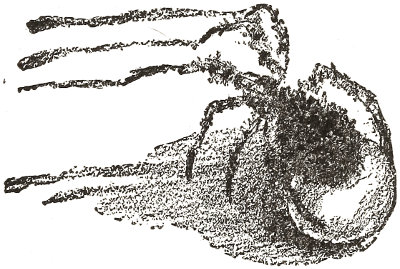
You will be surprised to hear how devoted this terrible Tarantula is to her family.
Early one morning in August, I found a Tarantula spinning on the ground a silk network covering an extent about as large as the palm of one’s hand. It was coarse and shapeless, but firmly fixed. This is the floor on which the Spider means to work. It will protect her nest from the sand.
On this floor she weaves a round mat, about the size of a fifty-cent piece and made of superb white silk. She thickens the outer part of it, until it becomes a sort of bowl, surrounded by a wide, flat edge. Upon this bowl she lays her eggs. These she covers with silk. The result is a pill set in the middle of a circular carpet.
With her legs she takes up and breaks off one by one the threads that keep the round mat stretched on the coarse floor. At the same time, she grips this sheet with her fangs, lifts it by degrees, tears it from its base, and folds it over upon the globe of eggs. It is hard work. The whole thing totters, the floor collapses, heavy with sand. The Tarantula, by a movement of her legs, casts these soiled shreds aside. She pulls with her fangs and sweeps with her broom-like legs, till she has pulled away her bag of eggs.
It is like a white-silk pill, soft and sticky to the touch, as big as an average cherry. If you look closely, you will notice, running horizontally around the middle, a fold which a needle is able to raise without breaking it. This is the edge of the circular mat, drawn over the lower half of the bag. The upper half, through which the young Tarantulas will go out, is less well protected: its only wrapper is the silk spun over the eggs immediately after they were laid.
Inside, there is nothing but the eggs: no mattress, no soft eider down, like that of the Banded Spider. This Tarantula has no need to guard her eggs against the weather, for the hatching will take place long before the cold weather comes.
The mother has been busy the whole morning over her bag. Now she is tired. She embraces her dear pill and remains motionless. I shall see her no more to-day. Next morning I find the Spider carrying her bag of eggs slung behind her.
For three weeks and more the Tarantula trails the bag of eggs hanging to her spinnerets. When she comes up from her shaft to lean upon the curb and bask in the sun, when she suddenly retires underground in the face of danger, and when she is roaming the country before settling down, she never lets go her precious bag, though it is a very inconvenient burden in walking, climbing or leaping. If, by some accident, it become detached from the fastening to which it is hung, she flings herself madly on her treasure and lovingly embraces it, ready to bite the person who would take it from her. She restores the pill to its place with a quick touch of her spinnerets, and strides off, still threatening.
Towards the end of summer, every morning, as soon as the sun is hot, the Tarantulas come up from the bottom of their burrows with their bags and station themselves at the opening. Earlier in the season they have taken long naps on the threshold in the sun in the middle of the day; but now they ascend for a different reason. Before, the Tarantula came out into the sun for her own sake. Leaning on the parapet, she had the front half of her body outside the pit and the back half inside. Her eyes took their fill of light; the body remained in the dark. When carrying her egg-bag the Spider reverses her position: the front is in the pit, the rear outside. With her hind-legs she holds the white pill, bulging with germs, lifted above the entrance; gently she turns and re-turns it, so as to present every side to the life-giving rays of the sun. And this goes on for half the day, as long as the temperature is high; and it is repeated daily, with exquisite patience, during three or four weeks. To hatch its eggs, the bird covers them with the quilt of its breast; it strains them to the furnace of its heart. The Tarantula turns hers in front of the hearth of hearths: she gives them the sun as an incubator.
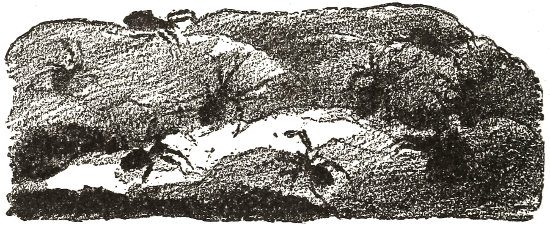
In the early days of September, the young ones, who have been some time hatched, are ready to come out. The pill rips open along the middle fold. We have read of this fold. Does the mother, feeling the brood quicken inside the satin wrapper, herself break open the vessel at the right moment? It seems probable. On the other hand, it may burst of itself, as does the Banded Spider’s balloon, a tough wallet which opens a breach of its own accord, long after the mother has ceased to exist.
As they come out of the pill, the little Tarantulas, to the number of about a couple of hundred, clamber on the mother Tarantula’s back and there sit motionless, jammed close together, forming a sort of bark of mingled legs and bodies. The mother cannot be recognized under this live cloak. When the hatching is over, the wallet is loosened from the spinnerets and cast aside as a worthless rag.
The little ones are very good: none stirs, none tries to get more room for himself at his neighbor’s expense. What are they doing there, so quietly? They allow themselves to be carted about, like the young of the Opossum. Whether she sit in long meditation at the bottom of her den, or come to the opening, in mild weather, to bask in the sun, the Tarantula never throws off her greatcoat of swarming youngsters until the fine season comes.
If, in the middle of winter, in January, or February, I happen, out in the fields, to ransack the Spider’s dwelling, after the rain, snow, and frost have battered it and, as a rule, destroyed the curb at the entrance, I always find her at home, still full of vigor, still carrying her family. This upbringing of her youngsters on her back lasts five or six months at least, without interruption. The celebrated American carrier, the Opossum, who lets her children go after a few weeks’ carting, cuts a poor figure beside the Tarantula.

“Does she help them to regain their place on her back?”
What do the little ones eat on their mother’s spine? Nothing, so far as I know. I do not see them grow larger. I find them, when they finally leave to shift for themselves, just as they were when they left the bag.
During the bad season, the mother herself eats very little. At long intervals she accepts, in my jars, a belated Locust, whom I have captured, for her benefit, in the sunnier nooks. In order to keep herself in condition, as she is when she is dug up in the course of my winter excavations, she must therefore sometimes break her fast and come out in search of prey, without, of course, discarding her live cloak of youngsters.
The expedition has its dangers. The little Spiders may be brushed off by a blade of grass. What becomes of them when they have a fall? Does the mother give them a thought? Does she help them to regain their place on her back? Not at all. The affection of a Spider’s heart, divided among some hundreds, can spare but a very feeble portion to each. The Tarantula hardly troubles, whether one youngster fall from his place, or six, or all of them. She waits quietly for the victims of the mishap to get out of their own difficulty, which they do for that matter, and very nimbly.
I sweep the whole family from the back of one of my boarders with a hair-pencil. Not a sign of emotion, not an attempt at search on the part of the mother. After trotting about a little on the sand, the dislodged youngsters find, these here, those there, one or another of the mother’s legs, spread wide in a circle. By means of these climbing-poles they swarm to the top, and soon the group on the mother’s back resumes its original form. Not one of the lot is missing. The Tarantula’s sons know their trade as acrobats to perfection: the mother need not trouble her head about their fall.
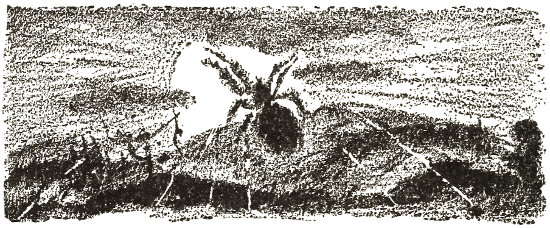
Does the Tarantula at least feed the youngsters who, for seven months, swarm upon her back? Does she invite them to the party when she has captured a prize? I thought so at first; and I gave special attention to watching the mothers eat. Usually, the prey is devoured out of sight, in the burrow; but sometimes a meal is taken on the threshold, in the open air. Well, I see then that while the mother eats, the youngsters do not budge from their camping ground on her back. Not one quits its place or gives a sign of wishing to slip down and join in the meal. Nor does the mother invite them to come and refresh themselves, or put any left-over food aside for them. She feeds and the others look on, or rather remain indifferent to what is happening. Their perfect quiet during the Tarantula’s feast is a proof that they are not hungry.
Then what do they live upon, during their seven months’ upbringing on the mother’s back? One thinks of their absorbing nourishment from their mother’s skin. We must give up this notion. Never are they seen to put their mouths to it. And the Tarantula, far from being exhausted and shriveling, keeps perfectly well and plump; she even puts on flesh.
Once more, with what do the little ones keep up their strength? We do not like to suggest that they are still living on the food they received in the egg, especially when we consider that they must use the energy drawn from this food to produce silk, a material of the highest importance, of which a plentiful use will be made presently. There must be other powers at play in the tiny animal’s machinery.
We could understand their not needing anything to eat if they did not move; complete quiet is not life. But the young Spiders, although usually quiet on their mother’s back, are at all times ready for exercise and for agile swarming. When they fall from the mother’s baby-carriage, they briskly pick themselves up, briskly scramble up a leg and make their way to the top. It is a splendidly nimble and spirited performance. Besides, once seated, they have to keep a firm balance; they have to stretch and stiffen their little limbs in order to hang on to their neighbors. As a matter of fact, there is no absolute rest for them.
Now physiology teaches us that not a muscle works without using up energy. The animal is like a machine; it must renew its body, which wears out with movement, and it must have something to make heat, which is turned into action. We can compare it with the locomotive-engine. As the iron horse does its work, it gradually wears out its pistons, its rods, its wheels, its boiler-tubes, all of which have to be made good from time to time. The foundry-man and the blacksmith repair it, supply it with new parts; it is as if they were giving it food to renew itself. But, although it be brand-new, it cannot move until the stoker shovels some coal into its inside and sets fire to it. This coal is like energy-producing food; it makes the engine work.
Things are just the same with the animal. Since nothing is made from nothing, the little new-born animal is made from the food there was in the egg. This is tissue-forming food which increases the body, up to a certain point, and renews it as it wears away. But it must have heat-food, or energy-food, too. Then the animal will walk, run, jump, swim, fly, or move in any one of a thousand manners.
To return to the young Spiders: they grow no larger until after they leave their mother. At the age of seven months they are the same as at birth. The egg supplied the food necessary for their tiny frames; and they do not need more tissue-forming food as long as they do not grow. This we can understand. But where do they get the energy-food that makes them able to move about so actively?
Here is an idea. What is coal, the energy-food of the locomotive? It is the fossil remains of trees which, ages ago, drank the sunlight with their leaves. Coal is really stored-up sunlight and the locomotive, devouring it, is devouring sunlight.
Beasts of flesh and blood act no otherwise. Whether they eat one another or plants, they always live on the stimulant of the sun’s heat, a heat stored in grass, fruit, seed, and those which feed on such. The sun, the soul of the universe, is the supreme giver of energy.
Instead of being served up in food and being digested through the stomach, could not this sun-energy enter the animal directly and charge it with activity, just as the electric battery charges an accumulator with power? Why not live on sun, seeing that, after all, we find nothing but sun in the fruits which we eat?
The chemists say they are going to feed us some day on artificial food-stuffs put up in drug-stores. Perhaps the laboratory and the factory will take the place of the farm. Why should not physical science do as well? It would leave to the chemist the preparation of tissue-forming food; it would give us energy-food. With the help of some ingenious apparatus, it would pump into us our daily supply of sun-energy, to be later spent in movement, so that we could keep going without eating at all. What a delightful world, where one would lunch off a ray of sunshine!
Are we dreaming, or will something like this happen some day? It is worth while surely for the scientists to think about it.

As the month of March comes to an end, the mother Tarantula is outside her burrow, squatting on the parapet at the entrance. It is time for the youngsters to leave her. She lets them do as they please, seeming perfectly indifferent to what is happening.
The departure begins during glorious weather, in the hottest hours of the morning. First these, then those, of the little ones, according as they feel themselves soaked with sunshine, leave the mother in batches, run about for a moment on the ground, and then quickly reach the trellis-work of the cage in my laboratory, which they climb with surprising quickness. They all make for the heights, though their mother is accustomed to stay on the solid ground. There is an upright ring at the top of the cage. The youngsters hurry to it. They hang out threads across the opening; they stretch others from the ring to the nearest points of the trellis-work. On these foot-bridges they perform slack-rope exercises. The tiny legs open out from time to time as though to reach the most distant points. I begin to realize that they wish to go higher.
I top the trellis with a branch as high again. The little Spiders hastily scramble up it, reach the tip of the topmost twigs and from there send out threads that fasten themselves to every surrounding object. These are suspension-bridges; and my beasties nimbly run along them, incessantly passing to and fro. They seem to wish to climb still higher.
I take a nine-foot reed, with tiny branches spreading right up to the top, and place it above the cage. The little Tarantulas clamber to the very summit. Here they send out longer threads, which are left to float, and which again form bridges when their loose ends touch some object. The rope-dancers embark upon them and form garlands which the least breath of air swings daintily. One cannot see the threads at all unless they come between the eyes and the sun; the Spiders look as if they were dancing in the air.
Then, suddenly, shaken by the air-currents, the delicate mooring breaks and flies through space. Behold the little Spiders fly off and away, hanging to their threads! If the wind be favorable, they can land at great distances.
The bands of little Spiders keep on leaving thus for a week or two, if the weather is fine. On cloudy days, none dreams of going. The travelers need the kisses of the sun, which give them energy and vigor.
At last, the whole family has disappeared, carried afar by its flying-ropes. The mother is alone. The loss of her children hardly seems to distress her. She goes on with her hunting with greater energy, now that she is not hampered with her coat of little ones. She will have other families, become a grandmother and a great-grandmother, for the Tarantulas live several years.
In this species of Tarantula, as we have seen, a sudden instinct arises in the young ones, to disappear, as promptly and forever, a few hours later. This is the climbing-instinct, which is unknown to the older Tarantula and soon forgotten by the young ones, who alight upon the ground and wander there for many a long day before they begin to build their burrows. Neither of them dreams of climbing to the top of a grass-stalk. Yet here we have the young Tarantula, wishing to leave her mother and to travel far away by the easiest and swiftest methods, suddenly becoming an enthusiastic climber. We know her object. From on high, finding a wide space beneath her, she sends a thread floating. It is caught by the wind, and carries her hanging to it. We have our aeroplanes; she too possesses her flying-machine. She makes it in her hour of need, and when the journey is finished thinks no more about it.
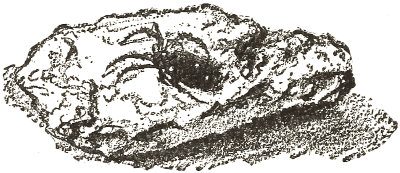
Prettily shaped and clad, as far as a Spider can be, the Clotho Spider is, above all, a very clever spinstress. She is named after the Clotho of antiquity, the youngest of the Three Fates, who holds the distaff whence our destinies are spun. It is a pity that the Fate Clotho cannot spin as soft lives for us as the exquisite silk the Spider Clotho spins for herself!
If we would make the acquaintance of the Clotho Spider we must go up the rocky slopes in the olive-land, scorched and blistered by the sun, turn over the flat stones, those of a fair size, search, above all, the piles which the shepherds set up for a seat from which to watch the sheep browsing amongst the lavender below. Do not be too easily disheartened if you do not find her at first. The Clotho is rare; not every spot suits her. If we are lucky, we shall see, clinging to the lower surface of the stone which we have lifted, a queer-looking thing, shaped like the dome of a building turned upside down, and about half the size of a tangerine orange. The outside is hung with small shells, bits of earth, and, especially, dried insects.
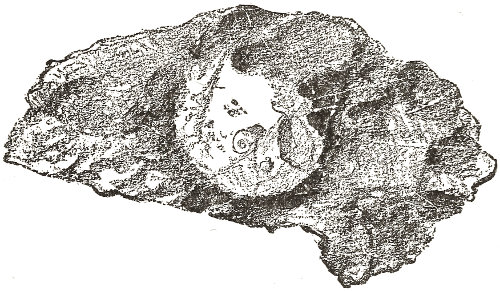
The edge of the dome is scalloped into a dozen pointed scallops, the points of which spread and are fixed to the stone. A flat roof closes the top of the dwelling.
Where is the entrance? All the arches of the edge open upon the roof; not one leads inside. Yet the owner of the house must go out from time to time, if only in search of food; on returning from her expedition, she must go in again. How does she make her exits and her entrances? A straw will tell us the secret.
Pass it over the threshold of the various arches. It finds them all carefully closed, apparently. But one of the scallops, if cleverly coaxed, opens at the edge into two lips and stands slightly ajar. This is the door, which at once shuts again of its own elasticity. Nor is this all: the Spider, when she returns home, often bolts herself in; that is to say, she joins and fastens the two leaves of the door with a little silk.
The Clotho, when in danger, runs quickly home; she opens the chink with a touch of her claw, enters and disappears. The door closes of itself and is supplied, in case of need, with a lock consisting of a few threads. No burglar, on the outside of so many arches, one and all alike, will ever discover under which one the fugitive vanished so suddenly.
Let us open the Spider’s cabin. What luxury! We have read how the Princess in the fairy-tale was unable to rest, if there was a crumpled rose-leaf in her bed. The Clotho is quite as fastidious. Her couch is more delicate than swan’s-down and whiter than the fleece of clouds where brood the summer storms. It is the ideal blanket. Above is a canopy or tester of equal softness. Between the two nestles the Spider, short-legged, clad in somber garments, with five yellow favors on her back.
Rest in this exquisite retreat demands that it be perfectly steady, especially on gusty days, when sharp draughts creep under the stone dwelling. By taking a careful look at her we can see how the Spider manages this. The arches that bear the weight of the building are fastened to the stone at each end. Moreover, where they touch, you may see a cluster of diverging threads that creep along the stone and cling to it throughout their length, which spreads afar. I have measured some that were fully nine feet long. These are so many cables; they are like the ropes and pegs that hold the Arab’s tent in position.
Another detail attracts our attention: whereas the inside of the house is exquisitely clean, the outside is covered with dirt, bits of earth, chips of rotten wood, little pieces of gravel. Often there are worse things still: hung up or embedded are the dry carcasses of Beetles that favor under-rock shelters; parts of Thousand-legged Worms, bleached by the sun; snail-shells, chosen from among the smallest.
These relics are plainly, for the most part, table-leavings, broken victuals. Unskilled in laying traps, the Clotho lives upon the insects who wander from one stone to another. Whoever ventures under the slab at night is strangled by the hostess; and the dried-up carcass, instead of being flung to a distance, is hung to the silken wall, as though the Spider wished to make a bogey-house of her home. But this cannot be her aim. To act like the ogre who hangs his victim from the castle battlements is the worst way to disarm suspicion in the passers-by whom you are lying in wait to capture.
There are other reasons which increase our doubts. The shells hung up are most often empty; but there are also some occupied by the Snail, alive and untouched. What can the Spider do with these snail-shells wherein the animal retreats so far that she cannot reach it? The Spider cannot break the hard shell or get at the hermit through the opening. Then why should she collect these prizes, whose slimy flesh is probably not to her taste? We begin to suspect a simple question of ballast and balance. The House Spider prevents her web, spun in a corner of the wall, from losing its shape at the least breath of air, by loading it with crumbling plaster and allowing tiny fragments of mortar to accumulate. The Clotho Spider dumps down on her abode any more or less heavy object, mainly corpses of insects, because she need not look for these and finds them ready to hand after each meal. They are weights, not trophies; they take the place of materials that must otherwise be collected from a distance and lifted to the top. In this way, a breastwork is obtained that strengthens and steadies the house. Further balance is often given by tiny shells and other objects hanging a long way down. The Clotho knows the laws of balancing; by means of additional weights, she is able to lower the center of gravity and thus to give her dwelling the proper equilibrium and roominess.
Now what does she do in her softly-wadded home? Nothing, that I know of. With a full stomach, her legs luxuriously stretched over the down carpet, she does nothing, thinks of nothing; she listens to the sound of the earth revolving on its axis. It is not sleep, still less is it waking; it is a middle state where the Spider is conscious of nothing except that she is happy. We ourselves, when comfortably in bed, enjoy, just before we fall asleep, a few moments of bliss, when we neither think nor worry; and those moments are among the sweetest in our lives. The Clotho Spider seems to know similar moments and to make the most of them.
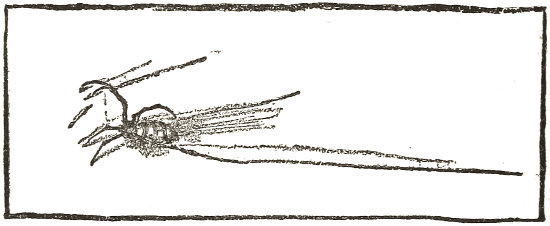
Of the six Garden Spiders I have noticed, two only, the Banded and the Silky Spiders, stay constantly in their webs, even under the blinding rays of a fierce sun. The others, as a rule, do not show themselves until nightfall. At some distance from the net they have a rough and ready retreat in the brambles, a hiding-place made of a few leaves held together by stretched threads. It is here that they usually remain in the daytime, motionless and sunk in meditation.
But the shrill light that vexes them is the joy of the fields. At such time, the Locust hops more nimbly than ever, more gayly skims the Dragon-fly. Besides, the sticky web, in spite of the rents suffered during the night, is still in fairly good condition. If some giddy-pated insect allow himself to be caught, will the Spider, at the distance whereto she has retired, be unable to take advantage of the windfall? Never fear. She arrives in a flash. How does she know what has happened? Let us explain the matter.
It is the vibration of the web which tells her, rather than the sight of the captured object. To prove this, I laid upon several Spiders’ webs a dead Locust. I placed the Locust where the Spider might have plainly seen it. Sometimes the Spider was in her web, and sometimes she was outside, in her hiding-place. In both cases, nothing happened at first. The Spider remained motionless, even when the Locust was at a short distance in front of her. She did not seem to see the game at all. Then, with a long straw, I set the dead insect trembling.
That was quite enough. The Banded Spider and the Silky Spider hastened to the central floor, the others, who were in hiding, came down from the branch; all went to the Locust, bound him with tape, treated him, in short, as they would treat a live prey captured under the usual conditions. It took the shaking of the web to decide them to attack.
If we look carefully behind the web of any Spider with a daytime hiding-place, we shall see a thread that starts from the center of the web and reaches the place where the Spider lurks. It is joined to the web at the central point only. Its length is usually about twenty-two inches, but the Angular Spider, settled high up in the trees, has shown me some as long as eight or nine feet.
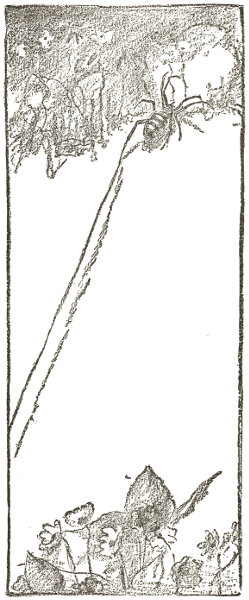
“The slanting cord is a telegraph wire.”
This slanting line is a foot-bridge by which the Spider hurries to her web when there is something going on there, and then, when her errand is finished, returns to her hut. But that is not all it is. If it were, the foot-bridge would be fastened to the upper end of the web. The journey would then be shorter and the slope less steep.
The line starts from the center of the net because that is the place where the spokes meet and therefore where the vibration from any part of the net is best felt. Anything that moves upon the web sets it shaking. All then that is needed is a thread going from this central point to carry to a distance the news of a prey struggling in some part or other of the net. The slanting cord is not only a foot-bridge: it is a signaling-apparatus, a telegraph-wire.
In their youth, the Garden Spiders, who are then very wide-awake, know nothing of the art of telegraphy. Only the old Spiders, meditating or dozing in their green tent, are warned from afar, by telegraph, of what takes place on the net.
To save herself from keeping a close watch that would be drudgery and to remain alive to events even when resting, with her back turned on the net, the hidden Spider always has her foot upon the telegraph-wire. Here is a true story to prove it.
An Angular Spider has spun her web between two laurestine-shrubs, covering a width of nearly a yard. The sun beats upon the snare, which is abandoned long before dawn. The Spider is in her day house, a resort easily discovered by following the telegraph-wire. It is a vaulted chamber of dead leaves, joined together with a few bits of silk. The refuge is deep: the Spider disappears in it entirely, all but her rounded hind-quarters, which bar the entrance.
With her front half plunged into the back of her hut, the Spider certainly cannot see her web; she could not even if she had good sight, instead of being half blind as she is. Does she give up hunting during this period of bright sunlight? Not at all. Look again.
Wonderful! One of her hind-legs is stretched outside the leafy cabin; and the signaling-thread ends just at the tip of that leg. Whoever has not seen the Spider in this attitude, with her hand, so to speak, on the telegraph-receiver, knows nothing of one of the most curious examples of animal cleverness. Let any game appear upon the scene, and the slumberer, at once aroused by means of the leg receiving the vibrations, hastens up. A Locust whom I myself lay on the web gives her this agreeable shock, and what follows? If she is satisfied with her prey, I am still more satisfied with what I have learned.
One word more. The web is often shaken by the wind. The signaling-cord must pass this vibration to the Spider. Nevertheless, she does not leave her hut and remains indifferent to the commotion prevailing in the net. Her line, therefore, is something better than a bell-rope; it is a telephone capable, like our own, of transmitting infinitesimal waves of sound. Clutching her telephone-wire with a toe, the Spider listens with her leg; she can tell the difference between the vibration proceeding from a prisoner and the mere shaking caused by the wind.
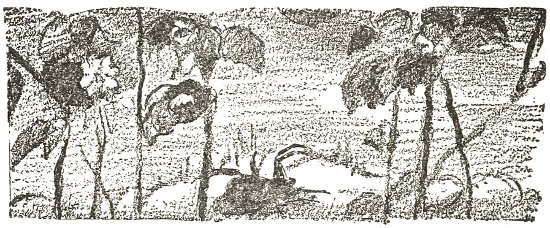
The Banded Spider, who works so hard to give her eggs a wonderfully perfect dwelling-house, becomes, after that, careless of her family. For what reasons? She lacks the time. She has to die when the first cold comes, whereas the eggs are to pass the winter in their cozy home. She cannot help deserting the nest. But, if the hatching were earlier and took place in the Spider’s life, I imagine that she would be as devoted to her family as a Bird is. So I gather from the behavior of a shapely Spider who weaves no webs, lies in wait for her prey, and walks sideways, like a Crab.
This Spider with the Crab-like figure does not know how to make nets for catching game. Without springs or snares, she lies hidden among the flowers, and waits for the arrival of the prey, which she kills by a scientific stab in the neck. The particular species I have observed is passionately fond of the pursuit of the Domestic Bee.
The Bee appears, seeking no quarrel, intent upon plunder. She tests the flowers with her tongue; she chooses a spot that will yield a good return. Soon she is wrapped up in her harvesting. While she is filling her baskets and distending her crop, the Crab-spider, that bandit lurking under cover of the flowers, comes out of her hiding-place, creeps round behind the bustling insect, steals up close, and, with a sudden rush, nabs her in the nape of the neck. In vain the Bee protests and darts her sting at random; the assailant does not let go.
Besides, the bite in the neck is paralyzing, because the nerve-centers are affected. The poor thing’s legs stiffen; and all is over in a second. The murderess Spider now sucks the victim’s blood at her ease and, when she has done, scornfully flings the drained corpse aside.
We shall see the cruel vampire become a model of devotion where her family is concerned. The ogre loved his children; he ate the children of others. Under the tyranny of hunger, we are all of us, beasts and men alike, ogres.
After all, this cutter of Bees’ throats is a pretty, a very pretty creature, in spite of her unwieldy body fashioned like a squat pyramid and embossed on the base, on either side, with a pimple shaped like a camel’s hump. The skin, more pleasing to the eye than any satin, is milk-white in some, in others lemon-yellow. There are fine ladies among them who adorn their legs with a number of pink bracelets and their backs with crimson patterns. A narrow, pale-green ribbon sometimes edges the right and left of the breast. The costume is not so rich as that of the Banded Spider, but much more elegant because of its soberness, its daintiness, and the artistic blending of its colors. People who shrink from touching any other Spider do not fear to handle the beautiful Crab Spider, so gentle in appearance.

Skillful in the prompt despatch of her prey, the little Crab-spider is no less clever in the nesting art. I find her settled on a privet in the inclosure. Here, in the heart of a cluster of flowers, the luxurious creature plaits a little pocket of white satin, shaped like a wee thimble. It is the receptacle for the eggs. A round, flat lid, of a felted fabric, closes the mouth.
Above this ceiling rises a dome of stretched threads and faded flowerets which have fallen from the cluster. This is the watcher’s conning-tower. An opening, which is always free, gives access to this post.
Here the Spider remains on constant duty. She has thinned greatly since she laid her eggs, has almost lost her figure. At the least alarm, she sallies forth, waves a threatening limb at the passing stranger and invites him, with a gesture, to keep his distance. Having put the intruder to flight, she quickly returns indoors.
And what does she do in there, under her arch of withered flowers and silk? Night and day, she shields the precious eggs with her poor body spread out flat. Eating is neglected. No more lying in wait, no more Bees drained to the last drop of blood. Motionless, rapt in meditation, the Spider is sitting on her eggs.
The brooding Hen does likewise, but she is also a heating-apparatus and, with the gentle warmth of her body, awakens the germs to life. For the Spider, the heat of the sun is enough; and this alone keeps me from saying that she “broods.”
For two or three weeks, the little Spider, more and more wrinkled by lack of food, never relaxes her position. What is the withered thing waiting for, before expiring? She is waiting for her children to emerge; the dying creature is still of use to them.
When the Banded Spider’s little ones come out from their balloon, they have long been orphans. There is none to come to their assistance; and they have not the strength to free themselves without help. The balloon has to split automatically and to scatter the youngsters and their flossy mattress all mixed up together. The Crab-spider’s wallet, sheathed in leaves over the greater part of its surface, never bursts; nor does the lid rise, so carefully is it sealed down. Nevertheless, after the delivery of the brood, we see, at the edge of the lid, a small, gaping hole, an exit-window. Who contrived this window, which was not there at first?
The fabric is too thick and tough to have yielded to the twitches of the feeble little prisoners. It was the mother, therefore, who, feeling her offspring shuffle impatiently under the silken ceiling, herself made a hole in the bag. She persists in living for five or six weeks, despite her shattered health, so as to give a last helping hand and open the door for her family. After performing this duty, she gently lets herself die, hugging her nest and turning into a shriveled relic. The Hen does not reach this height of unselfishness!
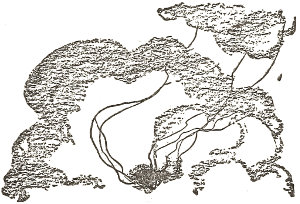
It is in July that some little Crab-spiders that I have in my laboratory come out of their eggs. Knowing their acrobatic habits, I have placed a bundle of slender twigs at the top of the cage in which they were born. All of them pass through the wire gauze and form a group on the summit of the brushwood, where they swiftly weave a roomy lounge of criss-cross threads. Here they stay, pretty quietly, for a day or two; then foot-bridges begin to be flung from one object to the next. This is the fortunate moment.
I put the bunch laden with beasties on a small table, in the shade, before the open window. Soon they begin to spin threads to carry them away, but slowly and unsteadily. They hesitate, go back, fall short at the end of a thread, climb up again. In short, much trouble for a poor result.
As matters continue to drag, it occurs to me, at eleven o’clock, to take the bundle of brushwood swarming with the little Spiders, all eager to be off, and place it on the window-sill, in the glare of the sun. After a few minutes of heat and light, things move much faster. The little Spiders run to the top of the twigs, bustle about actively. I cannot see them manufacturing the ropes or sending them floating at the mercy of the air; but I guess their presence.
Three or four Spiders start at a time, each going her own way. All are moving upwards, all are climbing some support, as can be told by the nimble motion of their legs. Moreover, you can see the thread behind them, where it is of double thickness. Then, at a certain height, individual movement ceases. The tiny animal soars in space and shines, lit up by the sun. Softly it sways, then suddenly takes flight.
What has happened? There is a slight breeze outside. The floating cable has snapped and the creature has gone off, borne on its parachute. I see it drifting away, showing, like a spot of light, against the dark foliage of the near cypresses, some forty feet distant. It rises higher, it crosses over the cypress-screen, it disappears. Others follow, some higher, some lower, hither and thither.

“Like the finish of a fireworks display.”
But the throng has finished its preparations; the hour has come to disperse in swarms. We now see, from the crest of the brushwood, a continuous spray of starters, who shoot up like tiny rockets and mount in a spreading cluster. In the end, it is like the bouquet at the finish of a fireworks display, the sheaf of rockets fired all at once. The comparison is correct down to the dazzling light itself. Flaming in the sun like so many gleaming points, the little Spiders are the sparks of that living fireworks. What a glorious send-off! What an entrance into the world!
Sooner or later, nearer or farther, the fall comes. To live, we have to descend, often very low, alas! The Spiderling, therefore, touches land. The parachute tempers her fall. She is not hurt.
The rest of her story escapes me. What infinitely tiny Midges does she capture before possessing the strength to stab her Bee? What are the methods, what the wiles of atom contending with atom? I know not. We shall find her again in spring, grown quite large and crouching among the flowers whence the Bee takes toll.
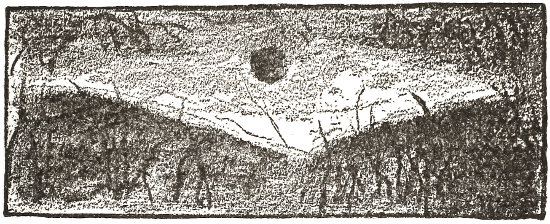
While the Garden Spiders are incomparable weavers, many other Spiders have even more ingenious devices for catching game. Some of them are real celebrities, who are mentioned in all the books.
Certain Bird Spiders, or American Tarantulas, live in a burrow like the Tarantula I have been telling you about, but their burrow is more perfect than hers. My Tarantula surrounds the mouth of her hole with a simple curb, a mere collection of tiny pebbles, sticks, and silk; the American ones fix a movable floor to theirs, a round shutter with a hinge, a groove, and a set of bolts. When one of these Tarantulas comes home, the lid drops into the groove and fits so exactly one cannot tell where it joins. If any one from outside tries to raise the trap-door, the Spider pushes the bolt,—that is to say, plants her claws into certain holes on the opposite side to the hinge,—props herself against the wall, and holds the door firmly.
Another, the Water Spider, builds herself an elegant silken diving-bell, in which she stores air. She waits in it for the coming of game and keeps cool meanwhile. On scorching hot days, hers must be a real palace of luxury, such as men have sometimes ventured to build under water, with mighty blocks of stone and marble. Tiberius, the wicked Roman Emperor, had such a submarine palace; but his is only a hateful memory, whereas the Water Spider’s dainty tower still flourishes.
If I had had the chance to observe these Spiders, I should gladly add a few unpublished facts to their life-history; but I must give up the idea. The Water Spider is not found in my district. The American Tarantula, the expert in hinged doors, I saw once only, by the side of a path. I was occupied with something else, and did not give it more than a passing glance. I have never seen it again.
But it is not only the uncommon insects that are worth attention. The common ones, if carefully observed, can tell us things just as important. I am interested in the Labyrinth Spider, which I find oftener than any other in the fields. Several times a week, in July, I go to study my Spiders on the spot, early in the morning, before the sun beats fiercely on one’s neck. The children come with me, each provided with an orange in case they get thirsty.
We soon discover high silk buildings, the threads beaded with dew and glittering in the sun. The children are wonderstruck at those glorious chandeliers, so that they even forget their oranges for a moment. I am not indifferent to them, either. Our Spider’s labyrinth is a splendid spectacle. That and the concert of the Thrushes are worth getting up for.
Half an hour’s heat, and the magic jewels disappear with the dew. Now is the time to look at the webs. Here is one spreading its sheet over a large cluster of rock-roses; it is the size of a handkerchief. Many guy-ropes moor it to the brushwood. It covers the bush like a piece of white muslin.
The web is flat at the edges and gradually hollows into a crater, not unlike the bell of a hunting-horn. At the center is a funnel whose neck, narrowing by degrees, is eight or nine inches deep and leads back into the leafy thicket.
At the entrance to the tube sits the Spider, who looks at us and shows no great excitement at our presence. She is gray, modestly adorned on the thorax with two black ribbons and on the abdomen with two stripes in which white specks alternate with brown. She has a sort of double tail at the end of her body, a rather curious feature in a Spider.
I expected to find, at the bottom of the Spider’s funnel, a wadded cell where she might rest in her hours of leisure. On the contrary, there is only a sort of door, which stands always ajar so that the Spider may escape at any time through the grass and gain the open.
Above, in the Spider’s web, there is a forest of ropes. It might be the rigging of a ship disabled by a storm. They run from every twig of the supporting boughs, they are fastened to the tip of every branch. There are long ropes and short ropes, upright and slanting, straight and bent, taut and slack, all criss-cross and a-tangle, to the height of three feet or so. The whole makes a chaos of netting, a real labyrinth which none but the very strongest insects can break through.
There is nothing like the sticky snare of the Garden Spiders here. The threads are not sticky, but they are very bewildering. See this small Locust who has lighted on the rigging. He is unable to get a steady foothold on that shaky support; he flounders about; and the more he struggles, the more he is entangled. The Spider, looking at him from her funnel, lets him have his way. She does not run up the ropes; she waits until the desperate prisoner in his struggles falls on the main part of the web.
Then she comes, flings herself upon her prey, and slowly drains his blood. The Locust is lifeless at the first bite; the Spider’s poison has settled him.
When laying-time is at hand, the Spider changes her residence; she leaves her web, which is still in excellent condition; she does not come back to it. The time has come to make the nest. But where? The Spider knows well; I am in the dark. I spend whole mornings ransacking the bushes, until at last I learn the secret. The nest is some distance away from the web, in a low, thick cluster of bushes; it is a clumsy bundle of dead leaves, roughly drawn together with silk threads. Under this rude covering is a pouch of fine texture containing the egg-casket.
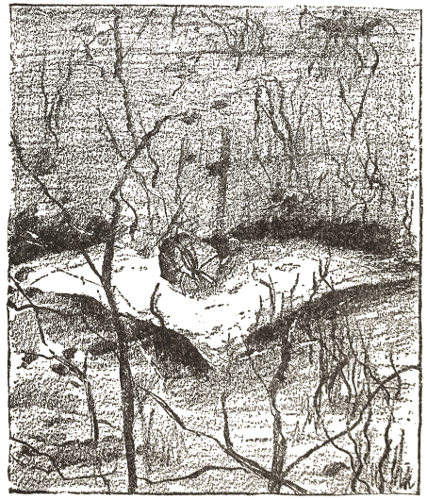
I am disappointed in the appearance of this Spider’s nest, until I remember that she probably cannot do better in the places where she builds. In the midst of a dense thicket, among a tangle of dead leaves and twigs, there is no room for an elegant piece of work. By way of experiment, I carry half a dozen Labyrinth Spiders into my laboratory near the laying-time, place them in large wire-gauze cages, standing in earthen pans filled with sand, with a sprig of thyme planted in the center to give a support for each nest. Now they will show what they can do.
The experiment works perfectly. By the end of August I have six nests, magnificent in shape and of a dazzling whiteness. The Spiders have had elbow-room, and they have done their best. The nests are ovals of exquisite white muslin, nearly as large as a Hen’s egg. They are open at either end. The front-entrance broadens into a gallery; the back-entrance tapers into a funnel-neck. It is somewhat the same construction as that of the Labyrinth web. Even the labyrinth is repeated, for in front of the bell-shaped mouth is a tangle of threads. The Spider has her pattern by heart, and uses it on all occasions.
This palace of silk is a guard-house. Behind the soft, milky, partly transparent wall glimmers the egg-casket, its shape vaguely suggesting the star of some order of knighthood. It is a large pocket, of a splendid dead-white, with pillars on every side which keep it motionless in the center of the nest. There are about ten of these pillars; they are slender in the middle and wider at both ends. They form corridors around the central room. The mother walks gravely to and fro under the arches of these corridors, which are like the cloisters of a nunnery; she stops first here, then there; she listens to all that happens inside the satin wrapper of her egg-wallet. I would not disturb her for anything; but I find, from nests I have picked up in the fields, that the purse contains about a hundred eggs, very pale amber-yellow beads.
When I remove the outer white-satin wall, I come upon a kernel of earthy matter, grains of sand mixed with the silk. However did they get there? Did they soak through the rain-water? No, the wrapper is spotless white outside. They have been put there by the mother herself. She has built around her eggs, to protect them from parasites, a wall composed of a great deal of sand and a little silk.
Inside this is still another silken wrapper, and then come the little Spiders, already hatched out and moving about in their nursery.
But, to go back—why does the mother leave her fine web when laying-time comes, and make her nest so far away? She has her reason, you may depend upon it. Her large net, like a sheet, with the labyrinth stretched above, is very conspicuous; parasites will not fail to come running at this signal, showing up against the green; if her nest is near, they will certainly find it; and a strange grub, feasting on a hundred new-laid eggs, will ruin her home. So the wise Labyrinth Spider shifts her quarters, and goes off at night to explore the neighborhood for a less dangerous retreat for her coming family. The low brambles dragging along the ground, keeping their leaves through the winter, and catching the dead leaves from the oaks hard by, or rosemary tufts, low and bushy, suit her perfectly. In such spots I usually find her nest.
Many Spiders leave their nests after they have laid the eggs, but the Labyrinth, like the Crab-spider, remains to watch over hers. She does not become thin and wither away, like the Crab-spider. She keeps her appetite, she is on the lookout for Locusts; and so she builds a hunting-box, a tangle of threads, on the outside of her nest.
When she is not hunting, as we have seen, she walks the corridors around her eggs, she listens to find out if all is well. If I shake the nest at any point with a straw, she quickly runs up to inquire what is happening. Probably she keeps off parasites in this way.
The Spider’s appetite for Locusts shows that she must have more to do. Insects, unlike some human beings, eat only that they may work. When I watch her, I find out what this work is. For nearly another month, I see her adding layer upon layer to the walls of her nest. These were at first semi-transparent; they become thick and opaque. This is why the Spider eats, so that she may fill her silk-glands and make a thick wrapper for her nest.
About the middle of September the little Spiders come out of their eggs, but they do not leave their house, where they are to spend the winter packed in soft wadding. The mother continues to watch and spin, but she grows less active from day to day. She eats fewer Locusts; she sometimes scorns those whom I myself entangle in her trap. But for four or five months longer she keeps on making her inspection-rounds of her egg-casket, happy at hearing the new-born Spiders swarming inside. At last, when October ends, she clutches her children’s nursery and dies. She has done all that a mother’s devotion can do; the special Providence that watches over tiny animals will do the rest. When spring comes, the youngsters will come out of their snug homes and scatter all over the neighborhood on their floating threads, like the little Crab-spiders you have read about.
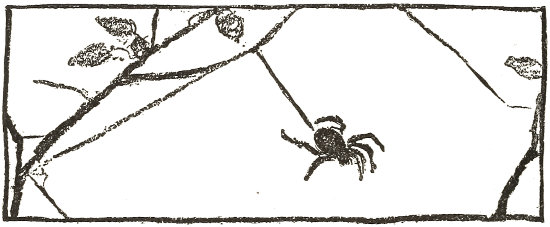
The smallest garden contains the Garden Spiders, all clever weavers.
Let us go every evening, step by step, from one border of tall rosemaries to the next. Should things move too slowly, we will sit down at the foot of the shrubs, where the light falls favorably, and watch with unwearying attention. Let us give ourselves a title, “Inspector of Spiders’ Webs!” There are not many people in that profession, and we shan’t make any money by it; but never mind, we shall learn some very interesting things.
The Spiders I watch are young ones, much slenderer than they will be in the late autumn. They work by day, work even in the sun, whereas the old ones weave only at night. Work starts in July, a couple of hours before sunset.
The spinstresses of my inclosures then leave their daytime hiding-places, choose their posts and begin to spin, one here, another there. There are many of them; we can choose where we please. Let us stop in front of this one, whom we surprise in the act of laying the foundations of her web. She runs about the rosemary hedge, from the tip of one branch to another, within the limits of some eighteen inches. Gradually, she puts a thread in position, drawing it from her body with the combs attached to her hind-legs. She comes and goes impetuously, as though at random; she goes up, comes down, goes up again, dives down again and each time strengthens the points of contact with threads distributed here and there. The result is a sort of frame. The shapeless structure is what she wishes; it marks out a flat, free, and perpendicular space. This is all that is necessary.
A special thread, the foundation of the stronger net which will be built later, is stretched across the area of the other. It can be told from the others by its isolation, its position at a distance from any twig that might interfere with its swaying length. It never fails to have, in the middle, a thick white point, formed of a little silk cushion.
The time has come to weave the hunting-snare. The Spider starts from the center, which bears the white signpost, and, running along the cross-thread, hurriedly reaches the circumference, that is to say, the irregular frame inclosing the free space. Still with the same sudden movement, she rushes from the outside to the center; she starts again backwards and forwards, makes for the right, the left, the top, the bottom; she hoists herself up, dives down, climbs up again, runs down and always returns to the central landmark by roads that slant in the most unexpected manner. Each time a radius or spoke is laid, here, there, or elsewhere, in what looks like mad disorder.
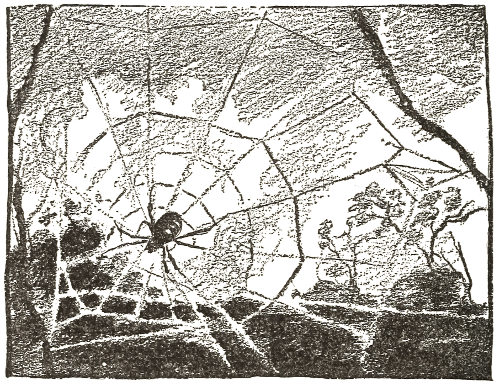
Any one looking at the finished web, so neat and regular in appearance, would think that the Spider laid the spokes in an orderly fashion, one after the other. She does nothing of the sort, but she knows what she is about, all the same. After setting a few spokes in one direction, the Spider runs across to the other side to draw some in the opposite direction. These sudden changes have a reason; they show us how clever the Spider is in her business. If she began by laying all the spokes on one side, she would pull the web out of shape or even destroy it. She must put some on the other side to balance. She is a past mistress of the secrets of rope-building, without serving an apprenticeship.
One would think that this interrupted and apparently disordered labor must result in a confused piece of work. Wrong: the rays are equidistant and form a beautifully regular circle. Their number is a characteristic mark of the different species. The Angular Epeira places twenty-one in her web, the Banded Epeira thirty-two, the Silky Epeira forty-two. These numbers are not absolutely fixed; but the variation is very slight.
Now which of us would undertake, offhand, without much preliminary experiment and without measuring-instruments, to divide a circle into a given quantity of sectors or parts of equal width? The Garden Spider, though weighted with a wallet and tottering on threads shaken by the wind, performs the delicate division without stopping to think. She achieves it by a method which seems mad according to our notions of geometry. Out of disorder she brings order. We are amazed at the result obtained. How does this Spider come to succeed with her difficult problem, so strangely managed? I am still asking myself the question.
The laying of the radii or spokes is finished. The Spider takes her place in the center, on the little cushion. Stationed on this support, she slowly turns round and round. She is engaged on a delicate piece of work. With an extremely thin thread, she describes from spoke to spoke, starting from the center, a spiral line with very close coils. This is the center of the web. I will call it the “resting-floor.”
The thread now becomes thicker. The first could hardly be seen; the second is plainly visible. The Spider shifts her position with great slanting strides, turns a few times, moving farther and farther from the center, fixes her line each time to the spoke which she crosses, and at last comes to a stop at the lower edge of the frame. She has described a spiral with coils of rapidly-increasing width. The average distance between the coils, even in the webs of the young Spiders, is about one third of an inch.
This spiral is not a curved line. All curves are banished from the Spiders’ work; nothing is used but the straight line and its combinations. This line forms the cross-bars, or supporting rungs, connecting the spokes, or radii.
All this is but a support for the snaring-web. Clinging on the one hand to the radii, on the other to the cross-bars, the Spider covers the same ground as when laying the first spiral, but in the opposite direction: formerly, she moved away from the center; now she moves towards it and with closer and more numerous circles. She starts from the end of the first spiral, near the outside of the web.
What follows is hard to observe, for the movements are very quick and jerky, consisting of a series of sudden little rushes, sways, and bends that bewilder the eye. The two hind-legs, the weaving implements, keep going constantly. One draws out the thread from the spinneret, and passes it to the other, which lays it on the radius. As soon as the radius is touched, the thread sticks to it by its own glue.
![[They] sign their
work by laying a broad white ribbon in a thick zigzag
from the center to the lower edge of the web](images/i_271.jpg)
The Spider, without a stop of any kind, turns and turns and turns, drawing nearer to the center and always fixing her thread at each spoke which she crosses. At last, at some distance from the center, on the edge of what I have called the resting-floor, the Spider suddenly ends her spiral. She next eats the little cushion in the center, which is a mat of ends of saved silk. She does this to economize silk, for after she has eaten it the cushion will be turned into silk for the next web she spins.
Two Spiders, the Banded and the Silky, sign their work by laying a broad white ribbon in a thick zigzag from the center to the lower edge of the web. Sometimes they put a second band of the same shape, but a little shorter, opposite the first, on the upper part of the web.
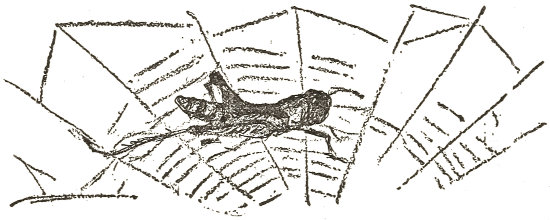
The spiral part of the Garden Spider’s web is a wonderful contrivance. The thread that forms it may be seen with the naked eye to be different from that of the framework and the spokes. It glitters in the sun, and looks as though it were knotted. I cannot examine it through the microscope outdoors because the web shakes so, but by passing a sheet of glass under the web and lifting it I can take away a few pieces of thread to study. The microscope now shows me an astounding sight.
Those threads, so slender as to be almost invisible, are very closely twisted twine, something like the gold cord of officers’ sword-knots. Moreover, they are hollow. They contain a sticky moisture resembling a strong solution of gum arabic. I can see it trickling from the broken ends. This moisture must ooze through the threads, making them sticky. Indeed, they are sticky. When I lay a straw flat upon them, it adheres at once. We see now that the Garden Spider hunts, not with springs, but with sticky snares that catch everything, down to the dandelion-plume that barely brushes against the web. Nevertheless, the Spider herself is not caught in her own snare. Why?
For one thing, she spends most of her time on her resting-floor in the middle of the web, which the spiral does not enter. The resting-floor is not at all sticky, as I find when I pass a straw against it. But sometimes when a victim is caught, perhaps right at the end of the web, the Spider has to rush up quickly to bind it and overcome its attempts to free itself. She seems to be able to walk upon her network perfectly well then. Has she something on her feet which makes them slip over the glue? Has she perhaps oiled them? Oil, you know, is the best thing to prevent surfaces from sticking.
I pull out the leg of a live Spider and put it to soak for an hour in disulphide of carbon, which dissolves fat. I wash it carefully with a brush dipped in the same fluid. When the washing is finished, the leg sticks to the spiral of the web! We see now that the Spider varnishes herself with a special sweat so that she can go on any part of her web without difficulty. However, she does not wish to remain on the spiral too long, or the oil might wear away, so most of the time she stays on her safe resting-floor.
This spiral thread of the Spider’s is very quick to absorb moisture, as I find out by experiment. For this reason the Garden Spiders, when they weave their webs in the early morning, leave that part of the work unfinished, if the air turns misty. They build the general framework, they lay the spokes, they make the resting-floor, for all these parts are not affected by excess moisture; but they are very careful not to work at the sticky spiral, which, if soaked by the fog, would dissolve into sticky threads and lose its usefulness by being wet. The net that was started will be finished to-morrow, if the weather is right. But on hot days this property of the spiral is a fine thing; it does not dry up, but absorbs all the moisture in the atmosphere and remains, at the most scorching times of day, supple, elastic, and more and more sticky. What bird-catcher could compete with the Garden Spider in the art of laying snares? And all this industry and cunning for the capture of a Moth!
Then, too, what a passion the Spider has for production. I calculated that, in one sitting, each time that she remakes her web, the Angular Spider produces some twenty yards of gummy thread. The more skillful Silky Spider produces thirty. Well, during two months, the Angular Spider, my neighbor, renewed her snare nearly every evening. During that time she manufactured something like three quarters of a mile of this tubular thread, rolled into a tight twist and bulging with glue.
We cannot but wonder how she ever carries so much in her little body, how she manages to twist her silk into this tube, how she fills it with glue! And how does she first turn out plain threads, then russet foam, for her nest, then black stripes to adorn the nest? I see the results, but I cannot understand the working of her factory.
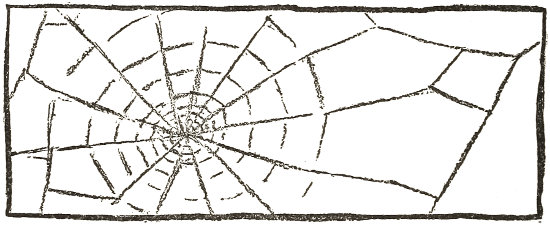
[This chapter, one of the most wonderful in Fabre’s books, is included in a simplified form in this volume, on account of its interest to such younger readers as have studied geometry.]
When we look at the webs of the Garden Spiders, especially those of the Silky Spider and the Banded Spider, we notice first that the spokes or radii are equally spaced; the angles formed by each consecutive pair are of the same value; and this in spite of their number, which in the webs of the Silky Spider sometimes exceeds forty. We know in what a strange way the Spider weaves her web and divides the area of the web into a large number of equal parts or sectors, a number which is almost always the same in the work of each species of Spider. The Spider darts here and there when laying her spokes as if she had no plan, and this irresponsible way of working produces a beautiful web like the rose-window in a church, a web which no designer could have drawn better with compasses.
We shall also notice that, in each sector, the various chords, parts of the angular spiral, are parallel to one another and gradually draw closer together as they near the center. With the two radiating lines that frame them they form obtuse angles on one side and acute angles on the other; and these angles remain constant in the same sector, because the chords are parallel.
There is more than this: these same angles, the obtuse as well as the acute, do not alter in value, from one sector to another, as far as the eye can judge. Taken as a whole, therefore, the spiral consists of a series of cross-bars intersecting the several radiating lines obliquely at angles of equal value.
By this characteristic we recognize what geometricians have named the “logarithmic spiral.” It is famous in science. The logarithmic spiral describes an endless number of circuits around its pole, to which it constantly draws nearer without ever being able to reach it. We could not see such a line, the whole of it, even with our best philosophical instruments. It exists only in the imagination of scientists. But the Spider knows it, and winds her spiral in the same way, and very accurately at that.
Another property of this spiral is that if one in imagination winds a flexible thread around it, then unwinds the thread, keeping it taut the while, its free end will describe a spiral similar at all points to the original. The curve will merely have changed places. Jacques Bernouilli, the professor of mathematics who discovered this magnificent theorem, had engraved on his tomb, as one of his proudest titles to fame, the spiral and its double, made by the unwinding of the thread. Written underneath it was the sentence: Eadem mutata resurgo. “I rise again like unto myself.” It was a splendid flight of fancy which showed his belief in immortality.
Now is this logarithmic spiral, with its curious properties, merely an idea of the geometricians? Is it a mere dream, an abstract riddle?
No, it is a reality in the service of life, a method of construction often employed by animals in their architecture. The Mollusk never makes its shell without reference to the scientific curve. The first-born of the species knew it and put it into practice; it was as perfect in the dawn of creation as it can be to-day.
There are perfect examples of this spiral found in the shells of fossils. To this day, the last representative of an ancient tribe, the Nautilus of the Southern Seas, remains faithful to the old design, and still whirls its spiral logarithmically, as did its ancestors in the earliest ages of the world’s existence. Even in the stagnant waters of our grassy ditches, a tiny Shellfish, no bigger than a duckweed, rolls its shell in the same manner. The common snail-shell is constructed according to logarithmic laws.
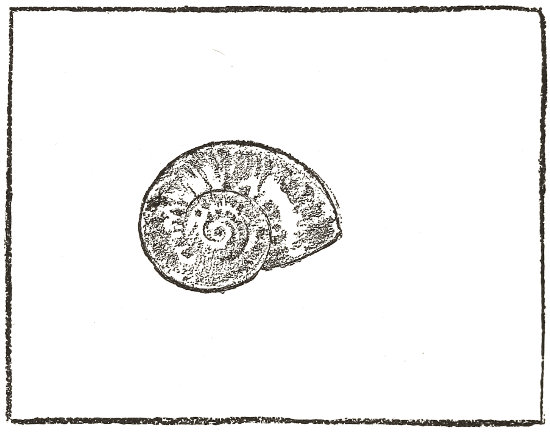
Where do these creatures pick up this science? We are told that the Mollusk is descended from the Worm. One day the Worm, rendered frisky by the sun, brandished its tail and twisted it into a corkscrew for sheer glee. There and then the plan of the future spiral shell was discovered.
This is what is taught quite seriously, in these days, as the very last word in science. But the Spider will have none of this theory. For she is not related to the Worm; and yet she is familiar with the logarithmic spiral and uses it in her web, in a simpler form. The Mollusk has years in which to build her spiral, so she makes it very perfectly. The Spider has only an hour at the most to spread her net, so she makes only a skeleton of the curve; but she knows the same line dear to the Snail. What guides her? Nothing but an inborn skill, whose effects the animal is no more able to control than the flower is able to control the arrangement of its petals and stamens. The Spider practices higher geometry without knowing or caring. The thing works of itself and takes its way from an instinct imposed upon creation at the start.
The stone thrown by the hand returns to earth describing a certain curve; the dead leaf torn and wafted away by a breath of wind makes its journey from the tree to the ground with a similar curve. The curve is known to science and is called the “parabola.”
The geometricians speculate still more about this curve; they imagine it rolling on an indefinite straight line and ask what course the focus of the curve follows. The answer comes that the focus of the parabola describes a “catenary,” a line whose algebraic symbol is so complicated that a numeral will not express it. The nearest it can get is this terrible sum:

[text]
The geometricians do not attempt to refer to it by this number; they give it a letter, e.
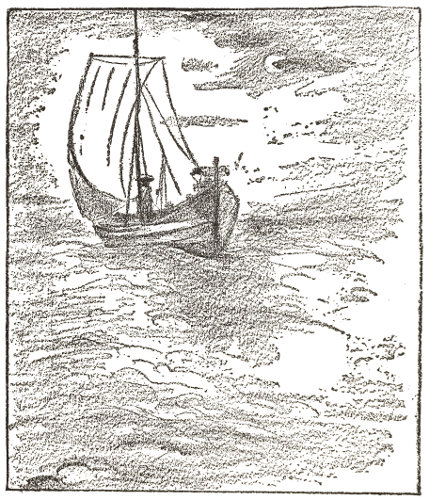
Is this line imaginary? Not at all; you may see the catenary frequently. It is the shape taken by a flexible cord when held at each end and relaxed; it is the line that governs the shape of a sail filled out by the wind. All this answers to the number e.
What a quantity of abstruse science for a bit of string! Let us not be surprised. A pellet of shot swinging at the end of a thread, a drop of dew trickling down a straw, a splash of water rippling under the kisses of the air, a mere trifle, after all, becomes tremendously complicated when we wish to examine it with the eye of calculation. We need the club of Hercules to crush a fly.
Our methods of mathematical investigation are certainly ingenious; we cannot too much admire the mighty brains that have invented them; but how slow and laborious they seem when compared with the smallest actual things! Shall we never be able to inquire into reality in a simpler fashion? Shall we be intelligent enough some day to do without all these heavy formulæ? Why not?
Here we have the magic number e reappearing, written on a Spider’s thread. On a misty morning the sticky threads are laden with tiny drops, and, bending under the burden, have become so many catenaries, so many chains of limpid gems, graceful chaplets arranged in exquisite order and following the curve of a swing. If the sun pierce the mist, the whole lights up with rainbow-colored fires and becomes a dazzling cluster of diamonds. The number e is in its glory.
Geometry, that is to say, the science of harmony in space, rules over everything. We find it in the arrangement of the scales of a fir-cone, as in the arrangement of a Spider’s sticky snare; we find it in the spiral of a snail-shell, in the chaplet of a Spider’s thread, as in the orbit of a planet; it is everywhere, as perfect in the world of atoms as in the world of immensities.
And this universal geometry tells us of a Universal Geometrician, whose divine compass has measured all things. I prefer that, as an explanation of the logarithmic curve of the Nautilus and the Garden Spiders, to the Worm screwing up the tip of its tail. It may not perhaps be in agreement with some latter-day teaching, but it takes a loftier flight.
Variant spelling and hyphenation have been preserved as printed; simple typographical errors have been corrected.
In the Table of Contents, the printed page numbers were all off by 10: page 7 should read page 17, page 21 should read page 31, and so on. The page numbers have been updated for the plain text version of this book. (The HTML and e-reader versions do not use page references in the ToC.)
The following changes were also made:
All changes are also noted in the source code: search <!--TN:
Text of the terrible sum:
1 + 1/1 + 1/(1.2) + 1/(1.2.3) + 1/(1.2.3.4) + 1/(1.2.3.4.5) + etc.
End of the Project Gutenberg EBook of Insect Adventures, by
J. Henri Fabre and Louise Seymour Hasbrouck
*** END OF THIS PROJECT GUTENBERG EBOOK INSECT ADVENTURES ***
***** This file should be named 45812-h.htm or 45812-h.zip *****
This and all associated files of various formats will be found in:
http://www.gutenberg.org/4/5/8/1/45812/
Produced by Chris Curnow, Jennifer Linklater and the Online
Distributed Proofreading Team at http://www.pgdp.net (This
file was produced from images generously made available
by The Internet Archive)
Updated editions will replace the previous one--the old editions
will be renamed.
Creating the works from public domain print editions means that no
one owns a United States copyright in these works, so the Foundation
(and you!) can copy and distribute it in the United States without
permission and without paying copyright royalties. Special rules,
set forth in the General Terms of Use part of this license, apply to
copying and distributing Project Gutenberg-tm electronic works to
protect the PROJECT GUTENBERG-tm concept and trademark. Project
Gutenberg is a registered trademark, and may not be used if you
charge for the eBooks, unless you receive specific permission. If you
do not charge anything for copies of this eBook, complying with the
rules is very easy. You may use this eBook for nearly any purpose
such as creation of derivative works, reports, performances and
research. They may be modified and printed and given away--you may do
practically ANYTHING with public domain eBooks. Redistribution is
subject to the trademark license, especially commercial
redistribution.
*** START: FULL LICENSE ***
THE FULL PROJECT GUTENBERG LICENSE
PLEASE READ THIS BEFORE YOU DISTRIBUTE OR USE THIS WORK
To protect the Project Gutenberg-tm mission of promoting the free
distribution of electronic works, by using or distributing this work
(or any other work associated in any way with the phrase "Project
Gutenberg"), you agree to comply with all the terms of the Full Project
Gutenberg-tm License available with this file or online at
www.gutenberg.org/license.
Section 1. General Terms of Use and Redistributing Project Gutenberg-tm
electronic works
1.A. By reading or using any part of this Project Gutenberg-tm
electronic work, you indicate that you have read, understand, agree to
and accept all the terms of this license and intellectual property
(trademark/copyright) agreement. If you do not agree to abide by all
the terms of this agreement, you must cease using and return or destroy
all copies of Project Gutenberg-tm electronic works in your possession.
If you paid a fee for obtaining a copy of or access to a Project
Gutenberg-tm electronic work and you do not agree to be bound by the
terms of this agreement, you may obtain a refund from the person or
entity to whom you paid the fee as set forth in paragraph 1.E.8.
1.B. "Project Gutenberg" is a registered trademark. It may only be
used on or associated in any way with an electronic work by people who
agree to be bound by the terms of this agreement. There are a few
things that you can do with most Project Gutenberg-tm electronic works
even without complying with the full terms of this agreement. See
paragraph 1.C below. There are a lot of things you can do with Project
Gutenberg-tm electronic works if you follow the terms of this agreement
and help preserve free future access to Project Gutenberg-tm electronic
works. See paragraph 1.E below.
1.C. The Project Gutenberg Literary Archive Foundation ("the Foundation"
or PGLAF), owns a compilation copyright in the collection of Project
Gutenberg-tm electronic works. Nearly all the individual works in the
collection are in the public domain in the United States. If an
individual work is in the public domain in the United States and you are
located in the United States, we do not claim a right to prevent you from
copying, distributing, performing, displaying or creating derivative
works based on the work as long as all references to Project Gutenberg
are removed. Of course, we hope that you will support the Project
Gutenberg-tm mission of promoting free access to electronic works by
freely sharing Project Gutenberg-tm works in compliance with the terms of
this agreement for keeping the Project Gutenberg-tm name associated with
the work. You can easily comply with the terms of this agreement by
keeping this work in the same format with its attached full Project
Gutenberg-tm License when you share it without charge with others.
1.D. The copyright laws of the place where you are located also govern
what you can do with this work. Copyright laws in most countries are in
a constant state of change. If you are outside the United States, check
the laws of your country in addition to the terms of this agreement
before downloading, copying, displaying, performing, distributing or
creating derivative works based on this work or any other Project
Gutenberg-tm work. The Foundation makes no representations concerning
the copyright status of any work in any country outside the United
States.
1.E. Unless you have removed all references to Project Gutenberg:
1.E.1. The following sentence, with active links to, or other immediate
access to, the full Project Gutenberg-tm License must appear prominently
whenever any copy of a Project Gutenberg-tm work (any work on which the
phrase "Project Gutenberg" appears, or with which the phrase "Project
Gutenberg" is associated) is accessed, displayed, performed, viewed,
copied or distributed:
This eBook is for the use of anyone anywhere at no cost and with
almost no restrictions whatsoever. You may copy it, give it away or
re-use it under the terms of the Project Gutenberg License included
with this eBook or online at www.gutenberg.org
1.E.2. If an individual Project Gutenberg-tm electronic work is derived
from the public domain (does not contain a notice indicating that it is
posted with permission of the copyright holder), the work can be copied
and distributed to anyone in the United States without paying any fees
or charges. If you are redistributing or providing access to a work
with the phrase "Project Gutenberg" associated with or appearing on the
work, you must comply either with the requirements of paragraphs 1.E.1
through 1.E.7 or obtain permission for the use of the work and the
Project Gutenberg-tm trademark as set forth in paragraphs 1.E.8 or
1.E.9.
1.E.3. If an individual Project Gutenberg-tm electronic work is posted
with the permission of the copyright holder, your use and distribution
must comply with both paragraphs 1.E.1 through 1.E.7 and any additional
terms imposed by the copyright holder. Additional terms will be linked
to the Project Gutenberg-tm License for all works posted with the
permission of the copyright holder found at the beginning of this work.
1.E.4. Do not unlink or detach or remove the full Project Gutenberg-tm
License terms from this work, or any files containing a part of this
work or any other work associated with Project Gutenberg-tm.
1.E.5. Do not copy, display, perform, distribute or redistribute this
electronic work, or any part of this electronic work, without
prominently displaying the sentence set forth in paragraph 1.E.1 with
active links or immediate access to the full terms of the Project
Gutenberg-tm License.
1.E.6. You may convert to and distribute this work in any binary,
compressed, marked up, nonproprietary or proprietary form, including any
word processing or hypertext form. However, if you provide access to or
distribute copies of a Project Gutenberg-tm work in a format other than
"Plain Vanilla ASCII" or other format used in the official version
posted on the official Project Gutenberg-tm web site (www.gutenberg.org),
you must, at no additional cost, fee or expense to the user, provide a
copy, a means of exporting a copy, or a means of obtaining a copy upon
request, of the work in its original "Plain Vanilla ASCII" or other
form. Any alternate format must include the full Project Gutenberg-tm
License as specified in paragraph 1.E.1.
1.E.7. Do not charge a fee for access to, viewing, displaying,
performing, copying or distributing any Project Gutenberg-tm works
unless you comply with paragraph 1.E.8 or 1.E.9.
1.E.8. You may charge a reasonable fee for copies of or providing
access to or distributing Project Gutenberg-tm electronic works provided
that
- You pay a royalty fee of 20% of the gross profits you derive from
the use of Project Gutenberg-tm works calculated using the method
you already use to calculate your applicable taxes. The fee is
owed to the owner of the Project Gutenberg-tm trademark, but he
has agreed to donate royalties under this paragraph to the
Project Gutenberg Literary Archive Foundation. Royalty payments
must be paid within 60 days following each date on which you
prepare (or are legally required to prepare) your periodic tax
returns. Royalty payments should be clearly marked as such and
sent to the Project Gutenberg Literary Archive Foundation at the
address specified in Section 4, "Information about donations to
the Project Gutenberg Literary Archive Foundation."
- You provide a full refund of any money paid by a user who notifies
you in writing (or by e-mail) within 30 days of receipt that s/he
does not agree to the terms of the full Project Gutenberg-tm
License. You must require such a user to return or
destroy all copies of the works possessed in a physical medium
and discontinue all use of and all access to other copies of
Project Gutenberg-tm works.
- You provide, in accordance with paragraph 1.F.3, a full refund of any
money paid for a work or a replacement copy, if a defect in the
electronic work is discovered and reported to you within 90 days
of receipt of the work.
- You comply with all other terms of this agreement for free
distribution of Project Gutenberg-tm works.
1.E.9. If you wish to charge a fee or distribute a Project Gutenberg-tm
electronic work or group of works on different terms than are set
forth in this agreement, you must obtain permission in writing from
both the Project Gutenberg Literary Archive Foundation and Michael
Hart, the owner of the Project Gutenberg-tm trademark. Contact the
Foundation as set forth in Section 3 below.
1.F.
1.F.1. Project Gutenberg volunteers and employees expend considerable
effort to identify, do copyright research on, transcribe and proofread
public domain works in creating the Project Gutenberg-tm
collection. Despite these efforts, Project Gutenberg-tm electronic
works, and the medium on which they may be stored, may contain
"Defects," such as, but not limited to, incomplete, inaccurate or
corrupt data, transcription errors, a copyright or other intellectual
property infringement, a defective or damaged disk or other medium, a
computer virus, or computer codes that damage or cannot be read by
your equipment.
1.F.2. LIMITED WARRANTY, DISCLAIMER OF DAMAGES - Except for the "Right
of Replacement or Refund" described in paragraph 1.F.3, the Project
Gutenberg Literary Archive Foundation, the owner of the Project
Gutenberg-tm trademark, and any other party distributing a Project
Gutenberg-tm electronic work under this agreement, disclaim all
liability to you for damages, costs and expenses, including legal
fees. YOU AGREE THAT YOU HAVE NO REMEDIES FOR NEGLIGENCE, STRICT
LIABILITY, BREACH OF WARRANTY OR BREACH OF CONTRACT EXCEPT THOSE
PROVIDED IN PARAGRAPH 1.F.3. YOU AGREE THAT THE FOUNDATION, THE
TRADEMARK OWNER, AND ANY DISTRIBUTOR UNDER THIS AGREEMENT WILL NOT BE
LIABLE TO YOU FOR ACTUAL, DIRECT, INDIRECT, CONSEQUENTIAL, PUNITIVE OR
INCIDENTAL DAMAGES EVEN IF YOU GIVE NOTICE OF THE POSSIBILITY OF SUCH
DAMAGE.
1.F.3. LIMITED RIGHT OF REPLACEMENT OR REFUND - If you discover a
defect in this electronic work within 90 days of receiving it, you can
receive a refund of the money (if any) you paid for it by sending a
written explanation to the person you received the work from. If you
received the work on a physical medium, you must return the medium with
your written explanation. The person or entity that provided you with
the defective work may elect to provide a replacement copy in lieu of a
refund. If you received the work electronically, the person or entity
providing it to you may choose to give you a second opportunity to
receive the work electronically in lieu of a refund. If the second copy
is also defective, you may demand a refund in writing without further
opportunities to fix the problem.
1.F.4. Except for the limited right of replacement or refund set forth
in paragraph 1.F.3, this work is provided to you 'AS-IS', WITH NO OTHER
WARRANTIES OF ANY KIND, EXPRESS OR IMPLIED, INCLUDING BUT NOT LIMITED TO
WARRANTIES OF MERCHANTABILITY OR FITNESS FOR ANY PURPOSE.
1.F.5. Some states do not allow disclaimers of certain implied
warranties or the exclusion or limitation of certain types of damages.
If any disclaimer or limitation set forth in this agreement violates the
law of the state applicable to this agreement, the agreement shall be
interpreted to make the maximum disclaimer or limitation permitted by
the applicable state law. The invalidity or unenforceability of any
provision of this agreement shall not void the remaining provisions.
1.F.6. INDEMNITY - You agree to indemnify and hold the Foundation, the
trademark owner, any agent or employee of the Foundation, anyone
providing copies of Project Gutenberg-tm electronic works in accordance
with this agreement, and any volunteers associated with the production,
promotion and distribution of Project Gutenberg-tm electronic works,
harmless from all liability, costs and expenses, including legal fees,
that arise directly or indirectly from any of the following which you do
or cause to occur: (a) distribution of this or any Project Gutenberg-tm
work, (b) alteration, modification, or additions or deletions to any
Project Gutenberg-tm work, and (c) any Defect you cause.
Section 2. Information about the Mission of Project Gutenberg-tm
Project Gutenberg-tm is synonymous with the free distribution of
electronic works in formats readable by the widest variety of computers
including obsolete, old, middle-aged and new computers. It exists
because of the efforts of hundreds of volunteers and donations from
people in all walks of life.
Volunteers and financial support to provide volunteers with the
assistance they need are critical to reaching Project Gutenberg-tm's
goals and ensuring that the Project Gutenberg-tm collection will
remain freely available for generations to come. In 2001, the Project
Gutenberg Literary Archive Foundation was created to provide a secure
and permanent future for Project Gutenberg-tm and future generations.
To learn more about the Project Gutenberg Literary Archive Foundation
and how your efforts and donations can help, see Sections 3 and 4
and the Foundation information page at www.gutenberg.org
Section 3. Information about the Project Gutenberg Literary Archive
Foundation
The Project Gutenberg Literary Archive Foundation is a non profit
501(c)(3) educational corporation organized under the laws of the
state of Mississippi and granted tax exempt status by the Internal
Revenue Service. The Foundation's EIN or federal tax identification
number is 64-6221541. Contributions to the Project Gutenberg
Literary Archive Foundation are tax deductible to the full extent
permitted by U.S. federal laws and your state's laws.
The Foundation's principal office is located at 4557 Melan Dr. S.
Fairbanks, AK, 99712., but its volunteers and employees are scattered
throughout numerous locations. Its business office is located at 809
North 1500 West, Salt Lake City, UT 84116, (801) 596-1887. Email
contact links and up to date contact information can be found at the
Foundation's web site and official page at www.gutenberg.org/contact
For additional contact information:
Dr. Gregory B. Newby
Chief Executive and Director
gbnewby@pglaf.org
Section 4. Information about Donations to the Project Gutenberg
Literary Archive Foundation
Project Gutenberg-tm depends upon and cannot survive without wide
spread public support and donations to carry out its mission of
increasing the number of public domain and licensed works that can be
freely distributed in machine readable form accessible by the widest
array of equipment including outdated equipment. Many small donations
($1 to $5,000) are particularly important to maintaining tax exempt
status with the IRS.
The Foundation is committed to complying with the laws regulating
charities and charitable donations in all 50 states of the United
States. Compliance requirements are not uniform and it takes a
considerable effort, much paperwork and many fees to meet and keep up
with these requirements. We do not solicit donations in locations
where we have not received written confirmation of compliance. To
SEND DONATIONS or determine the status of compliance for any
particular state visit www.gutenberg.org/donate
While we cannot and do not solicit contributions from states where we
have not met the solicitation requirements, we know of no prohibition
against accepting unsolicited donations from donors in such states who
approach us with offers to donate.
International donations are gratefully accepted, but we cannot make
any statements concerning tax treatment of donations received from
outside the United States. U.S. laws alone swamp our small staff.
Please check the Project Gutenberg Web pages for current donation
methods and addresses. Donations are accepted in a number of other
ways including checks, online payments and credit card donations.
To donate, please visit: www.gutenberg.org/donate
Section 5. General Information About Project Gutenberg-tm electronic
works.
Professor Michael S. Hart was the originator of the Project Gutenberg-tm
concept of a library of electronic works that could be freely shared
with anyone. For forty years, he produced and distributed Project
Gutenberg-tm eBooks with only a loose network of volunteer support.
Project Gutenberg-tm eBooks are often created from several printed
editions, all of which are confirmed as Public Domain in the U.S.
unless a copyright notice is included. Thus, we do not necessarily
keep eBooks in compliance with any particular paper edition.
Most people start at our Web site which has the main PG search facility:
www.gutenberg.org
This Web site includes information about Project Gutenberg-tm,
including how to make donations to the Project Gutenberg Literary
Archive Foundation, how to help produce our new eBooks, and how to
subscribe to our email newsletter to hear about new eBooks.